
マルチン・ルター
Martin Luther, 1483-1546

Lucas
Cranach d.Ä. - Martin Luther, 1528
☆ マルティン・ルターOSA(1483年11月10日 - 1546年2月18日)はドイツの司祭、神学者、作家、賛美歌作者、教授、アウグスティヌス修道士。 [プロテスタント宗教改革の中心的人物であり、彼の神学的信念はルター派の基礎を形成している。 ルターは1507年に司祭に叙階された。彼はローマ・カトリック教会のいくつかの教えや慣習を否定するようになり、特に免罪符に関する見解に異論を唱え た。ルターは1517年の「95ヶ条の論題」の中で、免罪符の実践と効力について学術的な議論を提案した。1520年の教皇レオ10世と1521年のヴォ ルムス会議での神聖ローマ皇帝シャルル5世の要求に応じて、すべての著作を放棄することを拒否した結果、教皇から破門され、神聖ローマ皇帝からは無法者と して断罪された。ルターは1546年、ローマ教皇レオ10世の破門を受けたままこの世を去った。 ルターは、救い、ひいては永遠の命は善行によって得られるものではなく、むしろ、罪からの贖い主であるイエス・キリストを信じる信仰を通して、神の恵みの 無償の賜物としてのみ与えられるものだと説いた。ルターの神学は、聖書が神によって啓示された知識の唯一の源であることを教えることによって教皇の権威と 権能に異議を唱え、洗礼を受けたすべてのクリスチャンを聖なる神権であると考えることによって聖職者主義に反対した。ルターは、キリストを公 言する個人の唯一の名前として、クリスチャンまたは福音主義者(ドイツ語:evangelisch)を主張したが、これらルターの広範な教えのすべてに同 調する人々はルター派と呼ばれる。ルターが聖書をラテン語ではなくドイツ語の方言に翻訳したことで、一般の人々も聖書に親しむことができるようになった。 彼の賛美歌は、プロテスタント教会における歌唱の発展に影響を与えた。 元修道女カタリーナ・フォン・ボラとの結婚は、プロテスタントの聖職者の結婚を認め、聖職者結婚の実践のモデルとなった。 ルターは晩年の2つの著作で反ユダヤ主義的な見解を表明し、ユダヤ人の追放とシナゴーグの焼き討ちを呼びかけた。 ルターはユダヤ人の殺害を提唱していなかったにもかかわらず、彼の教えに基づき、彼のレトリックがドイツにおける反ユダ ヤ主義とナチス党の発展に大きく貢献したというのが歴史家の間での一般的な見解である。
| Martin Luther OSA
(/ˈluːθər/;[1] German: [ˈmaʁtiːn ˈlʊtɐ] ⓘ; 10 November 1483[2] – 18
February 1546) was a German priest, theologian, author, hymnwriter,
professor, and Augustinian friar.[3] He was the seminal figure of the
Protestant Reformation, and his theological beliefs form the basis of
Lutheranism. Luther was ordained to the priesthood in 1507. He came to reject several teachings and practices of the Roman Catholic Church; in particular, he disputed the view on indulgences. Luther proposed an academic discussion of the practice and efficacy of indulgences in his Ninety-five Theses of 1517. His refusal to renounce all of his writings at the demand of Pope Leo X in 1520 and the Holy Roman Emperor Charles V at the Diet of Worms in 1521 resulted in his excommunication by the pope and condemnation as an outlaw by the Holy Roman Emperor. Luther died in 1546 with Pope Leo X's excommunication still in effect. Luther taught that salvation and, consequently, eternal life are not earned by good deeds; rather, they are received only as the free gift of God's grace through the believer's faith in Jesus Christ, the redeemer from sin. His theology challenged the authority and office of the pope by teaching that the Bible is the only source of divinely revealed knowledge,[4] and opposed sacerdotalism by considering all baptized Christians to be a holy priesthood.[5] Those who identify with these, and all of Luther's wider teachings, are called Lutherans, though Luther insisted on Christian or Evangelic (German: evangelisch) as the only acceptable names for individuals who professed Christ. His translation of the Bible into the German vernacular (instead of Latin) made it more accessible to the laity, an event that had a tremendous impact on both the church and German culture. It fostered the development of a standard version of the German language, added several principles to the art of translation,[6] and influenced the writing of an English translation, the Tyndale Bible.[7] His hymns influenced the development of singing in Protestant churches.[8] His marriage to Katharina von Bora, a former nun, set a model for the practice of clerical marriage, allowing Protestant clergy to marry.[9] In two of his later works, Luther expressed anti-Judaistic views, calling for the expulsion of Jews and the burning of synagogues.[10] In addition, these works also targeted Roman Catholics, Anabaptists, and nontrinitarian Christians.[11] Based upon his teachings, despite the fact that Luther did not advocate the murdering of Jews,[12][13][14] the prevailing view among historians is that his rhetoric contributed significantly to the development of antisemitism in Germany and of the Nazi Party.[15][16][17] |
マルティン・ルターOSA(1483年11月10日 -
1546年2月18日)はドイツの司祭、神学者、作家、賛美歌作者、教授、アウグスティヌス修道士。
[プロテスタント宗教改革の中心的人物であり、彼の神学的信念はルター派の基礎を形成している。 ルターは1507年に司祭に叙階された。彼はローマ・カトリック教会のいくつかの教えや慣習を否定するようになり、特に免罪符に関する見解に異論を唱え た。ルターは1517年の「95ヶ条の論題」の中で、免罪符の実践と効力について学術的な議論を提案した。1520年の教皇レオ10世と1521年のヴォ ルムス会議での神聖ローマ皇帝シャルル5世の要求に応じて、すべての著作を放棄することを拒否した結果、教皇から破門され、神聖ローマ皇帝からは無法者と して断罪された。ルターは1546年、ローマ教皇レオ10世の破門を受けたままこの世を去った。 ルターは、救い、ひいては永遠の命は善行によって得られるものではなく、むしろ、罪からの贖い主であるイエス・キリストを信じる信仰を通して、神の恵みの 無償の賜物としてのみ与えられるものだと説いた。ルターの神学は、聖書が神によって啓示された知識の唯一の源であることを教えることによって教皇の権威と 権能に異議を唱え[4]、洗礼を受けたすべてのクリスチャンを聖なる神権であると考えることによって聖職者主義に反対した[5]。ルターは、キリストを公 言する個人の唯一の名前として、クリスチャンまたは福音主義者(ドイツ語:evangelisch)を主張したが、これらルターの広範な教えのすべてに同 調する人々はルター派と呼ばれる。ルターが聖書をラテン語ではなくドイツ語の方言に翻訳したことで、一般の人々も聖書に親しむことができるようになった。 彼の賛美歌は、プロテスタント教会における歌唱の発展に影響を与えた[8]。 元修道女カタリーナ・フォン・ボラとの結婚は、プロテスタントの聖職者の結婚を認め、聖職者結婚の実践のモデルとなった[9]。 ルターは晩年の2つの著作で反ユダヤ主義的な見解を表明し、ユダヤ人の追放とシナゴーグの焼き討ちを呼びかけた[10]。 [11]ルターはユダヤ人の殺害を提唱していなかったにもかかわらず、彼の教えに基づき[12][13][14]、彼のレトリックがドイツにおける反ユダ ヤ主義とナチス党の発展に大きく貢献したというのが歴史家の間での一般的な見解である[15][16][17]。 |
| Early life Birth and education 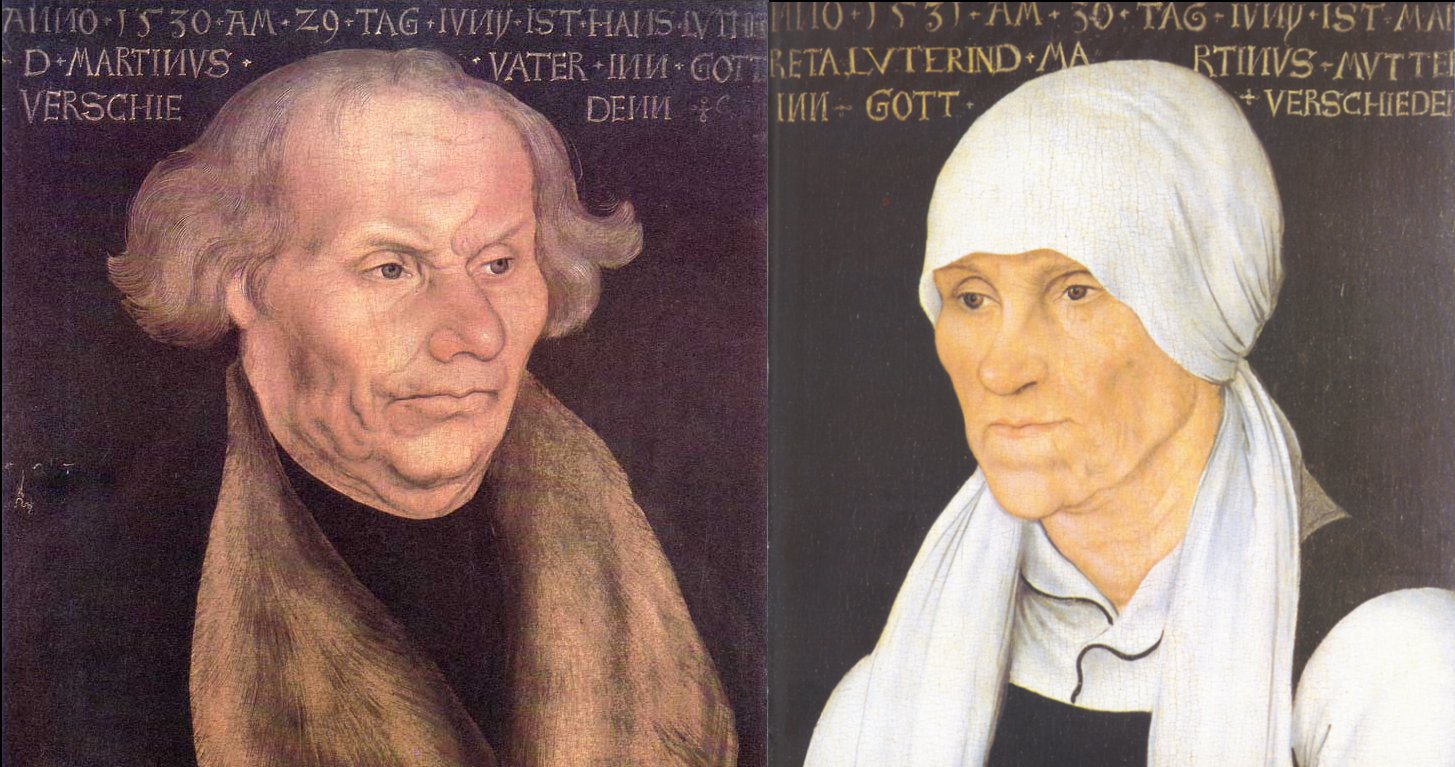 Portraits of Hans and Margarethe Luther by Lucas Cranach the Elder, 1527  Former monks' dormitory, St Augustine's Monastery, Erfurt Martin Luther was born to Hans Luder (or Ludher, later Luther)[18] and his wife Margarethe (née Lindemann) on 10 November 1483 in Eisleben, County of Mansfeld, in the Holy Roman Empire. Luther was baptized the next morning on the feast day of St. Martin of Tours. In 1484, his family moved to Mansfeld, where his father was a leaseholder of copper mines and smelters[19] and served as one of four citizen representatives on the local council; in 1492 he was elected as a town councilor.[20][18] The religious scholar Martin Marty describes Luther's mother as a hard-working woman of "trading-class stock and middling means", contrary to Luther's enemies, who labeled her a whore and bath attendant.[18] He had several brothers and sisters and is known to have been close to one of them, Jacob.[21] Hans Luther was ambitious for himself and his family, and he was determined to see Martin, his eldest son, become a lawyer. He sent Martin to Latin schools in Mansfeld, then Magdeburg in 1497, where he attended a school operated by a lay group called the Brethren of the Common Life, and Eisenach in 1498.[22] The three schools focused on the so-called "trivium": grammar, rhetoric, and logic. Luther later compared his education there to purgatory and hell.[23] In 1501, at age 17, he entered the University of Erfurt, which he later described as a beerhouse and whorehouse.[24] He was made to wake at four every morning for what has been described as "a day of rote learning and often wearying spiritual exercises."[24] He received his master's degree in 1505.[25]  Luther as a friar, with tonsure 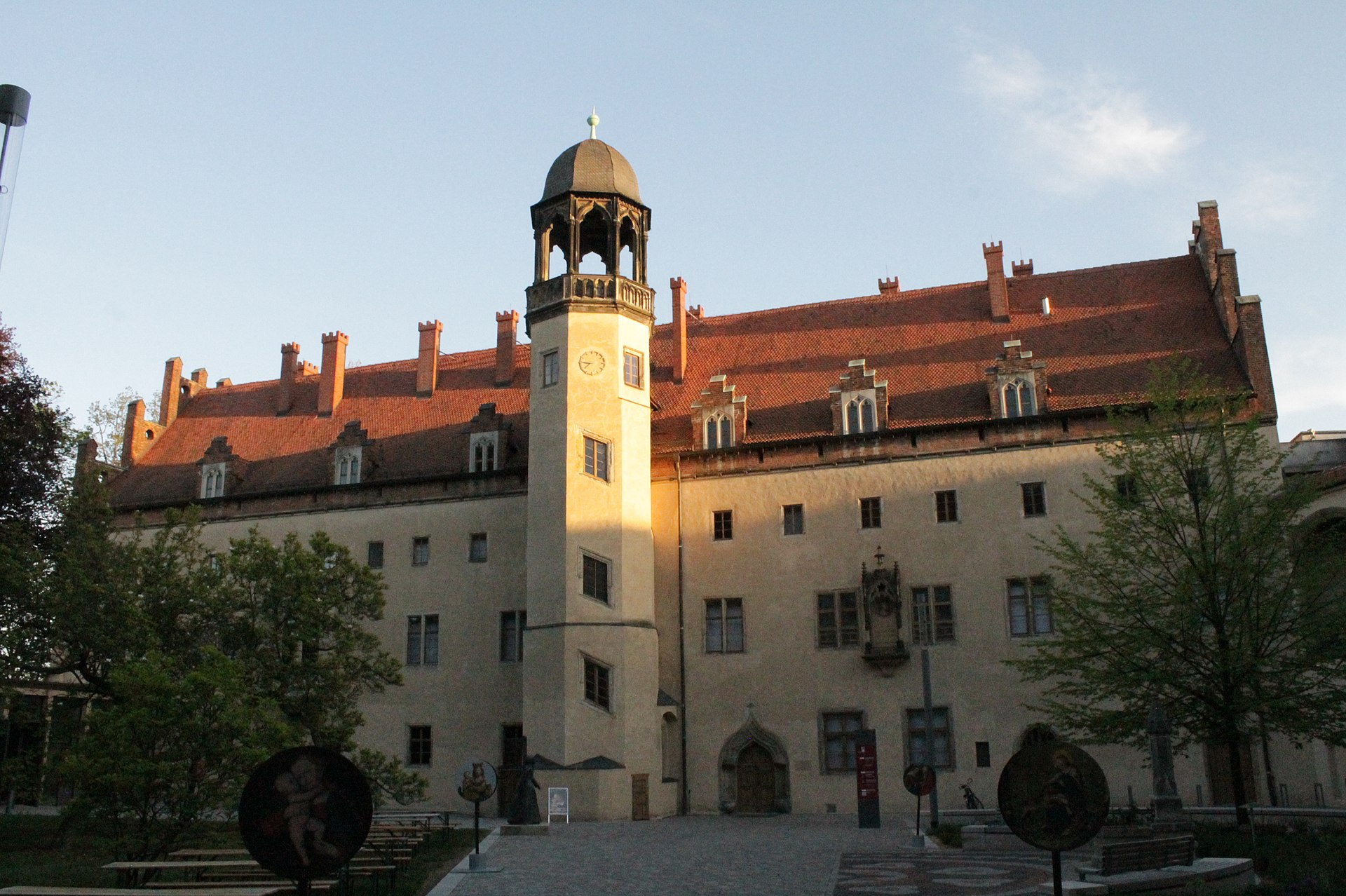 Luther's accommodation in Wittenberg In accordance with his father's wishes, he enrolled in law but dropped out almost immediately, believing that law represented uncertainty.[25] Luther sought assurances about life and was drawn to theology and philosophy, expressing particular interest in Aristotle, William of Ockham, and Gabriel Biel.[25] He was deeply influenced by two tutors, Bartholomaeus Arnoldi von Usingen and Jodocus Trutfetter, who taught him to be suspicious of even the greatest thinkers[25] and to test everything himself by experience.[26] Philosophy proved to be unsatisfying, offering assurance about the use of reason but none about loving God, which to Luther was more important. Reason could not lead men to God, he felt, and he thereafter developed a love-hate relationship with Aristotle over the latter's emphasis on reason.[26] For Luther, reason could be used to question men and institutions, but not God. Human beings could learn about God only through divine revelation, he believed, and Scripture therefore became increasingly important to him.[26] On 2 July 1505, while Luther was returning to university on horseback after a trip home, a lightning bolt struck near him during a thunderstorm. Later telling his father he was terrified of death and divine judgment, he cried out, "Help! Saint Anna, I will become a monk!"[27][28] He came to view his cry for help as a vow he could never break. He left university, sold his books, and entered St. Augustine's Monastery in Erfurt on 17 July 1505.[29] One friend blamed the decision on Luther's sadness over the deaths of two friends. Luther himself seemed saddened by the move. Those who attended a farewell supper walked him to the door of the Black Cloister. "This day you see me, and then, not ever again," he said.[26] His father was furious over what he saw as a waste of Luther's education.[30] Monastic life  A posthumous portrait of Luther as an Augustinian friar Luther dedicated himself to the Augustinian order, devoting himself to fasting, long hours in prayer, pilgrimage, and frequent confession.[31] Luther described this period of his life as one of deep spiritual despair. He said, "I lost touch with Christ the Savior and Comforter, and made of him the jailer and hangman of my poor soul."[32] Johann von Staupitz, his superior, concluded that Luther needed more work to distract him from excessive introspection and ordered him to pursue an academic career. On 3 April 1507, Jerome Schultz (Latin: Hieronymus Scultetus), the Bishop of Brandenburg, ordained Luther in Erfurt Cathedral. In 1508, he began teaching theology at the University of Wittenberg.[33] He received a bachelor's degree in biblical studies on 9 March 1508 and another bachelor's degree in the Sentences by Peter Lombard in 1509.[34] On 19 October 1512, he was awarded his Doctor of Theology and, on 21 October 1512, was received into the senate of the theological faculty of the University of Wittenberg,[35] having succeeded von Staupitz as chair of theology.[36] He spent the rest of his career in this position at the University of Wittenberg. He was made provincial vicar of Saxony and Thuringia by his religious order in 1515. This meant he was to visit and oversee each of eleven monasteries in his province.[37] |
生い立ち 出生と教育  ルーカス・クラナッハ(父)によるハンスとマルガレーテ・ルターの肖像画、1527年  エアフルト、聖アウグスティヌス修道院、旧修道士寮 マルティン・ルターは、1483年11月10日、神聖ローマ帝国のマンスフェルト県アイスレーベンで、ハンス・ルーダー(後のルター)とその妻マルガレー テ(旧姓リンデマン)の間に生まれた[18]。ルターは翌朝、トゥールの聖マルティヌスの祝日に洗礼を受けた。1484年、一家はマンスフェルトに移り住 み、父親は銅山と製錬所の賃貸人であり[19]、地方議会の4人の市民代表の一人を務めた。 ルターには数人の兄弟姉妹がおり、そのうちの一人であるヤコブと親しかったことが知られている[21]。 ハンス・ルターは自分自身と家族のために野心的で、長男のマルティンが弁護士になることを望んでいた。彼はマルティンをマンスフェルトのラテン語学校、 1497年にはマグデブルク、1498年にはアイゼナハのラテン語学校に通わせた。ルターは後にそこでの教育を煉獄と地獄に例えた[23]。 1501年、17歳の時にエアフルト大学に入学したルターは、後にビール小屋と娼館と形容される[24]。  修道士となったルター。  ヴィッテンベルクのルターの宿舎 父親の意向により、法学部に入学したが、法学は不確実なものであると考え、ほとんどすぐに中退した[25]。ルターは、人生についての保証を求め、神学と 哲学に惹かれ、特にアリストテレス、オッカムのウィリアム、ガブリエル・ビールに興味を示した[25]。 哲学は、理性の使用については保証を与えるが、ルターにとってより重要であった神を愛することについては保証を与えない、満足のいくものではないことが判 明した。理性は人を神へと導くことはできないと感じたルターは、その後、理性を強調するアリストテレスとの間に愛憎関係を築いた[26]。人間は神の啓示 によってのみ神について学ぶことができると彼は信じ、それゆえ聖書は彼にとってますます重要なものとなった[26]。 1505年7月2日、ルターが帰郷後、馬に乗って大学に戻る途中、雷雨の中、稲妻が彼の近くに落ちた。その後、父に死と神の裁きが怖いと告げたルターは、 「助けてください!聖アンナ、私は修道士になります!」[27][28]と叫んだ。彼は大学を去り、本を売り払い、1505年7月17日にエアフルトの聖 アウグスティヌス修道院に入った[29]。ある友人は、この決断を2人の友人の死に対するルターの悲しみのせいだと非難した。ルター自身も、この引っ越し を悲しんでいたようだ。別れの晩餐会に出席した人々は、ルターを黒い回廊の入り口まで見送った。「ルターの父親は、ルターの教育が無駄になったと激怒した [30]。 修道生活  アウグスチノ会修道士としてのルターの遺影 ルターはアウグスティヌス修道会に身を捧げ、断食、長時間の祈り、巡礼、頻繁な告解に専念した[31]。救い主であり慰め主であるキリストとの接触を失 い、キリストを私の哀れな魂の看守であり絞首刑執行人とした」[32]。 彼の上司であったヨハン・フォン・シュタウピッツは、ルターには過度の内省から気を紛らわすためにもっと仕事が必要であると結論づけ、学問の道に進むよう 命じた。1507年4月3日、ブランデンブルク司教ジェローム・シュルツ(ラテン語:Hieronymus Scultetus)は、エアフルト大聖堂でルターを聖職に就かせた。1508年、ヴィッテンベルク大学で神学を教え始める[33]。1508年3月9 日、聖書学で学士号を、1509年にはペーテル・ロンバールの文章で学士号を取得。 [34] 1512年10月19日、神学博士号を授与され、10月21日にはフォン・シュタウピッツの後任としてヴィッテンベルク大学の神学部の元老院に迎えられた [35]。 1515年、修道会からザクセンとチューリンゲンの地方牧師の任に就く。これは彼が州内の11の修道院を訪問し、それぞれを監督することを意味した [37]。 |
| Start of the Reformation Further information: History of Protestantism and History of Lutheranism  The Catholic sale of indulgences shown in A Question to a Mintmaker, woodcut by Jörg Breu the Elder of Augsburg, c. 1530 In 1516, Johann Tetzel, a Dominican friar, was sent to Germany by the Roman Catholic Church to sell indulgences to raise money in order to rebuild St. Peter's Basilica in Rome.[38] Tetzel's experiences as a preacher of indulgences, especially between 1503 and 1510, led to his appointment as general commissioner by Albrecht von Brandenburg, Archbishop of Mainz, who, already deeply in debt to pay for a large accumulation of benefices, had to contribute the considerable sum of ten thousand ducats[39] toward the rebuilding of the basilica. Albrecht obtained permission from Pope Leo X to conduct the sale of a special plenary indulgence (i.e., remission of the temporal punishment of sin), half of the proceeds of which Albrecht was to claim to pay the fees of his benefices. On 31 October 1517, Luther wrote to his bishop, Albrecht von Brandenburg, protesting against the sale of indulgences. He enclosed in his letter a copy of his "Disputation on the Power and Efficacy of Indulgences",[a] which came to be known as the Ninety-five Theses. Hans Hillerbrand writes that Luther had no intention of confronting the church but saw his disputation as a scholarly objection to church practices, and the tone of the writing is accordingly "searching, rather than doctrinaire."[41] Hillerbrand writes that there is nevertheless an undercurrent of challenge in several of the theses, particularly in Thesis 86, which asks: "Why does the pope, whose wealth today is greater than the wealth of the richest Crassus, build the basilica of St. Peter with the money of poor believers rather than with his own money?"[41] Luther objected to a saying attributed to Tetzel that "As soon as the coin in the coffer rings, the soul from purgatory (also attested as 'into heaven') springs."[42] He insisted that, since forgiveness was God's alone to grant, those who claimed that indulgences absolved buyers from all punishments and granted them salvation were in error. Christians, he said, must not slacken in following Christ on account of such false assurances. 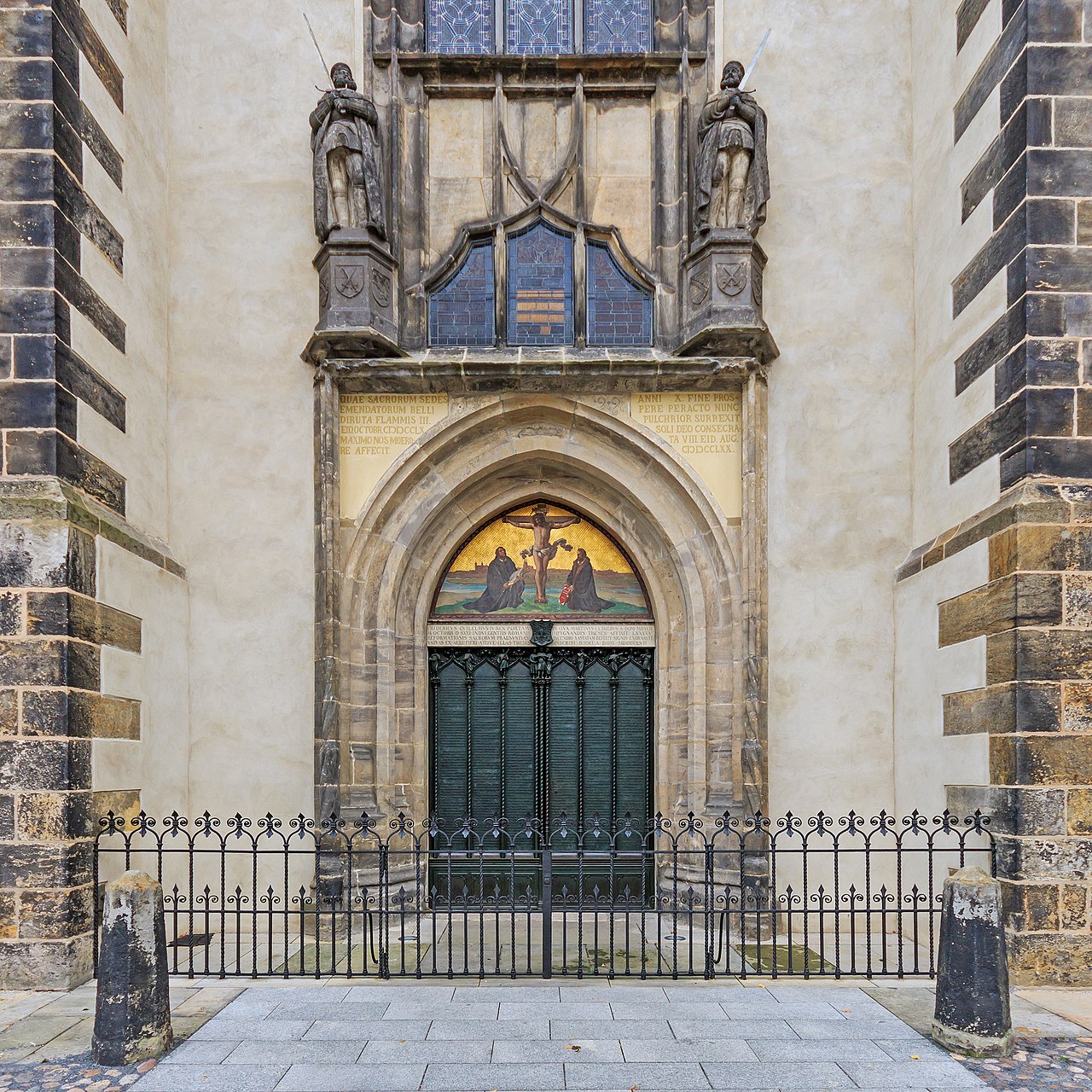 Luther's theses are engraved into the door of All Saints' Church, Wittenberg. The Latin inscription above informs the reader that the original door was destroyed by a fire, and that in 1857, King Frederick William IV of Prussia ordered a replacement be made. According to one account, Luther nailed his Ninety-five Theses to the door of All Saints' Church in Wittenberg on 31 October 1517. Scholars Walter Krämer, Götz Trenkler, Gerhard Ritter, and Gerhard Prause contend that the story of the posting on the door, although it has become one of the pillars of history, has little foundation in truth.[43][44][45][46] The story is based on comments made by Luther's collaborator Philip Melanchthon, though it is thought that he was not in Wittenberg at the time.[47] According to Roland Bainton, on the other hand, it is true.[48] The Latin Theses were printed in several locations in Germany in 1517. In January 1518 friends of Luther translated the Ninety-five Theses from Latin into German.[49] Within two weeks, copies of the theses had spread throughout Germany. Luther's writings circulated widely, reaching France, England, and Italy as early as 1519. Students thronged to Wittenberg to hear Luther speak. He published a short commentary on Galatians and his Work on the Psalms. This early part of Luther's career was one of his most creative and productive.[50] Three of his best-known works were published in 1520: To the Christian Nobility of the German Nation, On the Babylonian Captivity of the Church, and On the Freedom of a Christian. Justification by faith alone Main article: Sola fide  Luther at Erfurt, which depicts Martin Luther discovering the doctrine of sola fide (by faith alone). Painting by Joseph Noel Paton, 1861. From 1510 to 1520, Luther lectured on the Psalms, and on the books of Hebrews, Romans, and Galatians. As he studied these portions of the Bible, he came to view the use of terms such as penance and righteousness by the Catholic Church in new ways. He became convinced that the church was corrupt in its ways and had lost sight of what he saw as several of the central truths of Christianity. The most important for Luther was the doctrine of justification—God's act of declaring a sinner righteous—by faith alone through God's grace. He began to teach that salvation or redemption is a gift of God's grace, attainable only through faith in Jesus as the Messiah.[51] "This one and firm rock, which we call the doctrine of justification", he writes, "is the chief article of the whole Christian doctrine, which comprehends the understanding of all godliness."[52] Luther came to understand justification as entirely the work of God. This teaching by Luther was clearly expressed in his 1525 publication On the Bondage of the Will, which was written in response to On Free Will by Desiderius Erasmus (1524). Luther based his position on predestination on St. Paul's epistle to the Ephesians 2:8–10. Against the teaching of his day that the righteous acts of believers are performed in cooperation with God, Luther wrote that Christians receive such righteousness entirely from outside themselves; that righteousness not only comes from Christ but actually is the righteousness of Christ, imputed to Christians (rather than infused into them) through faith.[53] "That is why faith alone makes someone just and fulfills the law," he writes. "Faith is that which brings the Holy Spirit through the merits of Christ."[54] Faith, for Luther, was a gift from God; the experience of being justified by faith was "as though I had been born again." His entry into Paradise, no less, was a discovery about "the righteousness of God"—a discovery that "the just person" of whom the Bible speaks (as in Romans 1:17) lives by faith.[55] He explains his concept of "justification" in the Smalcald Articles: The first and chief article is this: Jesus Christ, our God and Lord, died for our sins and was raised again for our justification (Romans 3:24–25). He alone is the Lamb of God who takes away the sins of the world (John 1:29), and God has laid on Him the iniquity of us all (Isaiah 53:6). All have sinned and are justified freely, without their own works and merits, by His grace, through the redemption that is in Christ Jesus, in His blood (Romans 3:23–25). This is necessary to believe. This cannot be otherwise acquired or grasped by any work, law, or merit. Therefore, it is clear and certain that this faith alone justifies us ... Nothing of this article can be yielded or surrendered, even though heaven and earth and everything else falls (Mark 13:31).[56] Breach with the papacy 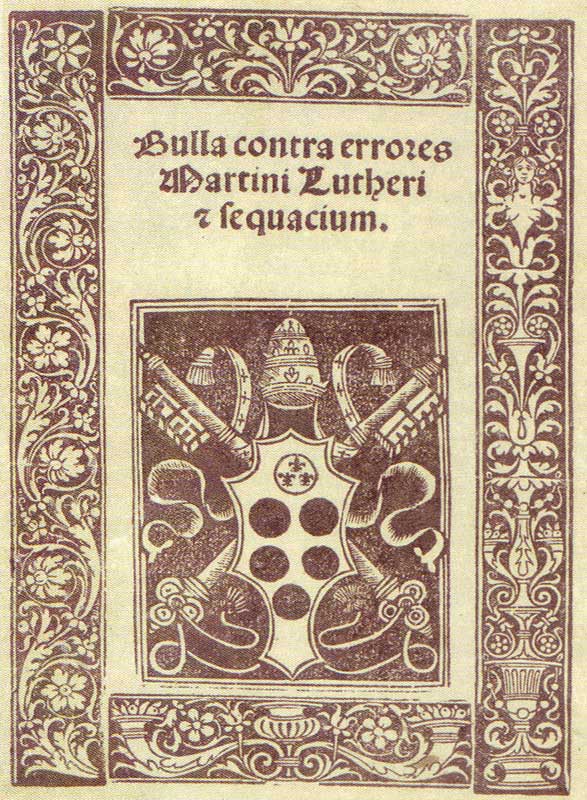 Pope Leo X's Bull against the errors of Martin Luther, 1521, commonly known as Exsurge Domine Archbishop Albrecht did not reply to Luther's letter containing the Ninety-five Theses. He had the theses checked for heresy and in December 1517 forwarded them to Rome.[57] He needed the revenue from the indulgences to pay off a papal dispensation for his tenure of more than one bishopric. As Luther later notes, "the pope had a finger in the pie as well, because one half was to go to the building of St. Peter's Church in Rome".[58] Pope Leo X was used to reformers and heretics,[59] and he responded slowly, "with great care as is proper."[60] Over the next three years he deployed a series of papal theologians and envoys against Luther, which served only to harden the reformer's anti-papal theology. First, the Dominican theologian Sylvester Mazzolini drafted a heresy case against Luther, whom Leo then summoned to Rome. The Elector Frederick persuaded the pope to have Luther examined at Augsburg, where the Imperial Diet was held.[61] Over a three-day period in October 1518, Luther defended himself under questioning by papal legate Cardinal Cajetan. The pope's right to issue indulgences was at the centre of the dispute between the two men.[62][63] The hearings degenerated into a shouting match. More than writing his theses, Luther's confrontation with the church cast him as an enemy of the pope: "His Holiness abuses Scripture", retorted Luther. "I deny that he is above Scripture".[64][65] Cajetan's original instructions had been to arrest Luther if he failed to recant, but the legate desisted from doing so.[66] With help from the Carmelite friar Christoph Langenmantel, Luther slipped out of the city at night, unbeknownst to Cajetan.[67] 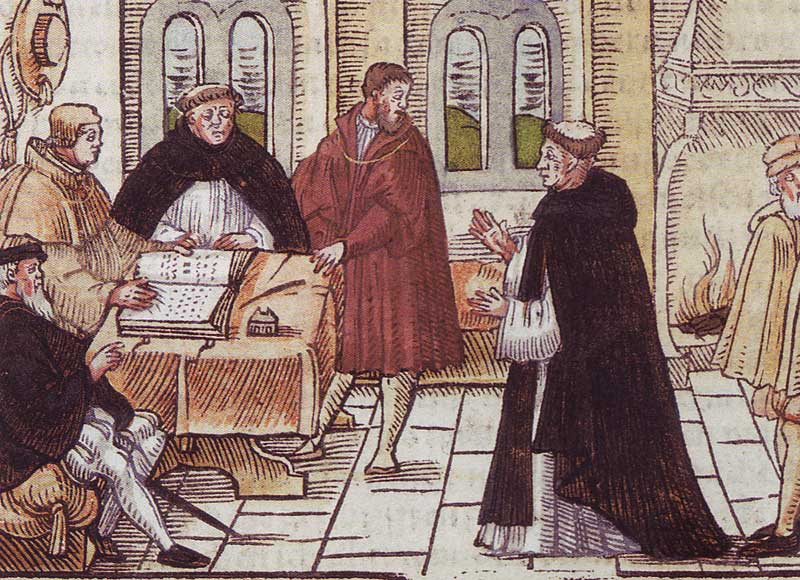 The meeting of Martin Luther (right) and Cardinal Cajetan (left, holding the book) In January 1519, at Altenburg in Saxony, the papal nuncio Karl von Miltitz adopted a more conciliatory approach. Luther made certain concessions to the Saxon, who was a relative of the Elector and promised to remain silent if his opponents did.[68] The theologian Johann Eck, however, was determined to expose Luther's doctrine in a public forum. In June and July 1519, he staged a disputation with Luther's colleague Andreas Karlstadt at Leipzig and invited Luther to speak.[69] Luther's boldest assertion in the debate was that Matthew 16:18 does not confer on popes the exclusive right to interpret scripture, and that therefore neither popes nor church councils were infallible.[70] For this, Eck branded Luther a new Jan Hus, referring to the Czech reformer and heretic burned at the stake in 1415. From that moment, he devoted himself to Luther's defeat.[71] Excommunication On 15 June 1520, the Pope warned Luther with the papal bull (edict) Exsurge Domine that he risked excommunication unless he recanted 41 sentences drawn from his writings, including the Ninety-five Theses, within 60 days. That autumn, Eck proclaimed the bull in Meissen and other towns. Von Miltitz attempted to broker a solution, but Luther, who had sent the pope a copy of On the Freedom of a Christian in October, publicly set fire to the bull and decretals in Wittenberg on 10 December 1520,[72] an act he defended in Why the Pope and his Recent Book are Burned and Assertions Concerning All Articles. Luther was excommunicated by Pope Leo X on 3 January 1521, in the bull Decet Romanum Pontificem.[73] And although the Lutheran World Federation, Methodists and the Catholic Church's Pontifical Council for Promoting Christian Unity agreed (in 1999 and 2006, respectively) on a "common understanding of justification by God's grace through faith in Christ," the Catholic Church has never lifted the 1521 excommunication.[74][75][76] |
宗教改革の始まり さらなる情報 プロテスタンティズムの歴史とルター派の歴史  1530年頃、アウクスブルクの長老イェルク・ブリューの木版画『造幣職人への質問』に描かれたカトリックの免罪符販売。 1516年、ドミニコ会の修道士ヨハン・テッツェルは、ローマのサン・ピエトロ大聖堂を再建するための資金集めのために、免罪符を売るためにローマ・カト リック教会からドイツに派遣された。 [38]テッツェルは、特に1503年から1510年にかけて免罪符の伝道師として活躍した経験から、マインツの大司教アルブレヒト・フォン・ブランデン ブルクによって総監に任命された。アルブレヒトは、すでに多額の恩典の支払いのために多額の負債を抱えており、バシリカの再建のために1万ドゥカート [39]という大金を拠出しなければならなかった。アルブレヒトは、教皇レオ10世から、特別な免罪符(罪の仮罰の免除)の販売を行う許可を得た。 1517年10月31日、ルターは司教であるアルブレヒト・フォン・ブランデンブルクに、免罪符の販売に抗議する手紙を書いた。その手紙には、後に 「95ヶ条の論題」として知られるようになる「免罪符の効力と効力に関する論争」[a]の写しが同封されていた。ハンス・ヒラーブランドは、ルターは教会 と対立するつもりはなく、自分の論争を教会の慣行に対する学問的な異議申し立てとみなしていたと書いており、それゆえ、その文章の論調は「教義的というよ りは、むしろ探求的」であったと述べている[41]: 「今日、その富は最も裕福なクラッススの富よりも大きい教皇が、なぜサンピエトロ大聖堂を自分の金ではなく、貧しい信者の金で建てるのか」[41]。 ルターは、「棺桶の中の硬貨が鳴るとすぐに、魂は煉獄から(「天国へ」とも証言されている)湧き出る」というテッツェルの故事に異議を唱えた[42]。キ リスト者は、そのような偽りの保証のためにキリストに従うことを緩めてはならないと彼は言った。  ルターの論題は、ヴィッテンベルクの全聖徒教会の扉に刻まれている。上のラテン語の碑文によれば、オリジナルの扉は火事で焼失し、1857年にプロイセン 王フリードリヒ・ウィリアム4世が代替品の製作を命じたという。 一説によれば、ルターは1517年10月31日、ヴィッテンベルクの諸聖徒教会の扉に「95ヶ条の論題」を釘で打ち付けたという。学者であるヴァルター・ クレーマー、ゲッツ・トレンクラー、ゲルハルト・リッター、ゲルハルト・プラウゼは、扉に貼り付けられたという話は、歴史の柱の一つとなっているものの、 真実の根拠はほとんどないと主張している[43][44][45][46]。 この話は、ルターの協力者であったフィリップ・メランヒトンのコメントに基づいているが、彼は当時ヴィッテンベルクにいなかったと考えられている [47]。 ラテン語のテーゼは1517年にドイツの数カ所で印刷された。1518年1月、ルターの友人たちが「九十五箇条の論題」をラテン語からドイツ語に翻訳した [49]。2週間も経たないうちに、「九十五箇条の論題」のコピーはドイツ全土に広まった。ルターの著作は広く流布し、1519年には早くもフランス、イ ギリス、イタリアに届いた。ルターの話を聞くために、学生たちはヴィッテンベルクに押し寄せた。ルターは、ガラテヤ書の短い注解書と詩篇に関する著作を出 版した。ルターのキャリアの初期は、最も創造的で生産的な時期であった[50]: ドイツ国民のキリスト教徒貴族へ』、『教会のバビロン捕囚について』、『キリスト者の自由について』である。 信仰のみによる義認 主な記事 ソラ・フィデ  ソラ・フィデ(信仰のみによる義認)の教義を発見したマルティン・ルターを描いた『エアフルトのルター』。ジョセフ・ノエル・パトン作、1861年。 1510年から1520年にかけて、ルターは詩篇、ヘブル人への手紙、ローマ人への手紙、ガラテヤ人への手紙について講義を行った。聖書のこれらの部分を 学ぶうちに、彼はカトリック教会が懺悔や義といった用語を用いていることを新たな視点で見るようになった。ルターは、教会がそのやり方において堕落してお り、キリスト教の中心的な真理のいくつかを見失っていると確信した。ルターにとって最も重要だったのは、義認の教義-神の恵みによって信仰のみによって罪 人を義とする神の行為-であった。ルターは、救済や贖いは神の恵みの賜物であり、メシアであるイエスを信じる信仰によってのみ到達可能であると教え始めた [51]。「義認の教理と呼ぶこの一つの堅固な岩は、キリスト教の教理全体の主要な記事であり、すべての敬虔の理解を包括するものである」と彼は書いてい る[52]。 ルターは義認を完全に神の業として理解するようになった。ルターのこの教えは、デジデリウス・エラスムスの『自由意志について』(1524年)に対抗して 書かれた『意志の束縛について』(1525年)に明確に表現されている。ルターは、聖パウロのエフェソの信徒への手紙2:8-10に基づく定命についての 立場をとった。ルターは、信仰者の正しい行いは神と協力して行われるという当時の教えに対して、クリスチャンはそのような義を完全に自分自身の外から受け ると書き、その義はキリストから来るだけでなく、実際には信仰によってクリスチャンに(注入されるのではなく)付与されるキリストの義であると書いた [53]。 「だから信仰だけが人を義とし、律法を成就させるのです。「信仰はキリストの功績によって聖霊をもたらすものである」[54]。ルターにとって信仰は神か らの賜物であり、信仰によって義とされる経験は「まるで生まれ変わったかのよう」であった。彼の楽園への入城は、「神の義」についての発見であり、聖書が (ローマ1:17のように)語る「正しい人」が信仰によって生きているという発見であった: 第一条は次のとおりである: 私たちの神であり主であるイエス・キリストは、私たちの罪のために死なれ、私たちの義認のためによみがえられました(ローマ3:24-25)。彼だけが世 の罪を取り除く神の小羊であり(ヨハネ1:29)、神は私たちすべての咎を彼に負わせた(イザヤ53:6)。すべての人は罪を犯したが、キリスト・イエス の血による贖いによって、主の恵みによって、自分の行いや功績なしに、自由に義と認められる(ローマ3:23-25)。これは信じるために必要なことであ る。そうでなければ、いかなる行いや律法や功績によっても、これを獲得したり、把握したりすることはできない。したがって、この信仰だけが私たちを義とす ることは明らかであり、確かなことなのである。たとえ天と地と他のすべてのものが崩れ落ちようとも(マルコ13:31)、この信条は何一つ譲ることも明け 渡すこともできないのである[56]。 ローマ教皇庁との決裂  1521年、教皇レオ10世がマルティン・ルターの誤りに反対した勅書。 アルブレヒト大司教は、九十五ヶ条の論題を含むルターの手紙に返事を出さなかった。1517年12月、アルブレヒト大司教は、異端であるかどうかをチェッ クさせ、それをローマに送付した[57]。彼は、免罪符からの収入を、複数の司教座に在任するための教皇の免除の返済に充てる必要があった。後にルターが 述べているように、「ローマ教皇もパイに指を突っ込んでいた。 教皇レオ10世は改革者や異端者に慣れており[59]、「適切な注意を払いながら」ゆっくりと対応した[60]。その後3年間、教皇はルターに対して一連 の教皇派の神学者や使節を配置したが、それは改革者の反教皇神学を硬化させるだけであった。まず、ドミニコ会の神学者シルヴェスター・マッツォリーニがル ターに対する異端訴訟を起草し、レオはルターをローマに召喚した。選帝侯フリードリヒは教皇を説得し、帝国議会が開かれていたアウクスブルクでルターを尋 問させた[61]。 1518年10月の3日間、教皇公使カジェタン枢機卿の尋問を受け、ルターは弁明した。教皇の免罪符発行権が二人の争いの中心であった[62][63]。 ルターは、論題を書くこと以上に、教会と対立することで、教皇の敵として扱われた: 「法王は聖典を乱用している」とルターは反論した。教皇は聖典を乱用している」とルターは言い返し、「私は教皇が聖典の上にいることを否定する」[64] [65] カジェタンの当初の指示は、ルターが撤回に応じなければ逮捕するというものであったが、教皇はそれを取りやめた[66]。カルメル会の修道士クリストフ・ ランゲンマンテルの助けを借りて、ルターはカジェタンに知られることなく、夜に街を抜け出した[67]。  マルティン・ルター(右)とカジェタン枢機卿(左、本を持っている)の出会い 1519年1月、ザクセンのアルテンブルクで、ローマ教皇の枢機卿カール・フォン・ミルティッツは、より融和的なアプローチを採用した。ルターは、選帝侯 の親族であったこのザクセン人に一定の譲歩をし、反対派が黙秘するならば黙秘することを約束した[68]。しかし、神学者ヨハン・エックは、ルターの教義 を公の場で暴露することを決意した。1519年6月と7月、彼はルターの同僚アンドレアス・カールシュタットとライプツィヒで論争を行い、ルターを講演に 招いた[69]。この論争でルターが最も大胆に主張したのは、マタイによる福音書16章18節は教皇に聖典を解釈する排他的な権利を与えておらず、した がって教皇も教会公会議も無謬ではないということであった[70]。その瞬間から、彼はルターの敗北に身を捧げるようになった[71]。 破門 1520年6月15日、教皇は教皇勅令(Exsurge Domine)をもって、ルターが60日以内に「九十五箇条の論題」を含む41の文章を撤回しない限り、破門される恐れがあると警告した。その年の秋、 エックはマイセンやその他の町でこの教令を布告した。フォン・ミルティッツは解決の仲介を試みたが、10月に教皇に『キリスト者の自由について』のコピー を送っていたルターは、1520年12月10日、ヴィッテンベルクで、教皇とその最近の書物はなぜ焼かれたのか、そしてすべての記事に関する主張』の中で 弁護しているように、教皇とその最近の書物に公然と火を放った[72]。 ルターは1521年1月3日、教皇レオ10世によって、教令『Decet Romanum Pontificem』において破門された[73]。ルター派世界連盟、メソジスト派、カトリック教会の教皇庁キリスト教一致推進評議会は、「キリストへ の信仰による神の恵みによる義認の共通理解」について(それぞれ1999年と2006年に)合意したが、カトリック教会は1521年の破門を解除したこと はない[74][75][76]。 |
| Diet of Worms (1521) Main article: Diet of Worms 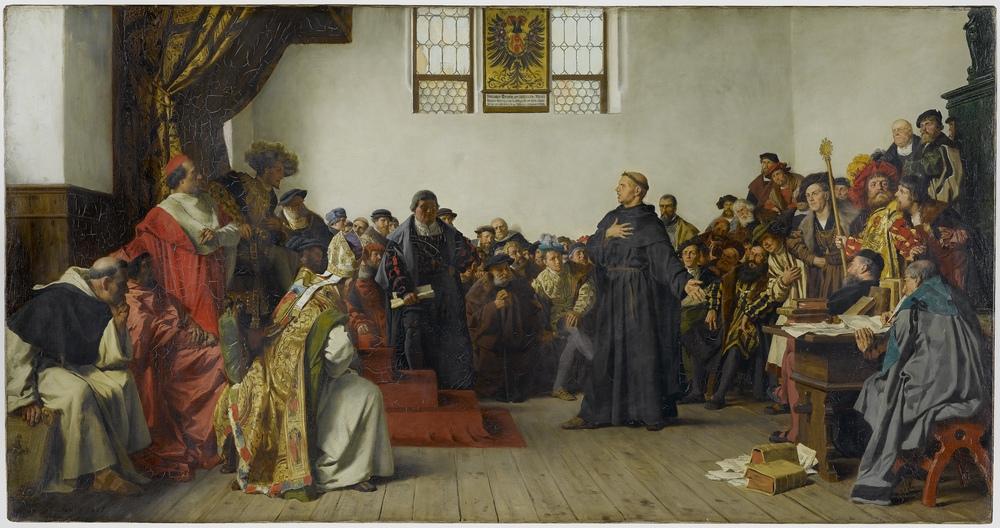 Luther Before the Diet of Worms by Anton von Werner (1843–1915) The enforcement of the ban on the Ninety-five Theses fell to the secular authorities. On 18 April 1521, Luther appeared as ordered before the Diet of Worms. This was a general assembly of the estates of the Holy Roman Empire that took place in Worms, a town on the Rhine. It was conducted from 28 January to 25 May 1521, with Emperor Charles V presiding. Prince Frederick III, Elector of Saxony, obtained a safe conduct for Luther to and from the meeting. Johann Eck, speaking on behalf of the empire as assistant of the Archbishop of Trier, presented Luther with copies of his writings laid out on a table and asked him if the books were his and whether he stood by their contents. Luther confirmed he was their author but requested time to think about the answer to the second question. He prayed, consulted friends, and gave his response the next day: Unless I am convinced by the testimony of the Scriptures or by clear reason (for I do not trust either in the pope or in councils alone, since it is well known that they have often erred and contradicted themselves), I am bound by the Scriptures I have quoted, and my conscience is captive to the Word of God. I cannot and will not recant anything since it is neither safe nor right to go against conscience. May God help me. Amen.[77] At the end of this speech, Luther raised his arm "in the traditional salute of a knight winning a bout." Michael Mullett considers this speech as a "world classic of epoch-making oratory."[78] 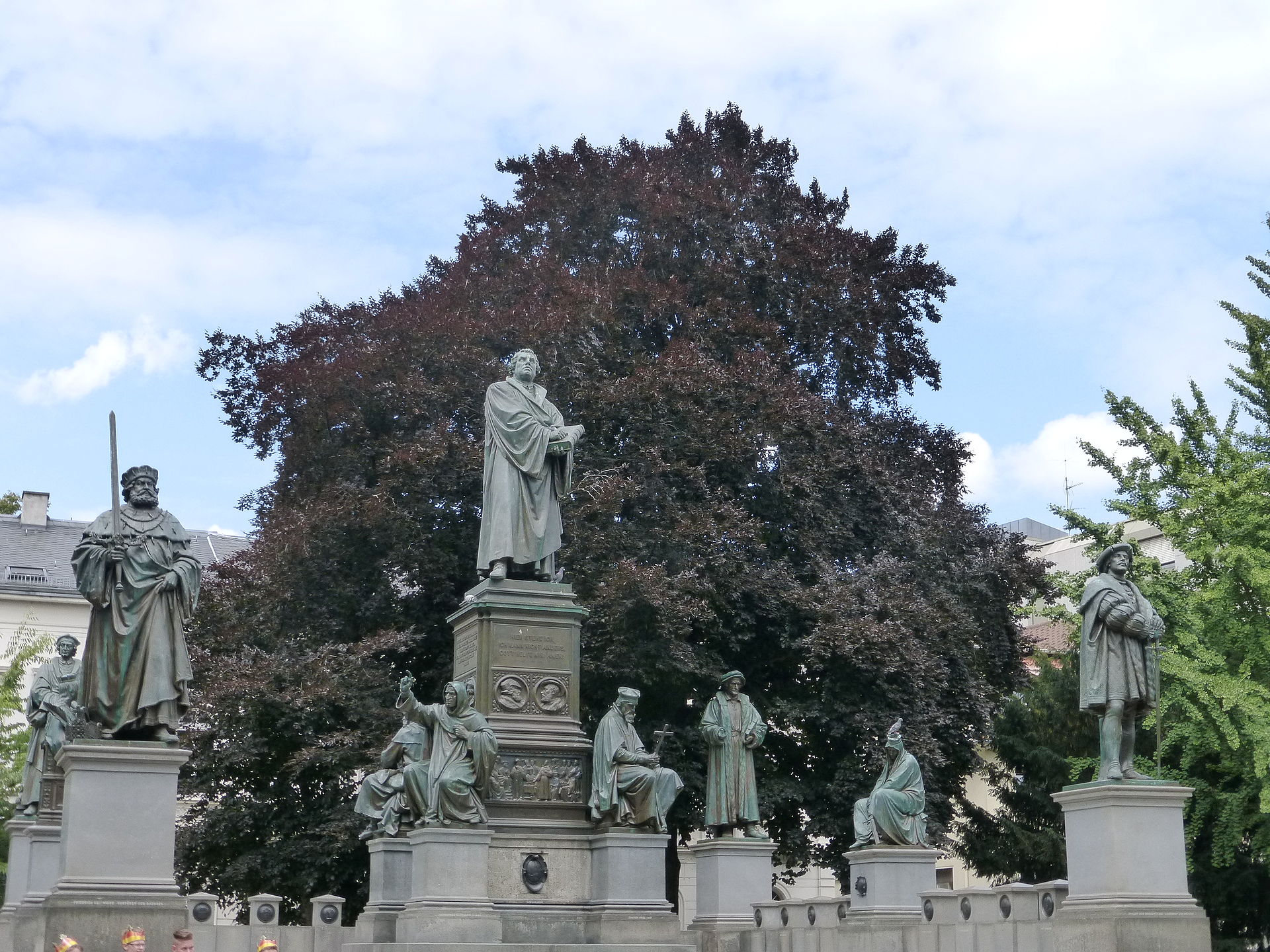 Luther Monument in Worms. His statue is surrounded by the figures of his lay protectors and earlier Church reformers including John Wycliffe, Jan Hus and Girolamo Savonarola. Eck informed Luther that he was acting like a heretic, saying, Martin, there is no one of the heresies which have torn the bosom of the church, which has not derived its origin from the various interpretation of the Scripture. The Bible itself is the arsenal whence each innovator has drawn his deceptive arguments. It was with Biblical texts that Pelagius and Arius maintained their doctrines. Arius, for instance, found the negation of the eternity of the Word—an eternity which you admit, in this verse of the New Testament—Joseph knew not his wife till she had brought forth her first-born son; and he said, in the same way that you say, that this passage enchained him. When the fathers of the Council of Constance condemned this proposition of Jan Hus—The church of Jesus Christ is only the community of the elect, they condemned an error; for the church, like a good mother, embraces within her arms all who bear the name of Christian, all who are called to enjoy the celestial beatitude.[79] Luther refused to recant his writings. He is sometimes also quoted as saying: "Here I stand. I can do no other". Recent scholars consider the evidence for these words to be unreliable since they were inserted before "May God help me" only in later versions of the speech and not recorded in witness accounts of the proceedings.[80] However, Mullett suggests that given his nature, "we are free to believe that Luther would tend to select the more dramatic form of words."[78] Over the next five days, private conferences were held to determine Luther's fate. The emperor presented the final draft of the Edict of Worms on 25 May 1521, declaring Luther an outlaw, banning his literature, and requiring his arrest: "We want him to be apprehended and punished as a notorious heretic."[81] It also made it a crime for anyone in Germany to give Luther food or shelter. It permitted anyone to kill Luther without legal consequence. |
ヴォルムスでの議論(1521年) 主な記事 ヴォルムス会議  アントン・フォン・ヴェルナー(1843-1915)作『ヴォルムス国会の前のルター』 九十五ヶ条の論題禁止令の執行は、世俗当局に委ねられた。1521年4月18日、ルターは命じられるままにヴォルムス国会に出頭した。この国会は、ライン 川沿いの町ヴォルムスで開催された神聖ローマ帝国の諸侯の総会であった。1521年1月28日から5月25日まで開催され、皇帝シャルル5世が議長を務め た。ザクセン選帝侯フリードリヒ3世は、ルターのために安全な往復の交通手段を確保した。 ヨハン・エックは、トリアー大司教の補佐官として帝国を代表し、テーブルに並べられたルターの著作のコピーをルターに差し出し、これらの書物が自分のもの であるか、またその内容を支持するかどうかを尋ねた。ルターは自分がその著作の著者であることを認めたが、2番目の質問の答えについて考える時間を求め た。ルターは祈り、友人に相談し、翌日答えを出した: 聖書の証言や明確な理性(教皇や公会議がしばしば誤りや矛盾を犯してきたことはよく知られているので、私は教皇や公会議だけを信頼することはない)によっ て確信しない限り、私は引用した聖書に拘束され、私の良心は神の言葉に囚われている。良心に逆らうことは安全でも正しいことでもないので、私は何も撤回で きないし、するつもりもない。神が私を助けてくださいますように。アーメン」[77]。 この演説の最後に、ルターは「試合に勝利した騎士の伝統的な敬礼で」腕を上げた。マイケル・マレットはこの演説を「エポックメイキングな演説の世界的古 典」とみなしている[78]。  ヴォルムスのルター記念碑。ルターの銅像の周りには、ルターを庇護した信徒や、ジョン・ウィクリフ、ヤン・フス、ジローラモ・サヴォナローラといった先代 の教会改革者たちの像が並んでいる。 エックは、ルターが異端のように振る舞っていることを告げ、こう言った、 マルタン、教会の懐を引き裂いた異端の中で、聖書のさまざまな解釈に由来しないものは一つもない。聖書そのものが、それぞれの革新者たちが欺瞞に満ちた議 論を引き出す武器なのだ。ペラギウスとアリウスが自分たちの教義を維持したのは、聖書のテキストを用いたからである。たとえばアリウスは、新約聖書のこの 一節に、みことばの永遠性--あなたがたも認めている永遠性--の否定を見出した。コンスタンツ公会議の教父たちが、ヤン・フスのこの命題を非難したと き、「イエス・キリストの教会は選民の共同体であるにすぎない。 ルターは自分の著作を撤回することを拒否した。ルターは自分の著作を撤回することを拒んだ: 「私はここに立っている。私はここに立っている。しかし、マレットは、彼の性格を考えれば、「ルターがより劇的な形式の言葉を選ぶ傾向があると信じるのは 自由である」と示唆している[78]。 その後5日間、ルターの運命を決めるための私的な会議が開かれた。1521年5月25日、皇帝はヴォルムス勅令の最終稿を提出し、ルターを無法者とし、そ の文献を禁止し、逮捕を要求した: 「我々は彼を逮捕し、悪名高い異端者として処罰することを望んでいる」[81] また、この勅令は、ドイツ国内の誰もがルターに食物や住居を与えることを犯罪とした。また、ドイツ国内の誰もがルターに食べ物や庇護を与えることを犯罪と した。 |
Wartburg Castle (1521)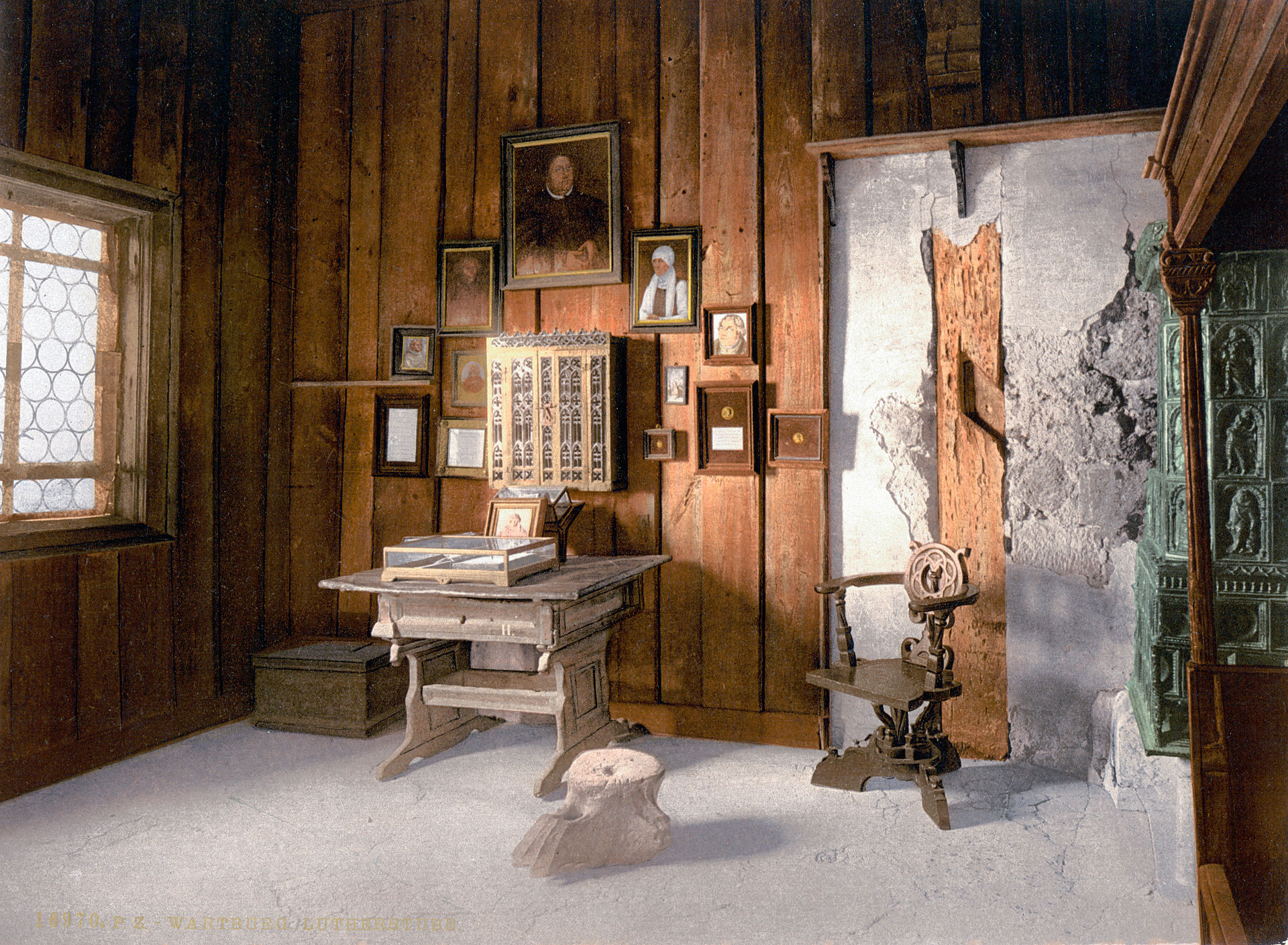 The Wartburg room where Luther translated the New Testament into German; an original first edition is kept in the case on the desk. Wartburg Castle in Eisenach Luther's disappearance during his return to Wittenberg was planned. Frederick III had him intercepted on his way home in the forest near Wittenberg by masked horsemen impersonating highway robbers. They escorted Luther to the security of the Wartburg Castle at Eisenach.[82] During his stay at Wartburg, which he referred to as "my Patmos",[83] Luther translated the New Testament from Greek into German and poured out doctrinal and polemical writings. These included a renewed attack on Archbishop Albrecht of Mainz, whom he shamed into halting the sale of indulgences in his episcopates,[84] and a Refutation of the Argument of Latomus, in which he expounded the principle of justification to Jacobus Latomus, an orthodox theologian from Louvain.[85] In this work, one of his most emphatic statements on faith, he argued that every good work designed to attract God's favor is a sin.[86] All humans are sinners by nature, he explained, and God's grace alone (which cannot be earned) can make them just. On 1 August 1521, Luther wrote to Melanchthon on the same theme: "Be a sinner, and let your sins be strong, but let your trust in Christ be stronger, and rejoice in Christ who is the victor over sin, death, and the world. We will commit sins while we are here, for this life is not a place where justice resides."[87] In the summer of 1521, Luther widened his target from individual pieties like indulgences and pilgrimages to doctrines at the heart of Church practice. In On the Abrogation of the Private Mass, he condemned as idolatry the idea that the mass is a sacrifice, asserting instead that it is a gift, to be received with thanksgiving by the whole congregation.[88] His essay On Confession, Whether the Pope has the Power to Require It rejected compulsory confession and encouraged private confession and absolution, since "every Christian is a confessor."[89] In November, Luther wrote The Judgement of Martin Luther on Monastic Vows. He assured monks and nuns that they could break their vows without sin, because vows were an illegitimate and vain attempt to win salvation.[90]  Luther disguised as "Junker Jörg", 1521 Luther made his pronouncements from Wartburg in the context of rapid developments at Wittenberg, of which he was kept fully informed. Andreas Karlstadt, supported by the ex-Augustinian Gabriel Zwilling, embarked on a radical programme of reform there in June 1521, exceeding anything envisaged by Luther. The reforms provoked disturbances, including a revolt by the Augustinian friars against their prior, the smashing of statues and images in churches, and denunciations of the magistracy. After secretly visiting Wittenberg in early December 1521, Luther wrote A Sincere Admonition by Martin Luther to All Christians to Guard Against Insurrection and Rebellion.[91] Wittenberg became even more volatile after Christmas when a band of visionary zealots, the so-called Zwickau prophets, arrived, preaching revolutionary doctrines such as the equality of man,[clarification needed] adult baptism, and Christ's imminent return.[92] When the town council asked Luther to return, he decided it was his duty to act.[93] |
ヴァルトブルク城(1521年) ルターが新約聖書をドイツ語に翻訳したヴァルトブルクの部屋。机の上のケースには初版の原本が保管されている。 アイゼナハのヴァルトブルク城 ヴィッテンベルクに戻ったルターの失踪は計画的だった。フリードリヒ3世は、ルターがヴィッテンベルク近郊の森に帰宅する途中、高速道路強盗になりすまし た覆面をした騎馬民族にルターを妨害させた。彼が「私のパトモス」と呼んだヴァルトブルクでの滞在中[83]、ルターは新約聖書をギリシア語からドイツ語 に翻訳し、教義的・極論的な著作を書き上げた。その中には、マインツのアルブレヒト大司教を再び攻撃し、彼の司教座における免罪符の販売を中止させたもの や[84]、ルーヴァンの正統派神学者ヤコブス・ラトムスに対して義認の原理を説いた『ラトムスの反論』などがある。 [85]信仰に関する彼の最も強調された声明のひとつであるこの著作の中で、彼は、神の好意を引き寄せるために計画されたあらゆる善行は罪であると主張し た[86]。1521年8月1日、ルターは同じテーマでメランヒトンに手紙を書いた: 「罪人であれ、罪は強くあれ、キリストへの信頼はより強くあれ、そして罪と死と世に勝利するキリストを喜びなさい。私たちはここにいる間にも罪を犯すで しょう、この世は正義が宿る場所ではないからです」[87]。 1521年の夏、ルターは、免罪符や巡礼のような個人的な信心から、教会の実践の中心にある教義へと対象を広げた。私的ミサの廃止について』では、ミサが 生け贄であるという考えを偶像崇拝として非難し、その代わりに、ミサは会衆全体が感謝をもって受ける賜物であると主張した[88]。11月には、ルターは 『修道誓願に関するマルティン・ルターの判決』を書いた。ルターは、修道士や修道女が誓願を破っても罪にはならないと断言し、誓願は救いを得ようとする非 合法で虚しい試みであるとした[90]。  1521年、"ユンカー・イェルク "に変装したルター ルターがヴァルトブルクから宣教した背景には、ヴィッテンベルクでの急速な進展があった。アンドレアス・カールシュタットは、元アウグスティヌス派のガブ リエル・ツヴィリングに支えられ、1521年6月、ルターの構想を上回る急進的な改革プログラムに着手した。この改革は、アウグスチノ会の修道士による修 道院長への反乱、教会の彫像や聖像の破壊、司政への非難などの騒乱を引き起こした。1521年12月初旬に密かにヴィッテンベルクを訪れたルターは、『マ ルティン・ルターによるすべてのキリスト教徒に対する反乱と反抗を防ぐための忠告』(A Sincere Admonition by Martin Luther to All Christians to Guard against Insurrection and Rebellion)を著した[91]。クリスマス後、ヴィッテンベルクはさらに不安定になり、いわゆるツヴィッカウの予言者たちと呼ばれる幻視狂の一団 が到着し、人間の平等、[要出典]成人の洗礼、キリストの復活といった革命的な教義を説いた[92]。 |
| Return to Wittenberg and
Peasants' War See also: Radical Reformation and German Peasants' War Luther secretly returned to Wittenberg on 6 March 1522. He wrote to the Elector: "During my absence, Satan has entered my sheepfold, and committed ravages which I cannot repair by writing, but only by my personal presence and living word."[94] For eight days in Lent, beginning on Invocavit Sunday, 9 March, Luther preached eight sermons, which became known as the "Invocavit Sermons". In these sermons, he hammered home the primacy of core Christian values such as love, patience, charity, and freedom, and reminded the citizens to trust God's word rather than violence to bring about necessary change.[95] Do you know what the Devil thinks when he sees men use violence to propagate the gospel? He sits with folded arms behind the fire of hell and says with malignant looks and frightful grin: "Ah, how wise these madmen are to play my game! Let them go on; I shall reap the benefit. I delight in it." But when he sees the Word running and contending alone on the battle-field, then he shudders and shakes for fear.[96] The effect of Luther's intervention was immediate. After the sixth sermon, the Wittenberg jurist Jerome Schurf wrote to the elector: "Oh, what joy has Dr. Martin's return spread among us! His words, through divine mercy, are bringing back every day misguided people into the way of the truth."[96] Luther next set about reversing or modifying the new church practices. By working alongside the authorities to restore public order, he signaled his reinvention as a conservative force within the Reformation.[97] After banishing the Zwickau prophets, he faced a battle against both the established Church and the radical reformers who threatened the new order by fomenting social unrest and violence.[98]  The Twelve Articles, 1525 Despite his victory in Wittenberg, Luther was unable to stifle radicalism further afield. Preachers such as Thomas Müntzer and Zwickau prophet Nicholas Storch found support amongst poorer townspeople and peasants between 1521 and 1525. There had been revolts by the peasantry on smaller scales since the 15th century.[99] Luther's pamphlets against the Church and the hierarchy, often worded with "liberal" phraseology, led many peasants to believe he would support an attack on the upper classes in general.[100] Revolts broke out in Franconia, Swabia, and Thuringia in 1524, even drawing support from disaffected nobles, many of whom were in debt. Gaining momentum under the leadership of radicals such as Müntzer in Thuringia, and Hipler and Lotzer in the south-west, the revolts turned into war.[101] Luther sympathised with some of the peasants' grievances, as he showed in his response to the Twelve Articles in May 1525, but he reminded the aggrieved to obey the temporal authorities.[102] During a tour of Thuringia, he became enraged at the widespread burning of convents, monasteries, bishops' palaces, and libraries. In Against the Murderous, Thieving Hordes of Peasants, written on his return to Wittenberg, he gave his interpretation of the Gospel teaching on wealth, condemned the violence as the devil's work, and called for the nobles to put down the rebels like mad dogs: Therefore let everyone who can, smite, slay, and stab, secretly or openly, remembering that nothing can be more poisonous, hurtful, or devilish than a rebel ... For baptism does not make men free in body and property, but in soul; and the gospel does not make goods common, except in the case of those who, of their own free will, do what the apostles and disciples did in Acts 4 [:32–37]. They did not demand, as do our insane peasants in their raging, that the goods of others—of Pilate and Herod—should be common, but only their own goods. Our peasants, however, want to make the goods of other men common, and keep their own for themselves. Fine Christians they are! I think there is not a devil left in hell; they have all gone into the peasants. Their raving has gone beyond all measure.[103] Luther justified his opposition to the rebels on three grounds. First, in choosing violence over lawful submission to the secular government, they were ignoring Christ's counsel to "Render unto Caesar the things that are Caesar's"; St. Paul had written in his epistle to the Romans 13:1–7 that all authorities are appointed by God and therefore should not be resisted. This reference from the Bible forms the foundation for the doctrine known as the divine right of kings, or, in the German case, the divine right of the princes. Second, the violent actions of rebelling, robbing, and plundering placed the peasants "outside the law of God and Empire", so they deserved "death in body and soul, if only as highwaymen and murderers." Lastly, Luther charged the rebels with blasphemy for calling themselves "Christian brethren" and committing their sinful acts under the banner of the Gospel.[104] Only later in life did he develop the Beerwolf concept permitting some cases of resistance against the government.[105] Without Luther's backing for the uprising, many rebels laid down their weapons; others felt betrayed. Their defeat by the Swabian League at the Battle of Frankenhausen on 15 May 1525, followed by Müntzer's execution, brought the revolutionary stage of the Reformation to a close.[106] Thereafter, radicalism found a refuge in the Anabaptist movement and other religious movements, while Luther's Reformation flourished under the wing of the secular powers.[107] In 1526 Luther wrote: "I, Martin Luther, have during the rebellion slain all the peasants, for it was I who ordered them to be struck dead."[108] |
ヴィッテンベルクへの帰還と農民戦争 こちらもご覧ください: 急進宗教改革とドイツ農民戦争 1522年3月6日、ルターは密かにヴィッテンベルクに戻った。ルターは選帝侯に手紙を書いた: 「私が不在の間に、サタンは私の羊小屋に入り込み、私が文字で書くことによっては修復できないような荒らしを行いましたが、私の個人的な存在と生きた言葉 によってのみ修復することができます」[94] 3月9日のインヴォカヴィトの日曜日に始まる四旬節の8日間、ルターは「インヴォカヴィト説教」として知られるようになった8つの説教を行った。これらの 説教の中で彼は、愛、忍耐、慈愛、自由といったキリスト教の核となる価値観の優位性を強調し、必要な変化をもたらすためには暴力ではなく神の言葉を信頼す るよう市民に呼びかけた[95]。 人が福音を広めるために暴力を用いるのを見たとき、悪魔が何を考えるかわかるだろうか。悪魔は地獄の火の後ろに腕組みをして座り、悪意に満ちた表情と恐ろ しい笑みを浮かべて言う: 「ああ、この狂人たちは、私のゲームに興じるとはなんと賢いことか!彼らに続けさせればいい。私はそれを楽しむ。しかし、みことばが戦場を独りで走り、 戦っているのを見ると、恐怖のために身震いするのである[96]。 ルターの介入の効果はすぐに現れた。6回目の説教の後、ヴィッテンベルクの法学者ジェローム・シュルフは選帝侯に手紙を書いた: 「ああ、マルチン先生の帰還は、私たちの間にどんな喜びを広げたことでしょう!彼の言葉は、神の慈悲によって、日々、誤った人々を真理の道へと連れ戻して いる」[96]。 ルターは次に、新しい教会の慣習を覆したり、修正したりすることに着手した。ツヴィッカウの預言者たちを追放した後、ルターは、既成の教会と、社会不安と 暴力を煽ることによって新しい秩序を脅かす急進的な改革派の両方との戦いに直面した[98]。  十二箇条、1525年 ヴィッテンベルクでの勝利にもかかわらず、ルターはさらなる急進主義を抑えることはできなかった。トーマス・ミュンツァーやツヴィッカウの預言者ニコラ ス・シュトルヒのような説教者たちは、1521年から1525年にかけて、より貧しい町人や農民の間に支持を見出した。ルターは、教会やヒエラルキーに反 対するパンフレットをしばしば「自由主義的」な表現で発表したため、多くの農民は、ルターが上流階級全般への攻撃を支持していると考えるようになった [100]。1524年、フランケン、シュヴァーベン、チューリンゲンで反乱が勃発し、不満を抱く貴族たちからも支持を得たが、その多くは借金を抱えてい た。テューリンゲンではミュンツァー、南西部ではヒプラーやロッツァーといった急進派の指導の下で勢いを増し、反乱は戦争へと発展した[101]。 ルターは、1525年5月の「十二箇条」への回答で示したように、農民の不満のいくつかに共感していたが、不満を抱えた人々には、現政権に従うよう念を押 した[102]。テューリンゲン地方を視察した際、修道院、修道院、司教館、図書館が広範囲にわたって焼かれたことに激怒した。ヴィッテンベルクに戻った ときに書かれた『農民の殺戮と盗賊の大群に抗して』では、富に関する福音の教えの解釈を述べ、暴力を悪魔の所業と非難し、貴族たちに狂犬のように反乱軍を 鎮圧するよう呼びかけた: それゆえ、できる者は皆、密かに、あるいは公然と、打ち、殺し、刺し、反逆者ほど毒になるもの、傷つけるもの、悪魔的なものはないことを肝に銘じ よ......。洗礼は,肉体と財産において人を自由にするのではなく,魂において人を自由にするのであり,福音は,使徒言行録4章[:32-37]で使 徒と弟子たちがしたように,自分の自由意志で行う人を除いては,財貨を一般的なものにはしない。彼らは、ピラトやヘロデのような他人の財を共有にすること を要求したのではなく、自分の財だけを共有にすることを要求したのである。ところが、私たちの農民たちは、他人の財を共有にし、自分の財は自分のものにし ようとする。彼らは立派なキリスト教徒だ!地獄には悪魔は一人も残っていないと思う。彼らの憤怒は度を越している」[103]。 ルターは、3つの理由で反乱軍への反対を正当化した。第一に、世俗的な政府への合法的な服従よりも暴力を選択することで、彼らは「カイザルのものはカイザ ルに返しなさい」というキリストの忠告を無視していた。聖パウロはローマの信徒への手紙13章1~7節で、すべての権力者は神によって任命されたものであ り、それゆえ逆らってはならない、と書いている。この聖書からの引用が、王の神聖な権利、ドイツの場合は諸侯の神聖な権利として知られる教義の基礎を形成 している。第二に、反乱、強盗、略奪という暴力的な行為によって、農民たちは「神と帝国の掟から外れた」状態に置かれたのであり、「高速道路を行き来する 者、殺人者であるにせよ、身も心も死に値する」とした。最後に、ルターは、自分たちを「キリスト教の同胞」と呼び、福音の旗印の下で罪深い行為を行ってい るとして、反乱者たちを冒涜罪で告発した[104]。 蜂起に対するルターの後ろ盾がなければ、多くの反乱軍は武器を捨て、他の反乱軍は裏切られたと感じた。1525年5月15日のフランケンハウゼンの戦いで シュヴァーベン同盟に敗れ、ミュンツァーが処刑されたことで、宗教改革の革命的段階は幕を閉じた[106]。その後、急進主義はアナバプテスト運動や他の 宗教運動に逃げ場を見つけ、ルターの宗教改革は世俗権力の下で栄えた[107]。 |
Marriage Katharina von Bora, Luther's wife, by Lucas Cranach the Elder, 1526 Martin Luther married Katharina von Bora, one of 12 nuns he had helped escape from the Nimbschen Cistercian convent in April 1523, when he arranged for them to be smuggled out in herring barrels.[109] "Suddenly, and while I was occupied with far different thoughts," he wrote to Wenceslaus Link, "the Lord has plunged me into marriage."[110] At the time of their marriage, Katharina was 26 years old and Luther was 41 years old. 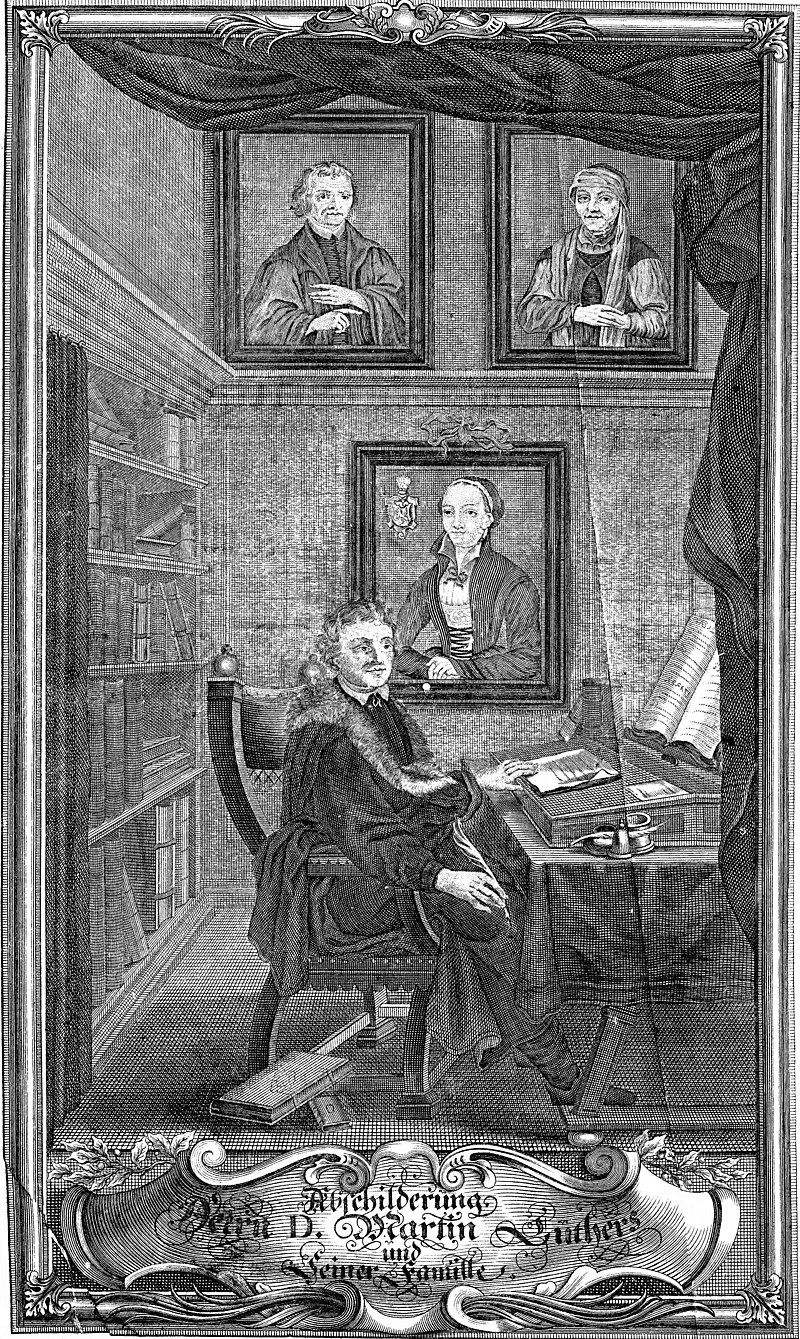 Martin Luther at his desk with family portraits (17th century) On 13 June 1525, the couple was engaged, with Johannes Bugenhagen, Justus Jonas, Johannes Apel, Philipp Melanchthon and Lucas Cranach the Elder and his wife as witnesses.[111] On the evening of the same day, the couple was married by Bugenhagen.[111] The ceremonial walk to the church and the wedding banquet were left out and were made up two weeks later on 27 June.[111] Some priests and former members of religious orders had already married, including Andreas Karlstadt and Justus Jonas, but Luther's wedding set the seal of approval on clerical marriage.[112] He had long condemned vows of celibacy on biblical grounds, but his decision to marry surprised many, not least Melanchthon, who called it reckless.[113] Luther had written to George Spalatin on 30 November 1524, "I shall never take a wife, as I feel at present. Not that I am insensible to my flesh or sex (for I am neither wood nor stone); but my mind is averse to wedlock because I daily expect the death of a heretic."[114] Before marrying, Luther had been living on the plainest food, and, as he admitted himself, his mildewed bed was not properly made for months at a time.[115] Luther and his wife moved into a former monastery, "The Black Cloister," a wedding present from Elector John the Steadfast. They embarked on what appears to have been a happy and successful marriage, though money was often short.[116] Katharina bore six children: Hans – June 1526; Elisabeth – 10 December 1527, who died within a few months; Magdalene – 1529, who died in Luther's arms in 1542; Martin – 1531; Paul – January 1533; and Margaret – 1534; and she helped the couple earn a living by farming and taking in boarders.[117] Luther confided to Michael Stiefel on 11 August 1526: "My Katie is in all things so obliging and pleasing to me that I would not exchange my poverty for the riches of Croesus."[118] |
結婚 ルターの妻カタリーナ・フォン・ボラ、長老ルーカス・クラナッハ作、1526年 マルティン・ルターは、1523年4月にニンブシェン・シトー会修道院からの脱出を手助けした12人の修道女の一人、カタリーナ・フォン・ボーラと結婚し た。 家族の肖像画と机に向かうマルティン・ルター(17世紀) 1525年6月13日、ヨハネス・ブッゲンハーゲン、ユストゥス・ヨナス、ヨハネス・アペル、フィリップ・メランヒトン、長老ルーカス・クラナッハ夫妻を 証人として、ふたりは婚約した[111]。 同日夕方、ふたりはブッゲンハーゲンによって結婚式を挙げた[111]。教会への散歩と披露宴の儀式は省かれ、2週間後の6月27日に行われた [111]。 アンドレアス・カールシュタットやユストゥス・ヨナスなど、すでに結婚していた司祭や修道会の元メンバーもいたが、ルターの結婚式は聖職者の結婚を承認す るものとなった[112]。 ルターは長い間、聖書的な理由から独身を誓うことを非難していたが、結婚するという彼の決断は、無謀だと言ったメランヒトンをはじめ、多くの人々を驚かせ た[113]。私は自分の肉や性に対して鈍感なわけではないが(私は木でも石でもないからだ)、異端者の死を毎日予期しているので、私の心は結婚を嫌って いる」[114] 結婚する前、ルターは最も質素な食事で生活しており、彼自身が認めているように、カビの生えたベッドは一度に何ヶ月もきちんと作られなかった[115]。 ルターとその妻は、選帝侯ヨハネ・ザ・ステファストからの結婚祝いとして、かつての修道院「黒い回廊」に移り住んだ。カタリーナは6人の子供をもうけた [116]: ハンス(1526年6月)、エリザベート(1527年12月10日、数ヶ月で死去)、マグダレーネ(1529年、1542年にルターの腕の中で死去)、マ ルティン(1531年)、パウロ(1533年1月)、マーガレット(1534年)。ルターは1526年8月11日、ミヒャエル・シュティーフェルに、「私 のケイティは、あらゆることに恩義を感じ、私を喜ばせてくれるので、私の貧しさをクロイソスの富と引き換えにはしません」と打ち明けた[118]。 |
Organising the church Church orders, Mecklenburg 1650 By 1526, Luther found himself increasingly occupied in organising a new church. His biblical ideal of congregations choosing their own ministers had proved unworkable.[119] According to Bainton: "Luther's dilemma was that he wanted both a confessional church based on personal faith and experience and a territorial church including all in a given locality. If he were forced to choose, he would take his stand with the masses, and this was the direction in which he moved."[120] From 1525 to 1529, he established a supervisory church body, laid down a new form of worship service, and wrote a clear summary of the new faith in the form of two catechisms.[121] To avoid confusing or upsetting the people, Luther avoided extreme change. He also did not wish to replace one controlling system with another. He concentrated on the church in the Electorate of Saxony, acting only as an adviser to churches in new territories, many of which followed his Saxon model. He worked closely with the new elector, John the Steadfast, to whom he turned for secular leadership and funds on behalf of a church largely shorn of its assets and income after the break with Rome.[122] For Luther's biographer Martin Brecht, this partnership "was the beginning of a questionable and originally unintended development towards a church government under the temporal sovereign".[123] The elector authorised a visitation of the church, a power formerly exercised by bishops.[124] At times, Luther's practical reforms fell short of his earlier radical pronouncements. For example, the Instructions for the Visitors of Parish Pastors in Electoral Saxony (1528), drafted by Melanchthon with Luther's approval, stressed the role of repentance in the forgiveness of sins, despite Luther's position that faith alone ensures justification.[125] The Eisleben reformer Johannes Agricola challenged this compromise, and Luther condemned him for teaching that faith is separate from works.[126] The Instruction is a problematic document for those seeking a consistent evolution in Luther's thought and practice.[127] 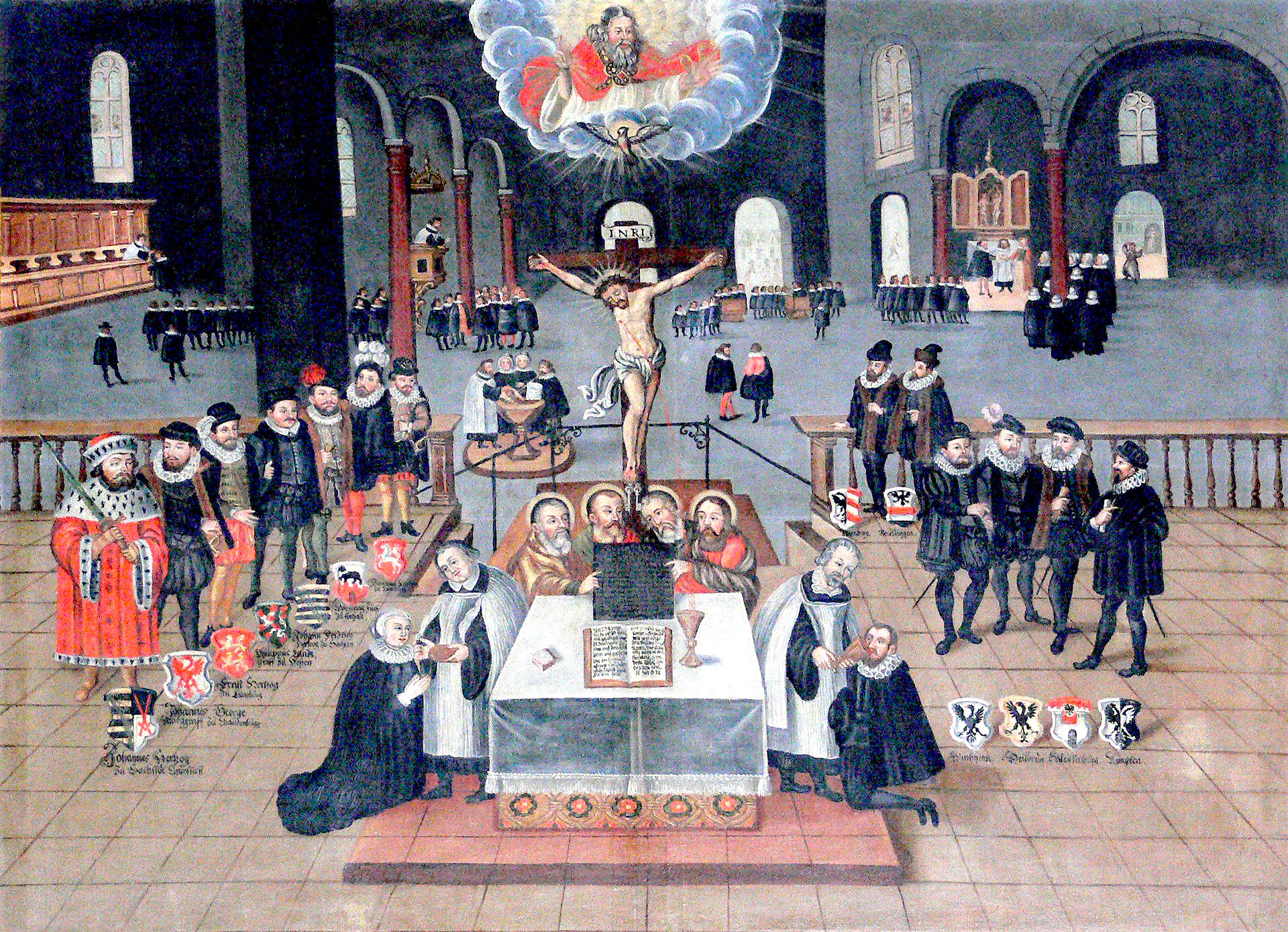 Lutheran church liturgy and sacraments In response to demands for a German liturgy, Luther wrote a German Mass, which he published in early 1526.[128] He did not intend it as a replacement for his 1523 adaptation of the Latin Mass but as an alternative for the "simple people", a "public stimulation for people to believe and become Christians."[129] Luther based his order on the Catholic service but omitted "everything that smacks of sacrifice", and the Mass became a celebration where everyone received the wine as well as the bread.[130] He retained the elevation of the host and chalice, while trappings such as the Mass vestments, altar, and candles were made optional, allowing freedom of ceremony.[131] Some reformers, including followers of Huldrych Zwingli, considered Luther's service too papistic, and modern scholars note the conservatism of his alternative to the Catholic Mass.[132] Luther's service, however, included congregational singing of hymns and psalms in German, as well as parts of the liturgy, including Luther's unison setting of the Creed.[133] To reach the simple people and the young, Luther incorporated religious instruction into the weekday services in the form of catechism.[134] He also provided simplified versions of the baptism and marriage services.[135] Luther and his colleagues introduced the new order of worship during their visitation of the Electorate of Saxony, which began in 1527.[136] They also assessed the standard of pastoral care and Christian education in the territory. "Merciful God, what misery I have seen," Luther writes, "the common people knowing nothing at all of Christian doctrine ... and unfortunately many pastors are well-nigh unskilled and incapable of teaching."[137] Catechisms A stained glass portrayal of Luther Luther devised the catechism as a method of imparting the basics of Christianity to the congregations. In 1529, he wrote the Large Catechism, a manual for pastors and teachers, as well as a synopsis, the Small Catechism, to be memorised by the people.[138] The catechisms provided easy-to-understand instructional and devotional material on the Ten Commandments, the Apostles' Creed, The Lord's Prayer, baptism, and the Lord's Supper.[139] Luther incorporated questions and answers in the catechism so that the basics of Christian faith would not just be learned by rote, "the way monkeys do it", but understood.[140] The catechism is one of Luther's most personal works. "Regarding the plan to collect my writings in volumes," he wrote, "I am quite cool and not at all eager about it because, roused by a Saturnian hunger, I would rather see them all devoured. For I acknowledge none of them to be really a book of mine, except perhaps the Bondage of the Will and the Catechism."[141] The Small Catechism has earned a reputation as a model of clear religious teaching.[142] It remains in use today, along with Luther's hymns and his translation of the Bible. Luther's Small Catechism proved especially effective in helping parents teach their children; likewise the Large Catechism was effective for pastors.[143] Using the German vernacular, they expressed the Apostles' Creed in simpler, more personal, Trinitarian language. He rewrote each article of the Creed to express the character of the Father, the Son, or the Holy Spirit. Luther's goal was to enable the catechumens to see themselves as a personal object of the work of the three persons of the Trinity, each of which works in the catechumen's life.[144] That is, Luther depicts the Trinity not as a doctrine to be learned, but as persons to be known. The Father creates, the Son redeems, and the Spirit sanctifies, a divine unity with separate personalities. Salvation originates with the Father and draws the believer to the Father. Luther's treatment of the Apostles' Creed must be understood in the context of the Decalogue (the Ten Commandments) and The Lord's Prayer, which are also part of the Lutheran catechetical teaching.[144] |
教会の組織 メクレンブルク1650年の教会命令 1526年まで、ルターは新しい教会を組織することでますます頭がいっぱいになっていた。信徒が自ら牧師を選ぶという彼の聖書の理想は、実行不可能である ことが判明した[119]: 「ルターのジレンマは、個人的な信仰と経験に基づく告白的な教会と、与えられた地域のすべての人を含む領土的な教会の両方を望んでいたことであった。もし 選択を迫られたら、彼は大衆の側に立つだろう。 1525年から1529年にかけて、彼は監督教会組織を設立し、礼拝の新しい形式を定め、2つのカテキズムの形で新しい信仰の明確な要約を書いた [121]。人々を混乱させたり動揺させたりすることを避けるために、ルターは極端な変化を避けた。また、ある支配体制を別の支配体制に置き換えることも 望まなかった。彼はザクセン選帝侯領の教会に集中し、新しい領地の教会の顧問としてのみ活動した。ルターの伝記作者マルティン・ブレヒトにとって、この パートナーシップは「現世の君主のもとでの教会政治に向けた、疑問の多い、元来意図されなかった発展の始まり」であった[123]。 選帝侯は、以前は司教によって行使されていた教会訪問を許可した[124]。ルターの実際的な改革は、彼の以前の急進的な宣言には及ばないこともあった。 例えば、ルターの承認を得てメランヒトンが起草した『ザクセン選帝侯における教区牧師の訪問に関する指示書』(1528年)は、信仰のみが義認を保証する というルターの立場にもかかわらず、罪の赦しにおける悔い改めの役割を強調していた[125]。アイスレーベンの改革者ヨハネス・アグリコラはこの妥協に 異議を唱え、ルターは信仰が行いから切り離されたものであると教えたとして彼を非難した[126]。  ルーテル教会の典礼と秘跡 ルターは、ドイツ語の典礼を求める声に応えて、ドイツ語のミサを書き、1526年初頭に発表した[128]。ルターはこのミサを、1523年に翻案したラ テン語のミサに代わるものとして意図したのではなく、「単純な人々」のための代替物、「人々が信仰し、キリスト教徒になるための公的な刺激」として意図し た。 「129]ルターは、カトリックの礼拝を基調としながらも、「いけにえを思わせるものすべて」を省き、ミサは、誰もがパンだけでなくワインも受ける祝祭と なった[130]。 [131] フルドリヒ・ツヴィングリの信奉者を含む一部の改革者たちは、ルターの礼拝はあまりにも教皇主義的であると考え、現代の学者たちは、カトリックのミサに対 するルターの代替案の保守性を指摘している[132]。 [133]ルターは、素朴な人々や若者たちに福音を伝えるために、カテキズムの形で平日の礼拝に宗教的な教えを取り入れた[134]。 ルターとその同僚たちは、1527年に始まったザクセン選帝侯国訪問の際に、新しい礼拝の秩序を紹介した[136]。彼らはまた、領内の司牧とキリスト教 教育の水準を評価した。「庶民はキリスト教の教義をまったく知らず......残念なことに、多くの牧師はほとんど熟練しておらず、教えることができな い」[137]。 カテキズム ステンドグラスに描かれたルター ルターは、キリスト教の基本を信徒に教える方法としてカテキズムを考案した。カテキズムは、十戒、使徒信条、主の祈り、洗礼、主の晩餐について、わかりや すく説き、信心に資するものであった[138]。 [139]ルターは、キリスト教信仰の基本を「猿がやるような」暗記で学ぶのではなく、理解できるように、カテキズムに質問と回答を取り入れた [140]。 カテキズムはルターの最も個人的な著作の一つである。「私の著作を一冊の本にまとめるという計画について、彼はこう書いている。小カテキズムは、明確な宗 教的教えの模範として高い評価を得ている[142]。 小カテキズムは、ルターの賛美歌や彼の翻訳した聖書とともに、今日でも使用されている。 ルターの『小カテキズム』は、親が子供に教えるのに特に効果的であることが証明され、同様に『大カテキズム』は牧師に効果的であった[143]。彼は信条 の各条文を、父、子、聖霊の性格を表現するために書き直した。つまり、ルターは三位一体を学ぶべき教義としてではなく、知るべき者として描いたのである。 御父は創造し、御子は贖い、御霊は聖化する。救いは御父に由来し、信じる者を御父へと引き寄せる。ルターによる使徒信条の扱いは、ルター派のカテケージカ ルな教えの一部でもあるデカログ(十戒)と主の祈りの文脈の中で理解されなければならない[144]。 |
| Translation of the Bible Main article: Luther Bible 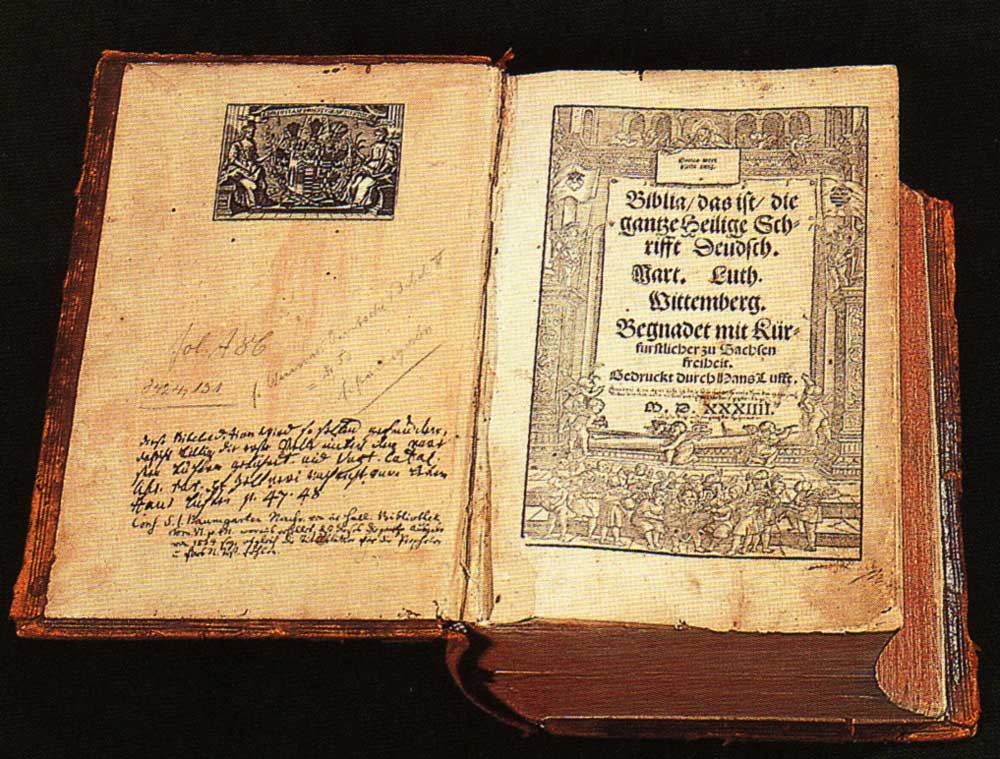 Luther's 1534 Bible Luther had published his German translation of the New Testament in 1522, and he and his collaborators completed the translation of the Old Testament in 1534, when the whole Bible was published. He continued to work on refining the translation until the end of his life.[145] Others had previously translated the Bible into German, but Luther tailored his translation to his own doctrine.[146] Two of the earlier translations were the Mentelin Bible (1456)[147] and the Koberger Bible (1484).[148] There were as many as fourteen in High German, four in Low German, four in Dutch, and various other translations in other languages before the Bible of Luther.[149] Luther's translation used the variant of German spoken at the Saxon chancellery, intelligible to both northern and southern Germans.[150] He intended his vigorous, direct language to make the Bible accessible to everyday Germans, "for we are removing impediments and difficulties so that other people may read it without hindrance."[151] Published at a time of rising demand for German-language publications, Luther's version quickly became a popular and influential Bible translation. As such, it contributed a distinct flavor to the German language and literature.[152] Furnished with notes and prefaces by Luther, and with woodcuts by Lucas Cranach that contained anti-papal imagery, it played a major role in the spread of Luther's doctrine throughout Germany.[153] The Luther Bible influenced other vernacular translations, such as the Tyndale Bible (from 1525 forward), a precursor of the King James Bible.[154] When he was criticised for inserting the word "alone" after "faith" in Romans 3:28,[155] he replied in part: "[T]he text itself and the meaning of St. Paul urgently require and demand it. For in that very passage he is dealing with the main point of Christian doctrine, namely, that we are justified by faith in Christ without any works of the Law. ... But when works are so completely cut away—and that must mean that faith alone justifies—whoever would speak plainly and clearly about this cutting away of works will have to say, 'Faith alone justifies us, and not works'."[156] Luther did not include First Epistle of John 5:7–8,[157] the Johannine Comma in his translation, rejecting it as a forgery. It was inserted into the text by other hands after Luther's death.[158][159] |
聖書の翻訳 主な記事 ルター聖書  ルターの1534年の聖書 ルターは、1522年に新約聖書のドイツ語訳を出版し、1534年に旧約聖書の翻訳を完成させ、聖書全体が出版された。ルターは晩年まで翻訳を改良し続け た[145]。以前にも他の人々が聖書をドイツ語に翻訳していたが、ルターは自分の教義に合わせて翻訳した[146]。 ルターの訳は、ザクセンの首相官邸で話されていた、北ドイツ人にも南ドイツ人にも理解できるドイツ語の変種を使用した[150]。ルターは、「他の人々が 支障なく聖書を読むことができるように、私たちは障害や困難を取り除こうとしているのです」[151]。ルターによる注釈と序文、反教皇的なイメージを含 むルーカス・クラナッハの木版画が添えられ、ルターの教義がドイツ全土に広まる上で大きな役割を果たした[153]。 ルター訳聖書は、欽定訳聖書の前身であるティンデール訳聖書(1525年以降)など、他の方言訳聖書にも影響を与えた[154]。 ローマ人への手紙3:28の「信仰」の後に「単独で」という言葉を挿入したことを批判されたとき[155]、彼は部分的に答えた: 「聖書本文そのものと聖パウロの意味は、それを緊急に要求しているのです。というのも、聖パウロはこの箇所で、キリスト教の教義の主要な点、すなわち、律 法の行いによらずにキリストを信じる信仰によって義とされるという点を扱っているからである。... しかし、業が完全に断ち切られるとき、それは信仰のみが義とされることを意味するに違いなく、業が断ち切られることについて明白かつ明確に語ろうとする者 は誰でも、『信仰のみが義とされるのであって、業が義とされるのではない』と言わなければならなくなる」[156]。このコンマはルターの死後、別の手に よってテキストに挿入された[158][159]。 |
| Hymnodist
(Luther's musical heritage) Main article: List of hymns by Martin Luther 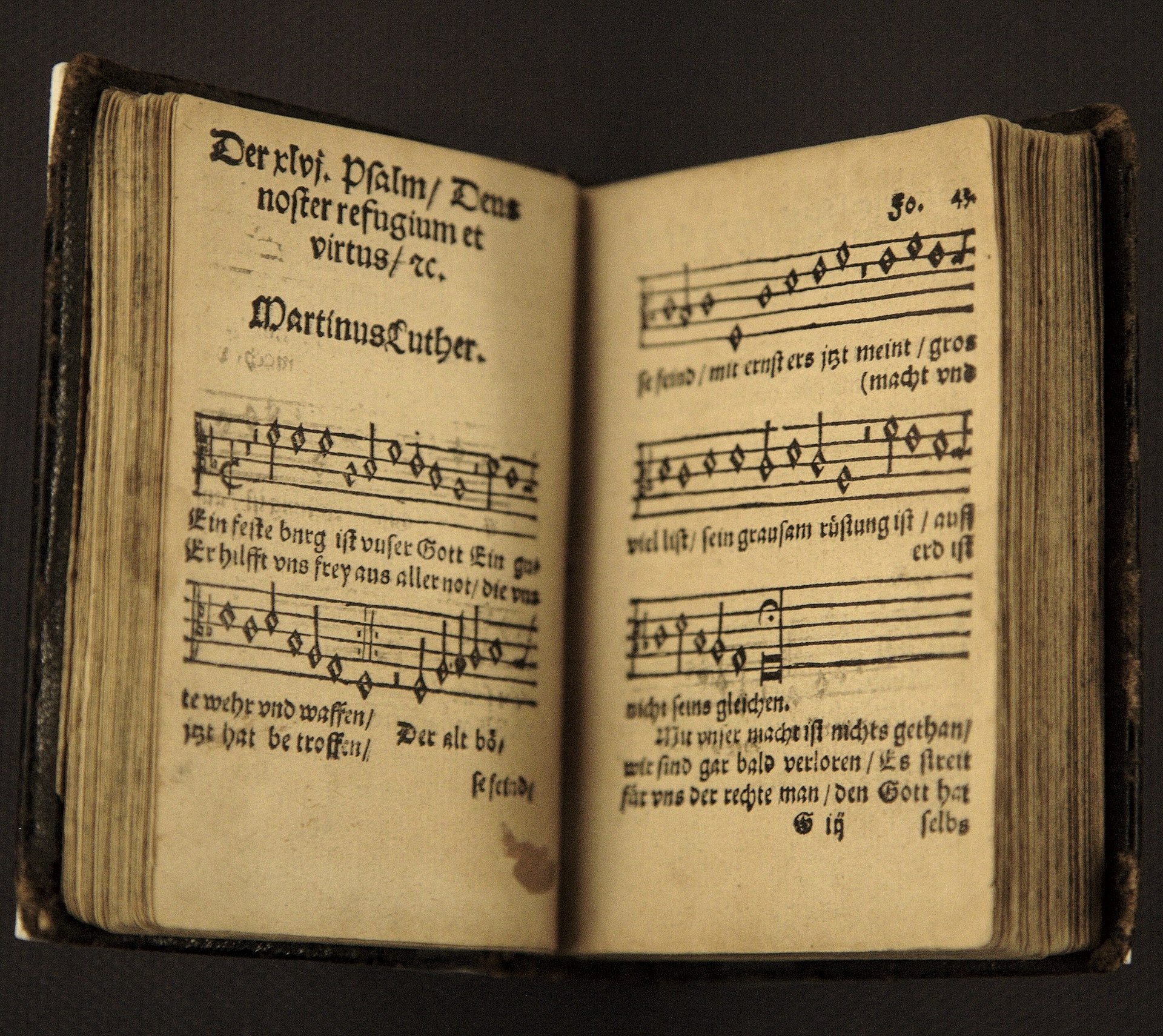 An early printing of Luther's hymn "Ein feste Burg ist unser Gott" Ein feste Burg ist unser Gott [German church song][+English translation] Problems playing this file? See media help. Luther was a prolific hymnodist, authoring hymns such as "Ein feste Burg ist unser Gott" ("A Mighty Fortress Is Our God"), based on Psalm 46, and "Vom Himmel hoch, da komm ich her" ("From Heaven Above to Earth I Come"), based on Luke 2:11–12.[160] Luther connected high art and folk music, also all classes, clergy and laity, men, women and children. His tool of choice for this connection was the singing of German hymns in connection with worship, school, home, and the public arena.[161] He often accompanied the sung hymns with a lute, later recreated as the waldzither that became a national instrument of Germany in the 20th century.[162] Luther's hymns were frequently evoked by particular events in his life and the unfolding Reformation. This behavior started with his learning of the execution of Jan van Essen and Hendrik Vos, the first individuals to be martyred by the Roman Catholic Church for Lutheran views, prompting Luther to write the hymn "Ein neues Lied wir heben an" ("A New Song We Raise"), which is generally known in English by John C. Messenger's translation by the title and first line "Flung to the Heedless Winds" and sung to the tune Ibstone composed in 1875 by Maria C. Tiddeman.[163] Luther's 1524 creedal hymn "Wir glauben all an einen Gott" ("We All Believe in One True God") is a three-stanza confession of faith prefiguring Luther's 1529 three-part explanation of the Apostles' Creed in the Small Catechism. Luther's hymn, adapted and expanded from an earlier German creedal hymn, gained widespread use in vernacular Lutheran liturgies as early as 1525. Sixteenth-century Lutheran hymnals also included "Wir glauben all" among the catechetical hymns, although 18th-century hymnals tended to label the hymn as Trinitarian rather than catechetical, and 20th-century Lutherans rarely used the hymn because of the perceived difficulty of its tune.[161] 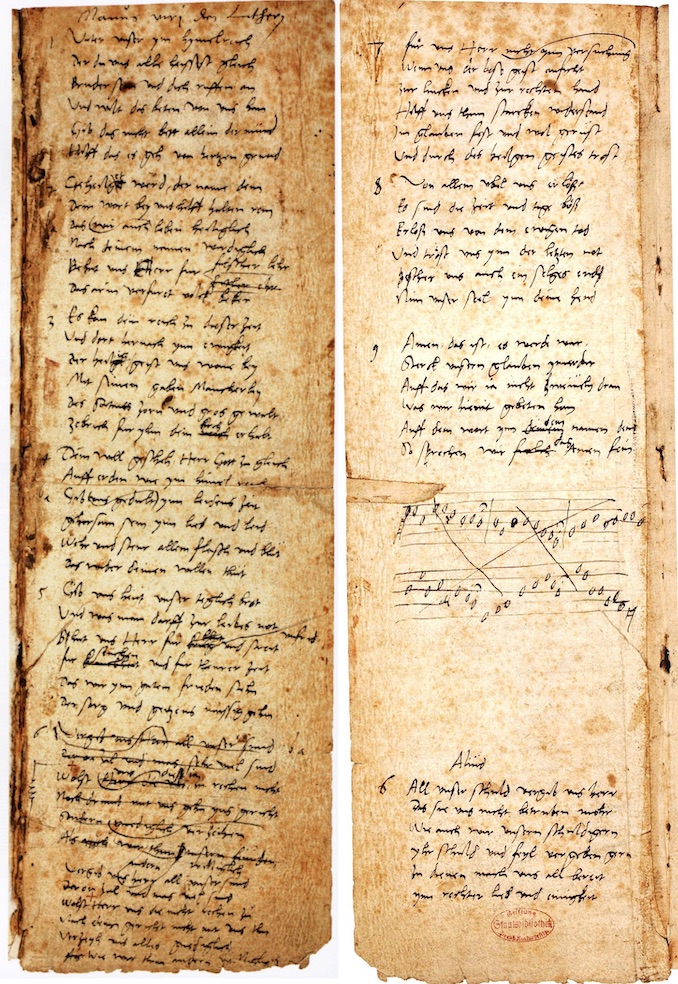 Autograph of "Vater unser im Himmelreich", with the only notes extant in Luther's handwriting Luther's 1538 hymnic version of the Lord's Prayer, "Vater unser im Himmelreich", corresponds exactly to Luther's explanation of the prayer in the Small Catechism, with one stanza for each of the seven prayer petitions, plus opening and closing stanzas. The hymn functions both as a liturgical setting of the Lord's Prayer and as a means of examining candidates on specific catechism questions. The extant manuscript shows multiple revisions, demonstrating Luther's concern to clarify and strengthen the text and to provide an appropriately prayerful tune. Other 16th- and 20th-century versifications of the Lord's Prayer have adopted Luther's tune, although modern texts are considerably shorter.[164] Luther wrote "Aus tiefer Not schrei ich zu dir" ("From depths of woe I cry to You") in 1523 as a hymnic version of Psalm 130 and sent it as a sample to encourage his colleagues to write psalm-hymns for use in German worship. In a collaboration with Paul Speratus, this and seven other hymns were published in the Achtliederbuch, the first Lutheran hymnal. In 1524 Luther developed his original four-stanza psalm paraphrase into a five-stanza Reformation hymn that developed the theme of "grace alone" more fully. Because it expressed essential Reformation doctrine, this expanded version of "Aus tiefer Not" was designated as a regular component of several regional Lutheran liturgies and was widely used at funerals, including Luther's own. Along with Erhart Hegenwalt's hymnic version of Psalm 51, Luther's expanded hymn was also adopted for use with the fifth part of Luther's catechism, concerning confession.[165] Luther wrote "Ach Gott, vom Himmel sieh darein" ("Oh God, look down from heaven"). "Nun komm, der Heiden Heiland" (Now come, Savior of the gentiles), based on Veni redemptor gentium, became the main hymn (Hauptlied) for Advent. He transformed A solus ortus cardine to "Christum wir sollen loben schon" ("We should now praise Christ") and Veni Creator Spiritus to "Komm, Gott Schöpfer, Heiliger Geist" ("Come, Holy Spirit, Lord God").[166] He wrote two hymns on the Ten Commandments, "Dies sind die heilgen Zehn Gebot" and "Mensch, willst du leben seliglich". His "Gelobet seist du, Jesu Christ" ("Praise be to You, Jesus Christ") became the main hymn for Christmas. He wrote for Pentecost "Nun bitten wir den Heiligen Geist", and adopted for Easter "Christ ist erstanden" (Christ is risen), based on Victimae paschali laudes. "Mit Fried und Freud ich fahr dahin", a paraphrase of Nunc dimittis, was intended for Purification, but became also a funeral hymn. He paraphrased the Te Deum as "Herr Gott, dich loben wir" with a simplified form of the melody. It became known as the German Te Deum. Luther's 1541 hymn "Christ unser Herr zum Jordan kam" ("To Jordan came the Christ our Lord") reflects the structure and substance of his questions and answers concerning baptism in the Small Catechism. Luther adopted a preexisting Johann Walter tune associated with a hymnic setting of Psalm 67's prayer for grace; Wolf Heintz's four-part setting of the hymn was used to introduce the Lutheran Reformation in Halle in 1541. Preachers and composers of the 18th century, including J.S. Bach, used this rich hymn as a subject for their own work, although its objective baptismal theology was displaced by more subjective hymns under the influence of late-19th-century Lutheran pietism.[161] Luther's hymns were included in early Lutheran hymnals and spread the ideas of the Reformation. He supplied four of eight songs of the First Lutheran hymnal Achtliederbuch, 18 of 26 songs of the Erfurt Enchiridion, and 24 of the 32 songs in the first choral hymnal with settings by Johann Walter, Eyn geystlich Gesangk Buchleyn, all published in 1524. Luther's hymns inspired composers to write music. Johann Sebastian Bach included several verses as chorales in his cantatas and based chorale cantatas entirely on them, namely Christ lag in Todes Banden, BWV 4, as early as possibly 1707, in his second annual cycle (1724 to 1725) Ach Gott, vom Himmel sieh darein, BWV 2, Christ unser Herr zum Jordan kam, BWV 7, Nun komm, der Heiden Heiland, BWV 62, Gelobet seist du, Jesu Christ, BWV 91, and Aus tiefer Not schrei ich zu dir, BWV 38, later Ein feste Burg ist unser Gott, BWV 80, and in 1735 Wär Gott nicht mit uns diese Zeit, BWV 14. https://en.wikipedia.org/wiki/Martin_Luther#Hymnodist ++++++++++++++++++++++++++++++++ 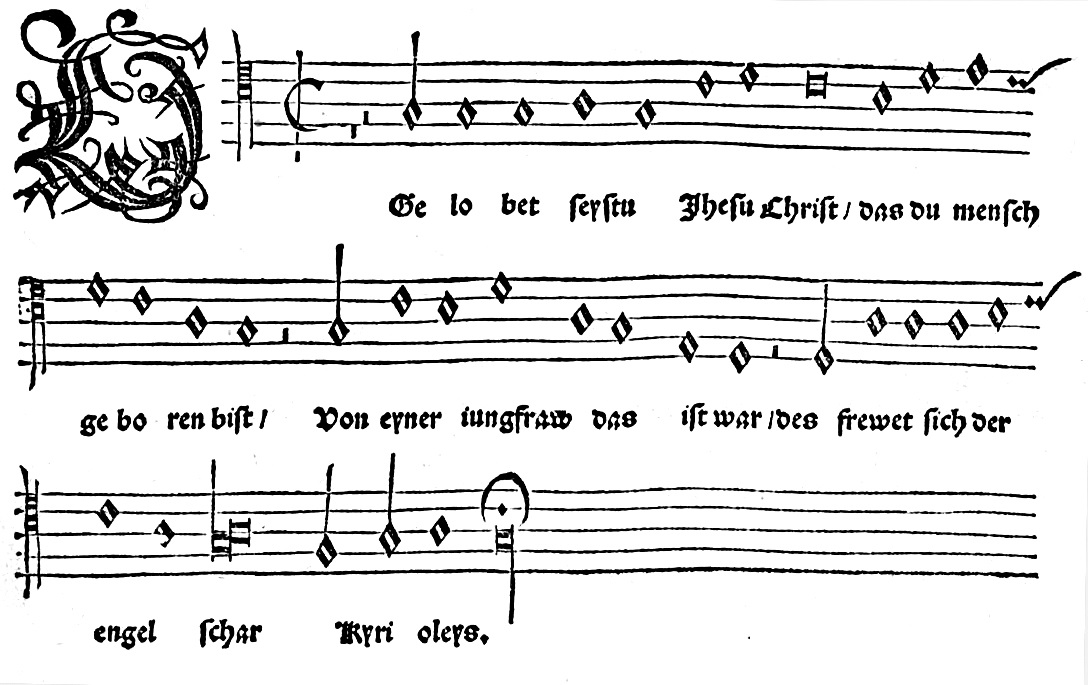 The reformer Martin Luther, a prolific hymnodist, regarded music and especially hymns in German as important means for the development of faith. Luther wrote songs for occasions of the liturgical year (Advent, Christmas, Purification, Epiphany, Easter, Pentecost, Trinity), hymns on topics of the catechism (Ten Commandments, Lord's Prayer, creed, baptism, confession, Eucharist), paraphrases of psalms, and other songs. Whenever Luther went out from pre-existing texts, here listed as "text source" (bible, Latin and German hymns), he widely expanded, transformed and personally interpreted them.[1][2] Luther worked on the tunes, sometimes modifying older tunes, in collaboration with Johann Walter. Hymns were published in the Achtliederbuch, in Walter's choral hymnal Eyn geystlich Gesangk Buchleyn (Wittenberg) and the Erfurt Enchiridion (Erfurt) in 1524, and in the Klugsches Gesangbuch, among others. For more information, see Martin Luther § Hymnodist. https://en.wikipedia.org/wiki/List_of_hymns_by_Martin_Luther +++++++++++++++++++++++++++++++++++++++++ Luther's canon is the biblical canon attributed to Martin Luther, which has influenced Protestants since the 16th-century Protestant Reformation. While the Lutheran Confessions specifically did not define a biblical canon, it is widely regarded as the canon of the Lutheran Church. It differs from the 1546 Roman Catholic canon of the Council of Trent in that it rejects the deuterocanonical books and questions the seven New Testament books, called "Luther's Antilegomena",[1] four of which are still ordered last in German-language Luther Bibles to this day.[2][3] Despite Luther's personal commentary on certain books of the Bible, the actual books included in the Luther Bible that came to be used by the Lutheran Churches do not differ greatly from those in the Catholic Bible, though the Luther Bible places what Catholics view as the deuterocanonical books in an intertestamental section, between the Old Testament and New Testament, terming these as Apocrypha.[4][5][6] The books of the Apocrypha, in the Lutheran tradition, are non-canonical, but "worthy of reverence," thus being included in Lutheran lectionaries used during the Divine Service; the Luther Bible is widely used by Anabaptist Christians, such as the Amish, as well.[7][8] Old Testament apocrypha Main articles: Deuterocanonical books and Biblical apocrypha Luther included the deuterocanonical books in his translation of the German Bible, but he did relocate them to after the Old Testament, calling them "Apocrypha, that are books which are not considered equal to the Holy Scriptures, but are useful and good to read."[9] New Testament "disputed books": Hebrews, James, Jude, and Revelation Main article: Antilegomena In the 4th century the Council of Rome had outlined the 27 New Testament books which now appear in the Catholic canon.[10] Luther considered Hebrews, James, Jude, and the Revelation to be "disputed books", which he included in his translation but placed separately at the end in his New Testament published in 1522; these books needed to be interpreted subject to the undisputed books, which are called the "canon within a canon."[11] This group of books begins with the book of Hebrews, and in its preface Luther states, "Up to this point we have had to do with the true and certain chief books of the New Testament. The four which follow have from ancient times had a different reputation." According to some scholars such as Johann Michael Reu, but controversial,[11] Luther did not personally regard these books as canonical:[12] in the September Testament he included them but did not add numbers to them, and in the 1534 Bible he treated them the same as the Old Testament Aprocrypha. In the Preface to James of the 1522 September Testament, Luther explicitly stated it was not "apostolic" (which for Luther did not mean being written by the Apostles, but "whatever preaches Christ"):[12]: 28 "I think highly of the epistle of James, and regard it as valuable although it was rejected in early days. It does not expound human doctrines, but lays much emphasis on God's law. […] I do not hold it to be of apostolic authorship."[13] Luther goes on to say that it contradicts St Paul and cannot be defended: it teaches "works-righteousness" and does not mention "the Passion, the Resurrection or the Spirit of Christ." In Luther's preface to the New Testament, Luther ascribed to several books of the New Testament different degrees of doctrinal value: St. John's Gospel and his first Epistle, St. Paul's Epistles, especially those to the Romans, Galatians, Ephesians, and St. Peter's Epistle—these are the books which show to thee Christ, and teach everything that is necessary and blessed for thee to know, even if you were never to see or hear any other book of doctrine. Therefore, St. James' Epistle is a perfect straw-epistle compared with them, for it has in it nothing of an evangelic kind."[14] However, in the view of theologian Charles Caldwell Ryrie Luther was comparing (in his opinion) doctrinal value, not canonical validity.[15] Luther's private antipathy to James continued into the 1530s and 1540s: he added a note to James 2:12 "O this chaos";[12]: 26 in 1540 "Some day I will use James to fire my stove;"[17] in 1542 "The Epistle of James we have thrown out from this school (Wittenberg) because it has no value...I hold it is written by some Jew" (not a Christian.)[19] Theologian Jason Lane has noted "the general perception that Luther could not understand James because the letter failed to fit his conception of Pauline theology."[11] In response to doubts such as Luther's, the Catholic Church's Council of Trent on April 8, 1546 dogmatically defined the contents of the biblical canon and thus settled the matter for Catholics.[20][21][22][23][24][25] This affirmed the canonicity of Hebrews, James, Jude and Revelation, as well as various Deuterocanonical books of the Old Testament. Sola fide doctrine Main article: Sola fide In The Protestant Spirit of Luther’s Version, Philip Schaff asserts that: The most important example of dogmatic influence in Luther’s version is the famous interpolation of the word alone in Rom. 3:28 (allein durch den Glauben), by which he intended to emphasize his solifidian doctrine of justification, on the plea that the German idiom required the insertion for the sake of clearness. But he thereby brought Paul into direct verbal conflict with James, who says (James 2:24), "by works a man is justified, and not only by faith" ("nicht durch den Glauben allein"). It is well known that Luther deemed it impossible to harmonize the two apostles in this article, and characterized the Epistle of James as an "epistle of straw," because it had no evangelical character ("keine evangelische Art").[26] Martin Luther's description of the Epistle of James changes. In some cases, Luther argues that it was not written by an apostle; but in other cases, he describes James as the work of an apostle.[27][verification needed] He even cites it as authoritative teaching from God[28] and describes James as "a good book, because it sets up no doctrines of men but vigorously promulgates the law of God."[29] Lutherans hold that the Epistle is rightly part of the New Testament, citing its authority in the Book of Concord.[30] Lutheran teachings resolve James' and Paul's verbal conflict regarding faith and works in alternate ways from the Catholics and E. Orthodox: Paul was dealing with one kind of error while James was dealing with a different error. The errorists Paul was dealing with were people who said that works of the law were needed to be added to faith in order to help earn God's favor. Paul countered this error by pointing out that salvation was by faith alone apart from deeds of the law (Galatians 2:16; Romans 3:21-22). Paul also taught that saving faith is not dead but alive, showing thanks to God in deeds of love (Galatians 5:6 ['...since in Christ Jesus it is not being circumcised or being uncircumcised that can effect anything - only faith working through love.']). James was dealing with errorists who said that if they had faith they didn't need to show love by a life of faith (James 2:14-17). James countered this error by teaching that faith is alive, showing itself to be so by deeds of love (James 2:18,26). James and Paul both teach that salvation is by faith alone and also that faith is never alone but shows itself to be alive by deeds of love that express a believer's thanks to God for the free gift of salvation by faith in Jesus.[31] Similar canons at the time In his book Canon of the New Testament, Bruce Metzger notes that in 1596 Jacob Lucius published a Bible at Hamburg which labeled as Apocrypha Luther's four Antilegomena: Hebrews, James, Jude and Revelation; Lucius explained this category of "Apocrypha" as "That is, books that are not held equal to the other holy Scripture". David Wolder, the pastor of Hamburg's Church of St. Peter, published in the same year a triglot Bible which labeled those books as "non canonical". J. Vogt published a Bible at Goslar in 1614 similar to Lucius'. In Sweden, Gustavus Adolphus published in 1618 the Gustavus Adolphus Bible with those four books labeled as "Apocr(yphal) New Testament." Metzger considers those decisions a "startling deviation among Lutheran editions of the Scriptures".[32] https://en.wikipedia.org/wiki/Luther%27s_canon |
讃美歌奏者 主な記事 マルティン・ルターの賛美歌リスト  ルターの賛美歌 "Ein feste Burg ist unser Gott "の初期の印刷物。 「力強い砦は我らの神」 ルターは、詩篇46篇に基づく "Ein feste Burg ist unser Gott"(「力強い砦は我らの神」)や、ルカによる福音書2章11~12節に基づく "Vom Himmel hoch, da komm ich her"(「天より地へ我は来たる」)などの讃美歌を創作した。この結びつきのために彼が選んだ手段は、礼拝、学校、家庭、公共の場に関連してドイツ語の 賛美歌を歌うことであった[161]。彼はしばしば、歌われた賛美歌の伴奏にリュートを用いたが、これは後に20世紀にドイツの民族楽器となったワルツィ ターとして再現された[162]。 ルターの賛美歌は、彼の人生や宗教改革の展開における特定の出来事から想起されることが多かった。この行動は、ルター派の見解のためにローマ・カトリック 教会によって殉教させられた最初の人物であるヤン・ファン・エッセンとヘンドリック・フォスの処刑を知ったことから始まり、ルターに賛美歌 "Ein neues Lied wir heben an"(「私たちが掲げる新しい歌」)を書かせた。この賛美歌は、ジョン・C・メッセンジャーの翻訳によって、タイトルと最初の一行 "Flung to the Heedless Winds"(「無関心な風に飛ばされて」)で一般的に知られており、マリア・C・ティッドマンによって1875年に作曲されたIbstoneという曲に 合わせて歌われている[163]。 ルターが1524年に発表した信条讃歌「Wir glauben all an einen Gott」(「私たちは皆、唯一の真の神を信じる」)は、ルターが1529年に『小カテキズム』で使徒信条を3部構成で説明する前に作られた3連の信仰告 白である。ルターの讃美歌は、それ以前のドイツ語の信条讃美歌を改作・拡大したもので、1525年には早くもルター派の地方典礼で広く使われるようになっ た。16世紀のルター派の讃美歌集にも「Wir glauben all」はカテケリカルな讃美歌の中に含まれていたが、18世紀の讃美歌集はこの讃美歌をカテケリカルな讃美歌ではなく三位一体論的な讃美歌とする傾向が あり、20世紀のルター派はその曲の難しさのためにこの讃美歌をほとんど使わなかった[161]。  "Vater unser im Himmelreich"「天の御国のわれらの父」の自筆譜、ルター自筆の唯一の音符が残っている。 ルターが1538年に作成した主の祈りの賛美歌「Vater unser im Himmelreich」は、『小カテキズム』におけるルターの祈りの説明と正確に対応しており、7つの祈りの願いごとに1つのスタンザがあり、さらに冒 頭と終わりのスタンザがある。この賛美歌は、主の祈りの典礼的な設定として、またカテキズムの特定の質問について受験生を吟味する手段として機能してい る。現存する写本には何度も改訂が加えられており、ルターがテキストを明確にして強化し、適切な祈りに満ちた曲を提供しようとしたことがわかる。16世紀 と20世紀に書かれた他の主の祈りの詩もルターの曲を採用しているが、現代のテキストはかなり短い[164]。 ルターは1523年に詩篇130篇の賛美歌版として "Aus tiefer Not schrei ich zu dir"(「災いの深みから私はあなたに叫ぶ」)を作曲し、ドイツの礼拝で使われる詩篇賛美歌を書くよう同僚を励ますための見本として送った。パウル・ス ペラトゥスとの共同作業により、この詩篇と他の7つの賛美歌が、ルター派最初の賛美歌集であるAchtliederbuchに掲載された。1524年、ル ターは4連詩篇のパラフレーズを5連の宗教改革賛美歌に発展させ、「ただ恵みのみ」というテーマをより全面的に展開した。この「Aus tiefer Not」の拡大版は、宗教改革の本質的な教義を表現したものであったため、いくつかの地域のルター派の典礼の常用曲として指定され、ルター自身を含む葬儀 で広く用いられた。ルターの拡大讃美歌は、エルハルト・ヘーゲンヴァルトの詩篇51篇の讃美歌版とともに、ルターのカテキズムの第5部の告解に関する部分 にも採用された[165]。 ルターは "Ach Gott, vom Himmel sieh darein"(「ああ神よ、天から見下ろしてください。) Veni redemptor gentiumに基づく "Nun komm, der Heiden Heiland"(さあ来たれ、異邦人の救い主)は、待降節の主要な賛美歌となった。彼はA solus ortus cardineを "Christum wir sollen loben schon"(今こそキリストを賛美しよう)に、Veni Creator Spiritusを "Komm, Gott Schöpfer, Heiliger Geist"(聖霊よ、主なる神よ)に改作した[166]。彼の「Gelobet seist du, Jesu Christ」(イエス・キリストよ、あなたを賛美します)はクリスマスの主要賛美歌となった。聖霊降臨祭には「Nun bitten wir den Heiligen Geist」を書き、復活祭には「Victimae paschali laudes」を基にした「Christ ist erstanden(キリストはよみがえられた)」を採用した。ヌンク・ディミティスのパラフレーズである "Mit Fried und Freud ich fahr dahin "は、清めのためのものだったが、葬送讃歌にもなった。彼はテ・デウムを簡略化した旋律で「Herr Gott, dich loben wir」と言い換えた。これはドイツのテ・デウムとして知られるようになった。 ルターの1541年の賛美歌 "Christ unser Herr zum Jordan kam"(「ヨルダンへ我らの主キリストが来られた」)は、小カテキズムの洗礼に関する問答の構成と内容を反映している。ルターは、詩篇第67篇の恵みを 求める祈りの賛美歌に関連して、既存のヨハン・ヴァルターの曲を採用した。ヴォルフ・ハインツの4部構成の賛美歌は、1541年にハレでルター派の宗教改 革を紹介するために使われた。J.S.バッハを含む18世紀の説教者や作曲家たちは、この豊かな賛美歌を自らの作品の主題として用いたが、その客観的な洗 礼の神学は、19世紀後半のルター派の敬虔主義の影響下でより主観的な賛美歌に取って代わられた[161]。 ルターの賛美歌は初期のルター派の賛美歌集に収録され、宗教改革の思想を広めた。ルターの賛美歌は、初期のルター派賛美歌集に収録され、宗教改革の思想を 広めた。ルターは、第一ルター派賛美歌集『Achtliederbuch』の8曲中4曲、『Erfurt Enchiridion』の26曲中18曲、そしてヨハン・ヴァルターが編曲した最初の合唱賛美歌集『Eyn geystlich Gesangk Buchleyn』の32曲中24曲を提供し、いずれも1524年に出版された。ルターの賛美歌は、作曲家たちに作曲のインスピレーションを与えた。ヨハ ン・ゼバスティアン・バッハは、いくつかの詩をコラールとしてカンタータに取り入れ、コラールカンタータの全曲をこの詩に基づいて作曲している。例えば、 『Christ lag in Todes Banden』BWV 4は1707年、『Ach Gott, vom Himmel sieh darein』BWV 2は1724年から1725年にかけて作曲された、 Christ unser Herr zum Jordan kam, BWV 7, Nun komm, der Heiden Heiland, BWV 62, Gelobet seist du, Jesu Christ, BWV 91, Aus tiefer Not schrei ich zu dir, BWV 38, 後に Ein feste Burg ist unser Gott, BWV 80, 1735年には Wär Gott nicht mit uns diese Zeit, BWV 14. ++++++++++++++++++++++++++++++++ 改革者マルティン・ルターは多作な賛美歌作者であり、音楽、特にドイツ語による賛美歌を、信仰を深めるための重要な手段とみなした。 ルターは、典礼年(待降節、クリスマス、清め、公現節、復活節、聖霊降臨節、三位一体節)、カテキズム(十戒、主の祈り、信条、洗礼、告白、聖体)のト ピックに関する賛美歌、詩篇のパラフレーズ、その他の歌を作った。ルターは、ここで「テキストソース」として挙げられている既存のテキスト(聖書、ラテン 語、ドイツ語の賛美歌)から外に出るたびに、それらを広く拡大し、変形し、個人的に解釈した[1][2]。 ルターは、ヨハン・ヴァルターとの共同作業により、時には古い曲調に手を加えながら調律を行った。讃美歌はAchtliederbuch、ワルターの合唱 讃美歌Eyn geystlich Gesangk Buchleyn(ヴィッテンベルク)、1524年のErfurt Enchiridion(エアフルト)、Klugsches Gesangbuchなどに掲載された。詳しくは、マルティン・ルター§讃美主義者を参照。 https://en.wikipedia.org/wiki/List_of_hymns_by_Martin_Luther +++++++++++++++++++++++++++++++++++++++++ルターの正典とは、マルティン・ルターが定めた聖書の正典のこと で、16世紀のプロテスタント宗教改革以来、プロテスタントに影響を与えてきた。ルター告解』では特に聖書の正典を定めていないが、ルター教会の正典と広 くみなされている。1546年のトレント公会議によるローマ・カトリックの正典とは、申命記を否定し、「ルターの反レゴメナ」[1]と呼ばれる7つの新約 聖書を疑問視している点で異なっている。 ルターが聖書の特定の書物について個人的に注釈を加えたにもかかわらず、ルター教会で使用されるようになったルター聖書に含まれる実際の書物は、カトリッ クの聖書に含まれる書物と大きな違いはないが、ルター聖書は、カトリックが旧約聖書と新約聖書の間にある、神統記と見なす書物を、これらをアポクリファと 呼んで、神統間のセクションに置いている。 [ルター聖書は、アーミッシュのようなアナバプテスト派のキリスト教徒にも広く用いられている[7][8]。 旧約聖書のアポクリファ 主な記事 旧約聖書のアポクリファと申命記 ルターはドイツ語訳聖書の中に申命記を含めたが、旧約聖書の後に移し、「アポクリファ、それは聖典と同等とはみなされないが、読むには有用で良い書物であ る」と呼んだ[9]。 新約聖書の「論争中の書物」: ヘブル書、ヤコブ書、ユダ書、ヨハネの黙示録 主な記事 反レゴメナ 4世紀、ローマ公会議は、現在カトリックの正典となっている27の新約聖書を概説した[10]。 ルターは、ヘブル書、ヤコブ書、ユダ書、ヨハネの黙示録を「論争中の書物」とみなし、訳書には含めるが、1522年に出版された『新約聖書』では末尾に別 掲した。それに続く4つの書物は、古来より異なった評判を受けてきた。"と述べている。 ヨハン・ミヒャエル・ロイのような一部の学者によれば、ルターは個人的にはこれらの書物を正典とは見なしていなかった[11]。1522年の『九月訳聖 書』のヤコブへの序文で、ルターはそれが「使徒的」(ルターにとって使徒によって書かれたという意味ではなく、「キリストを説くものなら何でも」という意 味)ではないと明言している[12]: 28。 「私はヤコブの手紙を高く評価しており、初期には拒絶されたが、貴重なものと考えている。ヤコブの手紙は、人間的な教義を説くのではなく、神の律法に重き を置いている。[......)私はこの書簡が使徒的な作者によるものだとは思わない」[13]。 ルターはさらに、この書物は聖パウロと矛盾しており、擁護することはできないと述べている。この書物は「業義」を教えており、「受難、復活、キリストの 霊」について言及していない。 ルターは『新約聖書』序文の中で、新約聖書のいくつかの書物について、教義的価値の程度を異にしている: 聖ヨハネの福音書とその最初の手紙、聖パウロの書簡、特にローマの信徒への手紙、ガラテヤの信徒への手紙、エフェソの信徒への手紙、聖ペテロの手紙、これ らは、キリストを汝に示し、汝が知るべき必要なこと、祝福されたことをすべて教えてくれる書物である。それゆえ、聖ヤコブの手紙は、それらに比べれば完全 なわらの手紙であり、その中には福音的なものは何もないからである」[14]。 しかし、神学者チャールズ・コールドウェル・ライリーの見解では、ルターが比較したのは(彼の見解では)教義上の価値であって、正典としての妥当性ではな かった[15]。 ルターのヤコブに対する私的な反感は、1530年代から1540年代にかけても続いた。彼はヤコブ書2:12に「ああ、この混沌よ」と注釈を加え [12]、1540年には「いつの日か、私はヤコブをストーブの火に使おう」[17]、1542年には「ヤコブの手紙は価値がないので、私たちはこの学校 (ヴィッテンベルク)から捨てた。 神学者のジェイソン・レインは、「ルターがヤコブの手紙を理解できなかったのは、この手紙が彼のパウロ神学の概念に合わなかったからだという一般的な認 識」を指摘している[11]。 ルターのような疑念に対して、1546年4月8日のカトリック教会のトレント公会議は、聖書の正典の内容を教義的に定義し、カトリックにとってこの問題に 決着をつけた。 ソラ・フィデの教義 主な記事 ソラ・フィデ ルター版のプロテスタント精神』の中で、フィリップ・シャフは次のように主張している: ルター版における教義的影響の最も重要な例は、ローマ3:28のallein durch den Glauben(アッレイン・ドゥルヒ・デン・グラウベン)という有名な独語の挿入である。しかし、ルターはそれによって、ヤコブの言う「人は行ないに よって義とされるのであって、信仰によって義とされるのではない」(ヤコブ2:24)とパウロを直接対立させたのである。ルターが、この記事において二人 の使徒を調和させることは不可能であると考え、ヤコブの手紙を「わらの手紙」(「keine evangelische art」)と評したことはよく知られている[26]。 ヤコブの手紙に関するマルティン・ルターの記述は変化する。ルターは、ヤコブの手紙は使徒によって書かれたものではないと主張する場合もあれば、ヤコブを 使徒の著作であると記述する場合もある[27][要検証]。ルターはヤコブを神からの権威ある教えとして引用し[28]、ヤコブを「人間の教義を掲げるこ となく、神の律法を力強く広めているので、良い書物である」と記述している[29]。 ルター派の教えは、信仰と行いに関するヤコブとパウロの言葉の対立を、カトリックや東方正教会とは別の方法で解決している: パウロはある種の誤りに対処していたが、ヤコブは別の誤りに対処していた。パウロが相手にしていた誤りは、神の好意を得るためには信仰に律法の行いを加え る必要があると言う人々であった。パウロは、救いは律法の行いを離れた信仰のみによるものだと指摘することで、この誤りに対抗した(ガラテヤ2:16、 ローマ3:21-22)。パウロはまた、救いの信仰は死んだものではなく、生きたものであり、愛の行いで神に感謝を示すものであると教えた(ガラテヤ5: 6「...キリスト・イエスにあっては、割礼を受けていることでも、割礼を受けていないことでもなく、ただ信仰が愛によって働くのです」)。ヤコブは、信 仰があれば信仰生活によって愛を示す必要はないと言う誤謬主義者を相手にしていた(ヤコブ2:14-17)。ヤコブはこの誤りに対抗して、信仰は生きてお り、愛の行いによってそれを示すものだと教えた(ヤコブ2:18,26)。ヤコブとパウロはともに、救いは信仰のみによるものであり、また信仰は決して一 人ではなく、イエスへの信仰による救いという無償の賜物に対する信者の神への感謝を表す愛の行いによって生きていることを示すものであることを教えている [31]。 当時の類似の公準 ブルース・メッツガーは、彼の著書『新約聖書の正典』の中で、1596年にヤコブ・ルシウスがハンブルクで出版した聖書に、ルターの4つのアンチレゴメナ (ヘブル人への手紙、ヤコブ人への手紙、ユダ人への手紙、ヨハネの黙示録)をアポクリファ(Apocrypha)と記したことを指摘している。ハンブルク の聖ペテロ教会の牧師であったダヴィッド・ヴォルダーは、同年、これらの書物を「非正典」とするトリグロット聖書を出版した。J.ヴォクトは1614年に ゴスラーでルシウスと同様の聖書を出版した。スウェーデンでは、グスタフス・アドルフスが1618年にグスタフス・アドルフス聖書を出版した。メッツガー はこれらの決定を「ルター派の聖書版の中でも驚くべき逸脱」とみなしている[32]。 https://en.wikipedia.org/wiki/Luther%27s_canon |
On the soul after death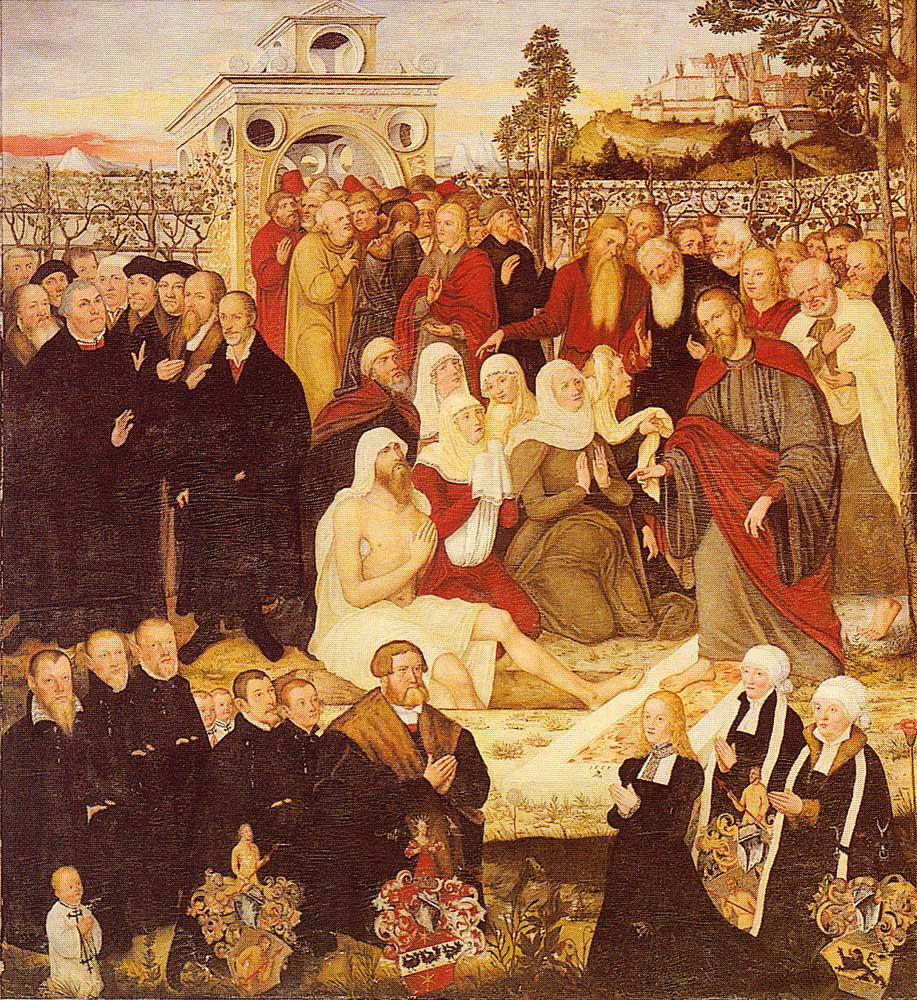 Luther on the left with Lazarus being raised by Jesus from the dead, painting by Lucas Cranach the Elder, 1558 In contrast to the views of John Calvin[167] and Philipp Melanchthon,[168] throughout his life Luther maintained that it was not false doctrine to believe that a Christian's soul sleeps after it is separated from the body in death.[169] Accordingly, he disputed traditional interpretations of some Bible passages, such as the parable of the rich man and Lazarus.[170] This also led Luther to reject the idea of torments for the saints: "It is enough for us to know that souls do not leave their bodies to be threatened by the torments and punishments of hell, but enter a prepared bedchamber in which they sleep in peace."[171] He also rejected the existence of purgatory, which involved Christian souls undergoing penitential suffering after death.[172] He affirmed the continuity of one's personal identity beyond death. In his Smalcald Articles, he described the saints as currently residing "in their graves and in heaven."[173] The Lutheran theologian Franz Pieper observes that Luther's teaching about the state of the Christian's soul after death differed from the later Lutheran theologians such as Johann Gerhard.[174] Lessing (1755) had earlier reached the same conclusion in his analysis of Lutheran orthodoxy on this issue.[175] Luther's Commentary on Genesis contains a passage which concludes that "the soul does not sleep (anima non sic dormit), but wakes (sed vigilat) and experiences visions".[176] Francis Blackburne argues that John Jortin misread this and other passages from Luther,[177] while Gottfried Fritschel points out that it actually refers to the soul of a man "in this life" (homo enim in hac vita) tired from his daily labour (defatigus diurno labore) who at night enters his bedchamber (sub noctem intrat in cubiculum suum) and whose sleep is interrupted by dreams.[178] Henry Eyster Jacobs' English translation from 1898 reads: "Nevertheless, the sleep of this life and that of the future life differ; for in this life, man, fatigued by his daily labour, at nightfall goes to his couch, as in peace, to sleep there, and enjoys rest; nor does he know anything of evil, whether of fire or of murder."[179 |
死後の魂について イエスによって死からよみがえったラザロと左側のルター(ルーカス・クラナッハ・父作、1558年) ジョン・カルヴァン[167]やフィリップ・メランヒトン[168]の見解とは対照的に、ルターは生涯を通じて、キリスト者の魂が死によって肉体から切り 離された後も眠っていると信じることは間違った教義ではないと主張していた[169]。したがって、彼は金持ちとラザロのたとえ話[170]のようないく つかの聖書の箇所の伝統的な解釈に異論を唱えていた: 「魂は地獄の苦しみや罰に脅かされるために肉体を離れるのではなく、用意された寝室に入り、そこで安らかに眠るのだということを知るだけで十分である」 [171] また、キリスト者の魂が死後に悔悛の苦しみを受ける煉獄の存在も否定した[172]。スマルカルド箇条の中で、彼は聖人について「墓の中にも天国にもい る」と述べている[173]。 ルター派の神学者フランツ・ピーパーは、キリスト者の死後の魂の状態についてのルターの教えは、ヨハン・ゲルハルトのような後のルター派の神学者とは異 なっていたと述べている[174]。 ルターの『創世記注解』には、「魂は眠らず(anima non sic dormit)、目覚め(sed vigilat)、幻視を経験する」と結論づける一節がある。 [176]。フランシス・ブラックバーンは、ジョン・ジョルティンがルターのこの箇所や他の箇所を誤読したと主張し[177]、ゴットフリート・フリッ チェルは、この箇所は実際には、日々の労働(defatigus diurno labore)に疲れた「現世の」人間(homo enim in hac vita)の魂が、夜になると寝室に入り(sub noctem intrat in cubiculum suum)、夢によって眠りが妨げられることを指していると指摘している[178]。 ヘンリー・アイスター・ジェイコブスの1898年の英訳はこうである: 「とはいえ、現世の眠りと来世の眠りは異なる。現世では、日々の労働で疲労した人間は、日暮れになると、安らかな眠りにつくために自分のソファに行き、そ こで休息を楽しむ。 |
| Sacramentarian controversy and
the Marburg Colloquy See also: The Sacrament of the Body and Blood of Christ—Against the Fanatics 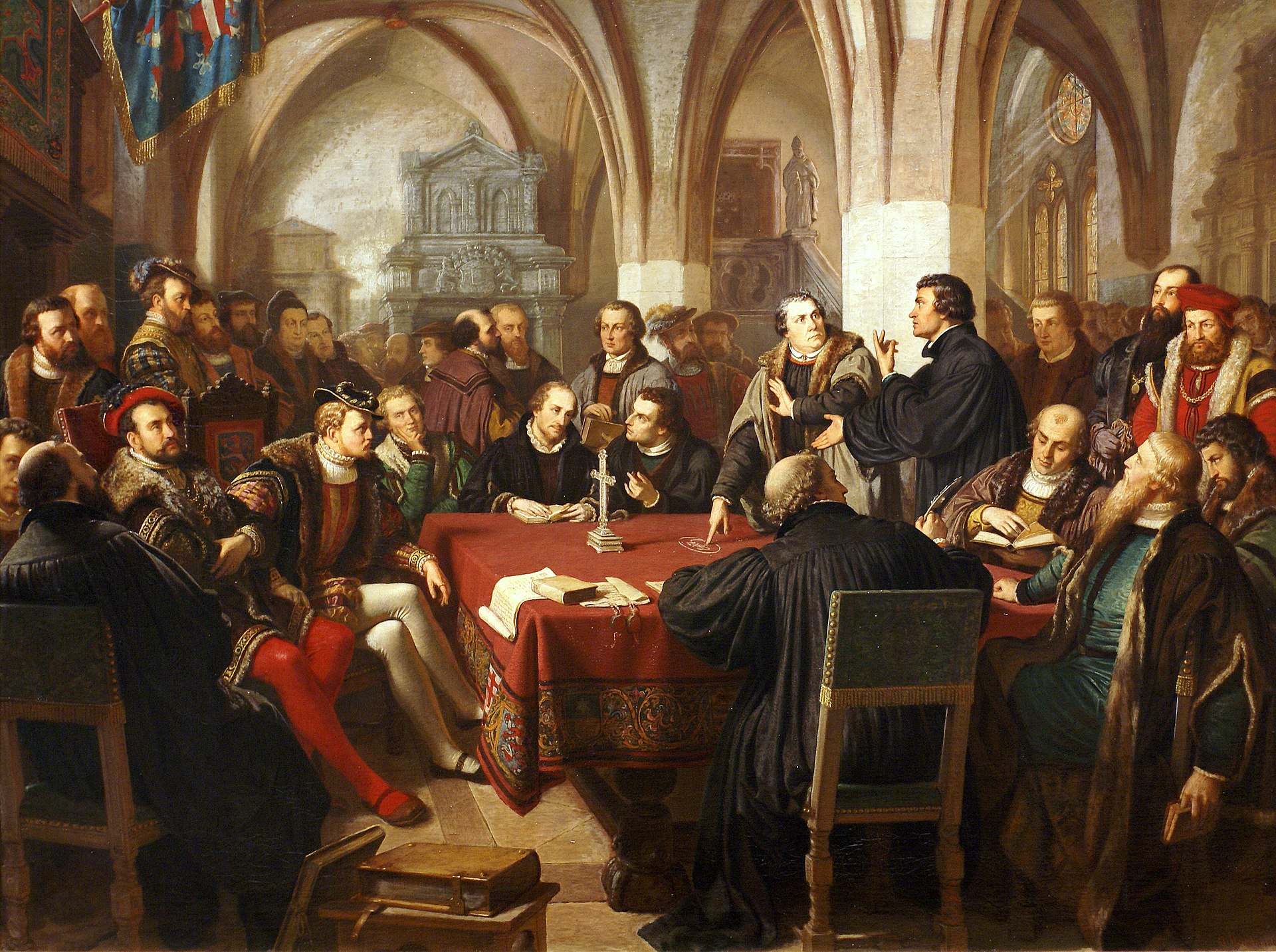 The Marburg Colloquy, by August Noack In October 1529, Philip I, Landgrave of Hesse, convoked an assembly of German and Swiss theologians at the Marburg Colloquy, to establish doctrinal unity in the emerging Protestant states.[180] Agreement was achieved on fourteen points out of fifteen, the exception being the nature of the Eucharist—the sacrament of the Lord's Supper—an issue crucial to Luther.[181] The theologians, including Zwingli, Melanchthon, Martin Bucer, and Johannes Oecolampadius, differed on the significance of the words spoken by Jesus at the Last Supper: "This is my body which is for you" and "This cup is the new covenant in my blood" (1 Corinthians 11:23–26).[182] Luther insisted on the Real presence of the body and blood of Christ in the consecrated bread and wine, which he called the sacramental union,[183] while his opponents believed God to be only spiritually or symbolically present.[184] Zwingli, for example, denied Jesus' ability to be in more than one place at a time. Luther stressed the omnipresence of Jesus' human nature.[185] According to transcripts, the debate sometimes became confrontational. Citing Jesus' words "The flesh profiteth nothing" (John 6.63), Zwingli said, "This passage breaks your neck". "Don't be too proud," Luther retorted, "German necks don't break that easily. This is Hesse, not Switzerland."[186] On his table Luther wrote the words "Hoc est corpus meum" ("This is my body") in chalk, to continually indicate his firm stance.[187] Despite the disagreements on the Eucharist, the Marburg Colloquy paved the way for the signing in 1530 of the Augsburg Confession, and for the formation of the Schmalkaldic League the following year by leading Protestant nobles such as John of Saxony, Philip of Hesse, and George, Margrave of Brandenburg-Ansbach. The Swiss cities, however, did not sign these agreements.[188] |
聖餐論論争とマールブルク懇話会 こちらもご覧ください: キリストのからだと血の秘跡-狂信者たちに対して  アウグスト・ノアック著『マールブルク・コロキア』 1529年10月、ヘッセン州知事フィリップ1世は、新興プロテスタント諸国の教義的一致を確立するために、ドイツとスイスの神学者たちを招集し、マール ブルク・コロキーを開催した。 [181]ツヴィングリ、メランヒトン、マルティン・ブッカー、ヨハネス・オエコランパディウスを含む神学者たちは、最後の晩餐でイエスが語った言葉の意 味について意見が分かれた: 「ルターは、聖別されたパンとぶどう酒の中にキリストのからだと血が現実に存在することを主張し、それを聖餐結合と呼んだ[183]。 例えばツヴィングリは、一度に複数の場所に存在するイエスの能力を否定した。ルターはイエスの人間性の遍在を強調した[185]。記録によると、論争は時 に対立的になった。肉は何の益にもならない」(ヨハネ6.63)というイエスの言葉を引用して、ツヴィングリは「この箇所はあなたの首を折る」と言った。 「ドイツ人の首はそう簡単には折れない。ここはヘッセン州であり、スイスではないのだ」[186]。ルターはテーブルの上にチョークで「Hoc est corpus meum」(「これは私の体である」)と書き、自分の確固たる姿勢を示し続けた[187]。 聖体に関する意見の相違にもかかわらず、マールブルク会議は1530年のアウクスブルク告解の調印への道を開き、翌年にはザクセン公ヨハネ、ヘッセン公 フィリップ、ブランデンブルク=アンスバッハ侯ゲオルクといったプロテスタントの有力貴族たちによるシュマルカルディック同盟の結成への道を開いた。しか し、スイスの諸都市はこれらの協定に調印しなかった[188]。 |
| Epistemology Some scholars have asserted that Luther taught that faith and reason were antithetical in the sense that questions of faith could not be illuminated by reason. He wrote, "All the articles of our Christian faith, which God has revealed to us in His Word, are in presence of reason sheerly impossible, absurd, and false."[189] and "[That] Reason in no way contributes to faith. [...] For reason is the greatest enemy that faith has; it never comes to the aid of spiritual things."[190] However, though seemingly contradictorily, he also wrote in the latter work that human reason "strives not against faith, when enlightened, but rather furthers and advances it",[191] bringing claims he was a fideist into dispute. Contemporary Lutheran scholarship, however, has found a different reality in Luther. Luther rather seeks to separate faith and reason in order to honor the separate spheres of knowledge that each applies to. |
認識論 ルターは、信仰と理性は相反するものであり、信仰に関する疑問は理性によって照らし出されることはないと説いたと主張する学者もいる。彼は、「神が御言葉の中で私たちに啓示された私たちのキリスト教信仰のすべての条項は、理性の前では、 まったく不可能であり、不条理であり、偽りである。[なぜなら、理性は信仰にとって最大の敵であり、霊的なものに対して決して助けに来ないからである」[190]。 しかし、一見矛盾しているように見えるが、彼はまた後者の著作の中で、人間の理性は 「啓蒙されたとき、信仰に逆らおうとするのではなく、むしろ信仰を促進し、前進させる」とも書いており[191]、彼がフィデイストであっ たという主張が論争を呼んでいる。しかし、現代のルター派の学問は、ルターの中に異なる現実を見出している。ルターはむしろ、信仰と理性を分離し、それぞれが適用する知識の別々の領域を尊重しようとし ている。 |
| On Islam Further information: Protestantism and Islam 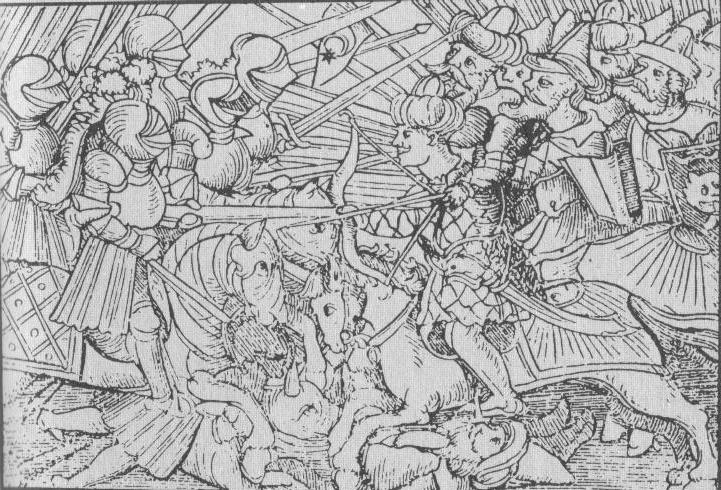 The battle between the Turks and the Christians, in the 16th century At the time of the Marburg Colloquy, Suleiman the Magnificent was besieging Vienna with a vast Ottoman army.[192] Luther had argued against resisting the Turks in his 1518 Explanation of the Ninety-five Theses, provoking accusations of defeatism. He saw the Turks as a scourge sent by God to punish Christians, as agents of the biblical apocalypse that would destroy the Antichrist, whom Luther believed to be the papacy and the Roman Church.[193] He consistently rejected the idea of a Holy War, "as though our people were an army of Christians against the Turks, who were enemies of Christ. This is absolutely contrary to Christ's doctrine and name".[194] On the other hand, in keeping with his doctrine of the two kingdoms, Luther did support non-religious war against the Turks.[195] In 1526, he argued in Whether Soldiers can be in a State of Grace that national defence is reason for a just war.[196] By 1529, in On War against the Turk, he was actively urging Emperor Charles V and the German people to fight a secular war against the Turks.[197] He made clear, however, that the spiritual war against an alien faith was separate, to be waged through prayer and repentance.[198] Around the time of the Siege of Vienna, Luther wrote a prayer for national deliverance from the Turks, asking God to "give to our emperor perpetual victory over our enemies".[199] In 1542, Luther read a Latin translation of the Qur'an.[200] He went on to produce several critical pamphlets on Islam, which he called "Mohammedanism" or "the Turk".[201] Though Luther saw the Muslim religion as a tool of the devil, he was indifferent to its practice: "Let the Turk believe and live as he will, just as one lets the papacy and other false Christians live."[202] He opposed banning the publication of the Qur'an, wanting it exposed to scrutiny.[203] |
イスラム教についてさらに詳しい情報 プロテスタントとイスラム 16世紀、トルコとキリスト教徒の戦い マールブルク会議が開催された当時、スレイマン大帝はオスマン・トルコの大軍を率いてウィーンを包囲していた[192]。ルターは1518年に発表した 『九十五箇条の論題』の中で、トルコ軍に抵抗することを反対し、敗北主義との非難を招いた。ルターはトルコ人を、キリスト教徒を罰するために神から送られ た災いであり、ルターがローマ教皇庁とローマ教会であると信じていた反キリストを滅ぼす聖書の黙示録の代理人であると考えていた。1526年、彼は『兵士 は恩寵の状態にありうるか』の中で、国防は正義の戦争の理由であると主張した[196]。 1529年までには、『トルコ人との戦争について』の中で、彼は皇帝シャルル5世とドイツ国民にトルコ人との世俗的な戦争を戦うよう積極的に促していた。 [198]ウィーン包囲戦の頃、ルターはトルコ人からの民族的解放のための祈りを書き、神に「わが皇帝に敵に対する永続的な勝利をお与えください」と願っ た[199]。 1542年、ルターはコーランのラテン語訳を読んだ[200]。その後、ルターはイスラム教を「ムハンマド主義」あるいは「トルコ人」と呼んだ [201]: 「ローマ教皇庁や他の偽キリスト教徒を生かすように、トルコ人を好きに信じさせ、生かせばよい」[202]。 |
| Antinomian controversy Pulpit of St Andreas Church, Eisleben, where Johannes Agricola and Luther preached Early in 1537, Johannes Agricola—serving at the time as pastor in Luther's birthplace, Eisleben—preached a sermon in which he claimed that God's gospel, not God's moral law (the Ten Commandments), revealed God's wrath to Christians. Based on this sermon and others by Agricola, Luther suspected that Agricola was behind certain anonymous antinomian theses circulating in Wittenberg. These theses asserted that the law is no longer to be taught to Christians but belonged only to city hall.[204] Luther responded to these theses with six series of theses against Agricola and the antinomians, four of which became the basis for disputations between 1538 and 1540.[205] He also responded to these assertions in other writings, such as his 1539 open letter to C. Güttel Against the Antinomians,[206] and his book On the Councils and the Church from the same year.[207] In his theses and disputations against the antinomians, Luther reviews and reaffirms, on the one hand, what has been called the "second use of the law," that is, the law as the Holy Spirit's tool to work sorrow over sin in man's heart, thus preparing him for Christ's fulfillment of the law offered in the gospel.[208] Luther states that everything that is used to work sorrow over sin is called the law, even if it is Christ's life, Christ's death for sin, or God's goodness experienced in creation.[209] Simply refusing to preach the Ten Commandments among Christians—thereby, as it were, removing the three letters l-a-w from the church—does not eliminate the accusing law.[210] Claiming that the law—in any form—should not be preached to Christians anymore would be tantamount to asserting that Christians are no longer sinners in themselves and that the church consists only of essentially holy people.[211] Luther also points out that the Ten Commandments—when considered not as God's condemning judgment but as an expression of his eternal will, that is, of the natural law—positively teach how the Christian ought to live.[212] This has traditionally been called the "third use of the law."[213] For Luther, also Christ's life, when understood as an example, is nothing more than an illustration of the Ten Commandments, which a Christian should follow in his or her vocations on a daily basis.[214] The Ten Commandments, and the beginnings of the renewed life of Christians accorded to them by the sacrament of baptism, are a present foreshadowing of the believers' future angel-like life in heaven in the midst of this life.[215] Luther's teaching of the Ten Commandments, therefore, has clear eschatological overtones, which, characteristically for Luther, do not encourage world-flight but direct the Christian to service to the neighbor in the common, daily vocations of this perishing world. |
反知性主義論争 ヨハネス・アグリコラとルターが説教したアイスレーベンの聖アンドレアス教会の説教壇 1537年初頭、当時ルターの生誕地アイスレーベンで牧師を務めていたヨハネス・アグリコラは、神の道徳律(十戒)ではなく、神の福音がキリスト者に神の 怒りを明らかにしていると主張する説教を行った。この説教とアグリコラの他の説教に基づき、ルターはアグリコラがヴィッテンベルクで出回っていたある匿名 の反知性主義的小論に関与しているのではないかと疑った。これらの論題は、律法はもはやキリスト者に教えられるものではなく、市役所にのみ属するものであ ると主張していた[204]。ルターはこれらの論題に対して、アグリコラと反知性主義者に対する6連の論題で反論し、そのうちの4連は1538年から 1540年にかけての論争の基礎となった[205]。ルターはまた、1539年にC.ギュッテルに宛てた『反知性主義者に対する公開書簡』[206]や同 年の著書『公会議と教会について』[207]など、他の著作においてもこれらの主張に反論していた。 ルターは、反知性主義者に対するテーゼと論争において、一方では「律法の第二の用法」と呼ばれてきたもの、すなわち、人間の心に罪に対する悲しみを働かせ るための聖霊の道具としての律法、したがって、福音において提供されるキリストによる律法の成就のための準備としての律法を見直し、再確認している [208]。ルターは、罪に対する悲しみを働かせるために用いられるすべてのものは、たとえそれがキリストの生涯であっても、罪に対するキリストの死で あっても、被造物において経験される神の善であっても、律法と呼ばれると述べている。 [209] 単にクリスチャンの間で十戒を説教することを拒否すること、それによっていわば教会からl-a-wの三文字を取り除くことは、非難する律法を排除すること にはならない[210]。 いかなる形であれ、律法はもうクリスチャンに説教されるべきではないと主張することは、クリスチャンはもはやそれ自体罪人ではなく、教会は本質的に聖なる 人々のみから構成されていると主張することに等しい[211]。 ルターはまた、十戒が、神の断罪の裁きとしてではなく、神の永遠の意志の表現として、すなわち自然法則の表現として見なされるとき、キリスト者がどのよう に生きるべきかを積極的に教えていると指摘する[212]。 それゆえ、ルターの十戒の教えは、明確な終末論的含意をもっており、それはルターにとって特徴的なことであるが、この世からの逃亡を奨励するものではな く、この滅びゆく世界の日常的な職業における隣人への奉仕へとキリスト者を導くものである。 |
| Bigamy of Philip I, Landgrave of
Hesse From December 1539, Luther became involved in the designs of Philip I, Landgrave of Hesse to marry a lady-in-waiting of his wife, Christine of Saxony. Philip solicited the approval of Luther, Melanchthon, and Bucer, citing as a precedent the polygamy of the patriarchs. The theologians were not prepared to make a general ruling, and they reluctantly advised the landgrave that if he was determined, he should marry secretly and keep quiet about the matter because divorce was worse than bigamy.[216] As a result, on 4 March 1540, Philip married a second wife, Margarethe von der Saale, with Melanchthon and Bucer among the witnesses. However, Philip's sister Elisabeth quickly made the scandal public, and Philip threatened to expose Luther's advice. Luther told him to "tell a good, strong lie" and deny the marriage completely, which Philip did.[217] Margarethe gave birth to nine children over a span of 17 years, giving Philip a total of 19 children. In the view of Luther's biographer Martin Brecht, "giving confessional advice for Philip of Hesse was one of the worst mistakes Luther made, and, next to the landgrave himself, who was directly responsible for it, history chiefly holds Luther accountable".[218] Brecht argues that Luther's mistake was not that he gave private pastoral advice, but that he miscalculated the political implications.[219] The affair caused lasting damage to Luther's reputation.[220] |
ヘッセン大公フィリップ1世の重婚 1539年12月、ルターは、ヘッセン公フィリップ1世が、彼の妻であるザクセン公クリスティーネの侍女と結婚する計画に関与した。フィリップはルター、 メランヒトン、ブーカーの賛同を求め、家父長たちの一夫多妻制を前例として挙げた。神学者たちは一般的な裁定を下す用意はなく、渋々ながら、もし決心が固 いのであれば、離婚は重婚よりも悪いことであるから、密かに結婚し、この問題について黙っているべきだとアドバイスした[216]。その結果、1540年 3月4日、フィリップはメランヒトンとブーカーの立会いのもと、2番目の妻マルガレーテ・フォン・デア・サーレと結婚した。しかし、フィリップの姉エリザ ベートはすぐにこのスキャンダルを公にし、フィリップはルターの忠告を暴露すると脅した。マルガレーテは17年の間に9人の子供をもうけ、フィリップは合 計19人の子供をもうけた[217]。ルターの伝記作家マルティン・ブレヒトによれば、「ヘッセのフィリップに告解の助言を与えたことは、ルターが犯した 最悪の過ちの一つであり、その直接の責任者である地主自身に次いで、歴史がルターに責任を負わせた」[218] 。 |
| Anti-Jewish polemics and
antisemitism Main article: Martin Luther and antisemitism See also: Christianity and antisemitism 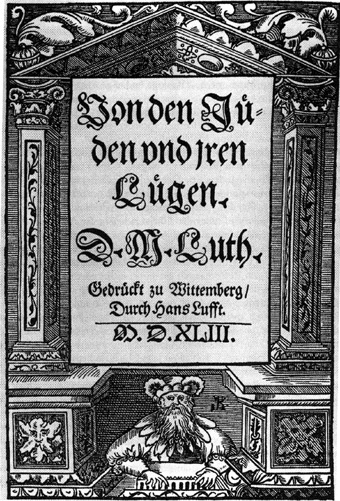 The original title page of On the Jews and Their Lies, written by Martin Luther in 1543 Luther wrote negatively about the Jews throughout his career.[221] Though Luther rarely encountered Jews during his life, his attitudes reflected a theological and cultural tradition which saw Jews as a rejected people guilty of the murder of Christ, and he lived in a locality which had expelled Jews roughly 90 years earlier.[222] He considered the Jews blasphemers and liars because they rejected the divinity of Jesus.[223] In 1523, Luther advised kindness toward the Jews in That Jesus Christ was Born a Jew and also aimed to convert them to Christianity.[224] When his efforts at conversion failed, he grew increasingly bitter toward them.[225] Luther's major works on the Jews were his 60,000-word treatise Von den Juden und Ihren Lügen (On the Jews and Their Lies), and Vom Schem Hamphoras und vom Geschlecht Christi (On the Holy Name and the Lineage of Christ), both published in 1543, three years before his death.[226] Luther argued that the Jews were no longer the chosen people but "the devil's people", and referred to them with violent language.[227][228] Citing Deuteronomy 13, wherein Moses commands the killing of idolaters and the burning of their cities and property as an offering to God, Luther called for a "scharfe Barmherzigkeit" ("sharp mercy") against the Jews "to see whether we might save at least a few from the glowing flames."[229] Luther advocated setting synagogues on fire, destroying Jewish prayerbooks, forbidding rabbis from preaching, seizing Jews' property and money, and smashing up their homes, so that these "envenomed worms" would be forced into labour or expelled "for all time".[230] In Robert Michael's view, Luther's words "We are at fault in not slaying them" amounted to a sanction for murder.[231] "God's anger with them is so intense," Luther concluded, "that gentle mercy will only tend to make them worse, while sharp mercy will reform them but little. Therefore, in any case, away with them!"[229] Luther launched a polemic against vagrants in his 1528 preface to Liber Vagatorum, saying that the Jews had contributed Hebrew words as a main basis of the Rotwelsch cryptolect. He warned in the admonitory preface Christians not to give them alms as it was, in his opinion, to forsake the truly poor.[232][233] Luther spoke out against the Jews in Saxony, Brandenburg, and Silesia.[234] Josel of Rosheim, the Jewish spokesman who tried to help the Jews of Saxony in 1537, later blamed their plight on "that priest whose name was Martin Luther—may his body and soul be bound up in hell!—who wrote and issued many heretical books in which he said that whoever would help the Jews was doomed to perdition."[235] Josel asked the city of Strasbourg to forbid the sale of Luther's anti-Jewish works: they refused initially but did so when a Lutheran pastor in Hochfelden used a sermon to urge his parishioners to murder Jews.[234] Luther's influence persisted after his death. Throughout the 1580s, riots led to the expulsion of Jews from several German Lutheran states.[236] Tovia Singer, an Orthodox Jewish rabbi, remarking about Luther's attitude toward Jews, put it thus: "Among all the Church Fathers and Reformers, there was no mouth more vile, no tongue that uttered more vulgar curses against the Children of Israel than this founder of the Reformation."[237] Influence within Nazism 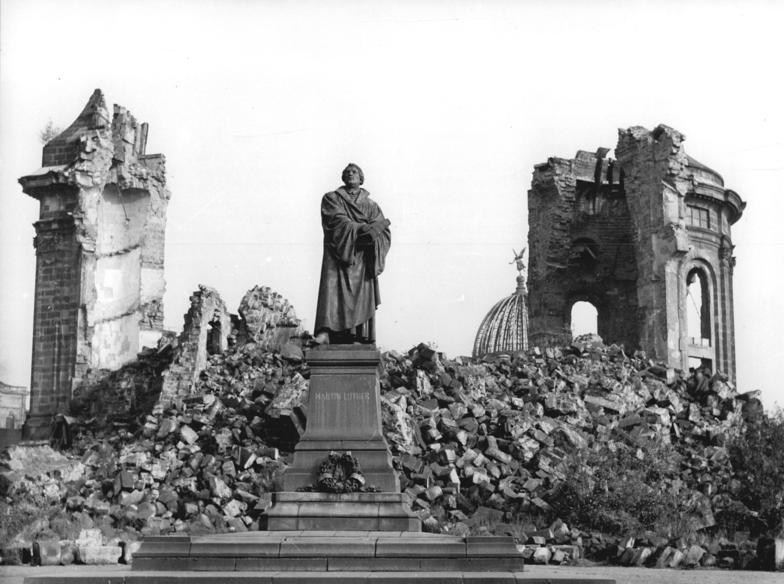 The statue outside the Frauenkirche in Dresden after the bombing of the city in World War II Luther was the most widely read author of his generation, and within Germany he acquired the status of a prophet.[238] According to the prevailing opinion among historians,[15] his anti-Jewish rhetoric contributed significantly to the development of antisemitism in Germany,[239] and in the 1930s and 1940s provided an "ideal underpinning" for the Nazis' attacks on Jews.[17] Reinhold Lewin writes that anybody who "wrote against the Jews for whatever reason believed he had the right to justify himself by triumphantly referring to Luther." According to Michael, just about every anti-Jewish book printed in Nazi Germany contained references to and quotations from Luther. Heinrich Himmler (albeit never a Lutheran, having been brought up Catholic) wrote admiringly of his writings and sermons on the Jews in 1940.[240] The city of Nuremberg presented a first edition of On the Jews and their Lies to Julius Streicher, editor of the Nazi newspaper Der Stürmer, on his birthday in 1937; the newspaper described it as the most radically antisemitic tract ever published.[241] It was publicly exhibited in a glass case at the Nuremberg rallies and quoted in a 54-page explanation of the Aryan Law by E.H. Schulz and R. Frercks.[242] On 17 December 1941, seven Protestant regional church confederations issued a statement agreeing with the policy of forcing Jews to wear the yellow badge, "since after his bitter experience Luther had already suggested preventive measures against the Jews and their expulsion from German territory." According to Daniel Goldhagen, Bishop Martin Sasse, a leading Protestant churchman, published a compendium of Luther's writings shortly after Kristallnacht, for which Diarmaid MacCulloch, professor of the history of the church at the University of Oxford argued that Luther's writing was a "blueprint."[243] Sasse applauded the burning of the synagogues and the coincidence of the day, writing in the introduction, "On 10 November 1938, on Luther's birthday, the synagogues are burning in Germany." The German people, he urged, ought to heed these words "of the greatest antisemite of his time, the warner of his people against the Jews."[244] "There is a world of difference between his belief in salvation and a racial ideology. Nevertheless, his misguided agitation had the evil result that Luther fatefully became one of the 'church fathers' of anti-Semitism and thus provided material for the modern hatred of the Jews, cloaking it with the authority of the Reformer." Martin Brecht[245] At the heart of scholarly debate about Luther's influence is whether it is anachronistic to view his work as a precursor of the racial antisemitism of the Nazis. Some scholars see Luther's influence as limited, and the Nazis' use of his work as opportunistic. Johannes Wallmann argues that Luther's writings against the Jews were largely ignored in the 18th and 19th centuries, and that there was no continuity between Luther's thought and Nazi ideology.[246] Uwe Siemon-Netto agreed, arguing that it was because the Nazis were already antisemites that they revived Luther's work.[247][248] Hans J. Hillerbrand agreed that to focus on Luther was to adopt an essentially ahistorical perspective of Nazi antisemitism that ignored other contributory factors in German history.[249] Similarly, Roland Bainton, noted church historian and Luther biographer, wrote "One could wish that Luther had died before ever [On the Jews and Their Lies] was written. His position was entirely religious and in no respect racial."[250][251] However, Christopher J. Probst, in his book Demonizing the Jews: Luther and the Protestant Church in Nazi Germany (2012), shows that a large number of German Protestant clergy and theologians during the Nazi era used Luther's hostile publications towards the Jews and their Jewish religion to justify at least in part the antisemitic policies of the National Socialists.[252] The pro-Nazi Christian group Deutsche Christen drew parallels between Martin Luther and the "Führer" Adolf Hitler.[253] Some scholars, such as Mark U. Edwards in his book Luther's Last Battles: Politics and Polemics 1531–46 (1983), suggest that since Luther's increasingly antisemitic views developed during the years his health deteriorated, it is possible they were at least partly the product of a state of mind. Edwards also comments that Luther often deliberately used "vulgarity and violence" for effect, both in his writings condemning the Jews and in diatribes against "Turks" (Muslims) and Catholics.[254] Since the 1980s, Lutheran denominations have repudiated Martin Luther's statements against the Jews[citation needed] and have rejected the use of them to incite hatred against Lutherans.[citation needed][255][256] Strommen et al.'s 1970 survey of 4,745 North American Lutherans aged 15–65 found that, compared to the other minority groups under consideration, Lutherans were the least prejudiced toward Jews.[257] Nevertheless, Professor Richard Geary, former professor of modern history at the University of Nottingham and the author of Hitler and Nazism (Routledge 1993), published an article in the magazine History Today examining electoral trends in Weimar Germany between 1928 and 1933. Geary notes that, based on his research, the Nazi Party received disproportionately more votes from Protestant than Catholic areas of Germany.[258][259] |
反ユダヤ極論と反ユダヤ主義 主な記事 マルティン・ルターと反ユダヤ主義 参照 キリスト教と反ユダヤ主義  マルティン・ルターが1543年に著した『ユダヤ人とその嘘』(原題:On the Jews and Their Lies)のタイトルページ。 ルターは、その生涯を通じてユダヤ人について否定的な文章を書いている[221]。ルターが生涯ユダヤ人に出会うことはほとんどなかったが、彼の態度は、 ユダヤ人をキリスト殺害の罪を犯した拒絶された民とみなす神学的・文化的伝統を反映しており、彼はおよそ90年前にユダヤ人を追放した地域に住んでいた。 [1523年、ルターは『イエス・キリストはユダヤ人としてお生まれになった』の中でユダヤ人に対する優しさを説き、またユダヤ人をキリスト教に改宗させ ることを目指した[224]。 ルターのユダヤ人に関する主な著作は、6万語に及ぶ『ユダヤ人とその嘘について』(Von den Juden und Ihren Lügen)と『聖なる名とキリストの血統について』(Vom Schem Hamphoras und vom Geschlecht Christi)であり、いずれも亡くなる3年前の1543年に出版された[226]。ルターは、ユダヤ人はもはや選ばれた民ではなく「悪魔の民」である と主張し、暴力的な言葉でユダヤ人に言及した。 [227][228]モーセが神への捧げ物として偶像崇拝者の殺害とその都市と財産の焼却を命じている申命記13章を引用して、ルターはユダヤ人に対する 「鋭い慈悲」("scharfe Barmherzigkeit")を求めた。 「ルターは、シナゴーグに火を放ち、ユダヤ教の祈祷書を破壊し、ラビの説教を禁じ、ユダヤ人の財産と金銭を差し押さえ、彼らの家を破壊することで、これら の「害虫」を「永遠に」労働に従事させるか、追放することを提唱した[229]。 [ロバート・ミヒャエルの見解によれば、ルターの「彼らを殺さなかったことは、われわれの過失である」という言葉は、殺人の制裁に等しいものであった [231]。「神の彼らに対する怒りは非常に激しいので、優しい慈悲は彼らを悪化させる傾向があるだけであり、鋭い慈悲は彼らをほとんど改めないであろ う。したがって、いずれにせよ、彼らから離れよ!」[229]。 ルターは、1528年の『浮浪者の書』の序文で、ユダヤ人がヘブライ語の単語をロートヴェルシュの隠語の主要な基礎として提供したと述べ、浮浪者に対する 極論を展開した。ルターは、その序文の中で、キリスト教徒が彼らに施しを与えることは、真に貧しい者を見捨てることになると考え、彼らに施しを与えないよ うに警告した[232][233]。 ルターはザクセン、ブランデンブルク、シレジアのユダヤ人たちに反対を唱えた[234]。1537年にザクセンのユダヤ人たちを助けようとしたユダヤ人の スポークスマン、ロスハイムのヨゼルは、後に彼らの窮状を「マルティン・ルターという名の司祭-その身も魂も地獄に縛りつけられますように-が、このよう なことをたくさん書いた! -ヨゼルはストラスブール市にルターの反ユダヤ著作の販売禁止を求めたが、最初は拒否されたが、ホッホフェルデンのあるルター派の牧師が説教でユダヤ人殺 害を教区民に促したため、販売することになった[234]。1580年代を通じて、暴動によっていくつかのドイツ・ルター派の州からユダヤ人が追放された [236]。 正統派ユダヤ教のラビであるトヴィア・シンガーは、ルターのユダヤ人に対する態度についてこう述べている: 「すべての教父と改革者の中で、この宗教改革の創始者ほど下劣な口、イスラエルの子に対する下品な呪いを口にした舌はなかった」[237]。 ナチズム内での影響  第二次世界大戦の空爆後、ドレスデンのフラウエン教会の外に建てられた像。 歴史家の間で一般的な意見によれば[15]、ルターの反ユダヤ的なレトリックはドイツにおける反ユダヤ主義の発展に大きく寄与し[239]、1930年代 から1940年代にかけてはナチスのユダヤ人攻撃の「理想的な下支え」となった[17]。 ラインホルト・ルウィンは、「どのような理由であれユダヤ人に反対する文章を書く者は誰でも、ルターに勝利的に言及することによって自己を正当化する権利 があると信じていた」と書いている。ミヒャエルによれば、ナチス・ドイツで印刷されたほぼすべての反ユダヤ本には、ルターへの言及や引用が含まれていたと いう。ハインリッヒ・ヒムラー(カトリックで育ったためルター派ではなかったが)は、1940年に彼のユダヤ人に関する著作や説教を称賛する文章を書いて いる[240]。 ニュルンベルク市は、1937年の彼の誕生日に、ナチス新聞『シュトゥルマー』の編集者ユリウス・シュトライヒャーに『ユダヤ人とその嘘について』の初版 本を贈った。 [241]。ニュルンベルクの集会ではガラスケースに入れられ、E.H.シュルツとR.フレレクスによる54ページに及ぶアーリア人の掟の説明の中で引用 された[242]。 1941年12月17日、プロテスタントの7つの地域教会連盟は、ユダヤ人に黄色いバッジを強制する政策に同意する声明を発表した。ダニエル・ゴールド ハーゲンによると、プロテスタントの代表的な教会者であるマルティン・サッセ司教は、水晶の夜の直後にルターの著作の大要を出版し、オックスフォード大学 の教会史教授であるディアメイド・マッカロク(Diarmaid MacCulloch)は、ルターの著作は「青写真」であると主張した[243]。彼は、ドイツ国民は「彼の時代における最大の反ユダヤ主義者であり、ユ ダヤ人に対する彼の国民の警告者であったルターの言葉」に耳を傾けるべきだと訴えた[244]。 「彼の救済に対する信念と人種イデオロギーとは天と地ほどの差がある。それにもかかわらず、彼の誤った扇動は、ルターが運命的に反ユダヤ主義の「教父」の 一人となり、その結果、改革者の権威をまとってユダヤ人に対する現代の憎悪の材料を提供するという悪い結果を招いた」[245]。 マルティン・ブレヒト[245] ルターの影響に関する学者の議論の中心は、ルターの著作をナチスの人種的反ユダヤ主義の先駆けとして見ることが時代錯誤であるかどうかである。ルターの影 響力は限定的であり、ナチスがルターの著作を利用したのは日和見主義的だったと見る学者もいる。ヨハネス・ヴァルマン(Johannes Wallmann)は、ルターのユダヤ人に対する著作は18世紀と19世紀にはほとんど無視され、ルターの思想とナチスのイデオロギーとの間には連続性が なかったと主張する[246]。 ウヴェ・シーモン=ネット(Uwe Siemon-Netto)もこれに同意し、ナチスがルターの著作を復活させたのはナチスがすでに反ユダヤ主義者だったからだと主張する[247] [248]。同様に、著名な教会史家でありルターの伝記作家であるローランド・ベイントンは、「ルターが[ユダヤ人とその嘘について]が書かれる前に死ん でいればよかったのにと思うかもしれない。彼の立場は完全に宗教的なものであり、人種的なものではなかった」[250][251] : ルターとナチス・ドイツにおけるプロテスタント教会』(2012年)では、ナチス時代のドイツのプロテスタントの聖職者や神学者の多くが、国家社会主義者 の反ユダヤ政策を少なくとも部分的には正当化するために、ルターのユダヤ人やユダヤ教に対する敵対的な出版物を利用していたことを示している[252]。 マーク・U・エドワーズの著書『Luther's Last Battles: Politics and Polemics 1531-46』(1983年)の中のマーク・U・エドワーズ(Mark U. Edwards)のように、ルターの反ユダヤ主義的な見解は、ルターの健康状態が悪化していた数年間に発展したものであり、それは少なくとも部分的には精 神状態の産物であった可能性があると指摘する学者もいる。エドワーズはまた、ルターはユダヤ人を非難する文章においても、「トルコ人」(イスラム教徒)や カトリック教徒に対する暴言においても、効果を上げるためにしばしば「下品さと暴力」を意図的に用いていたとコメントしている[254]。 1980年代以降、ルター派の教派はマルティン・ルターのユダヤ人に対する発言を否認し[要出典]、ルター派に対する憎悪を扇動するためにそれらを利用す ることを拒否している[要出典][255][256] ストロメンらが1970年に北米の15歳から65歳のルター派4,745人を対象に行った調査では、対象となった他のマイノリティ・グループと比較して、 ルター派はユダヤ人に対する偏見が最も少ないという結果が出ている。 [257] とはいえ、ノッティンガム大学の元現代史教授で、『ヒトラーとナチズム』(Routledge 1993年)の著者であるリチャード・ギアリー教授は、雑誌『ヒストリー・トゥデイ』に、1928年から1933年にかけてのワイマール・ドイツの選挙動 向を調査した論文を発表している。ギアリーの調査によれば、ナチ党はドイツのカトリック地域よりもプロテスタント地域から不釣り合いに多くの票を得ていた [258][259]。 |
Final years, illness and death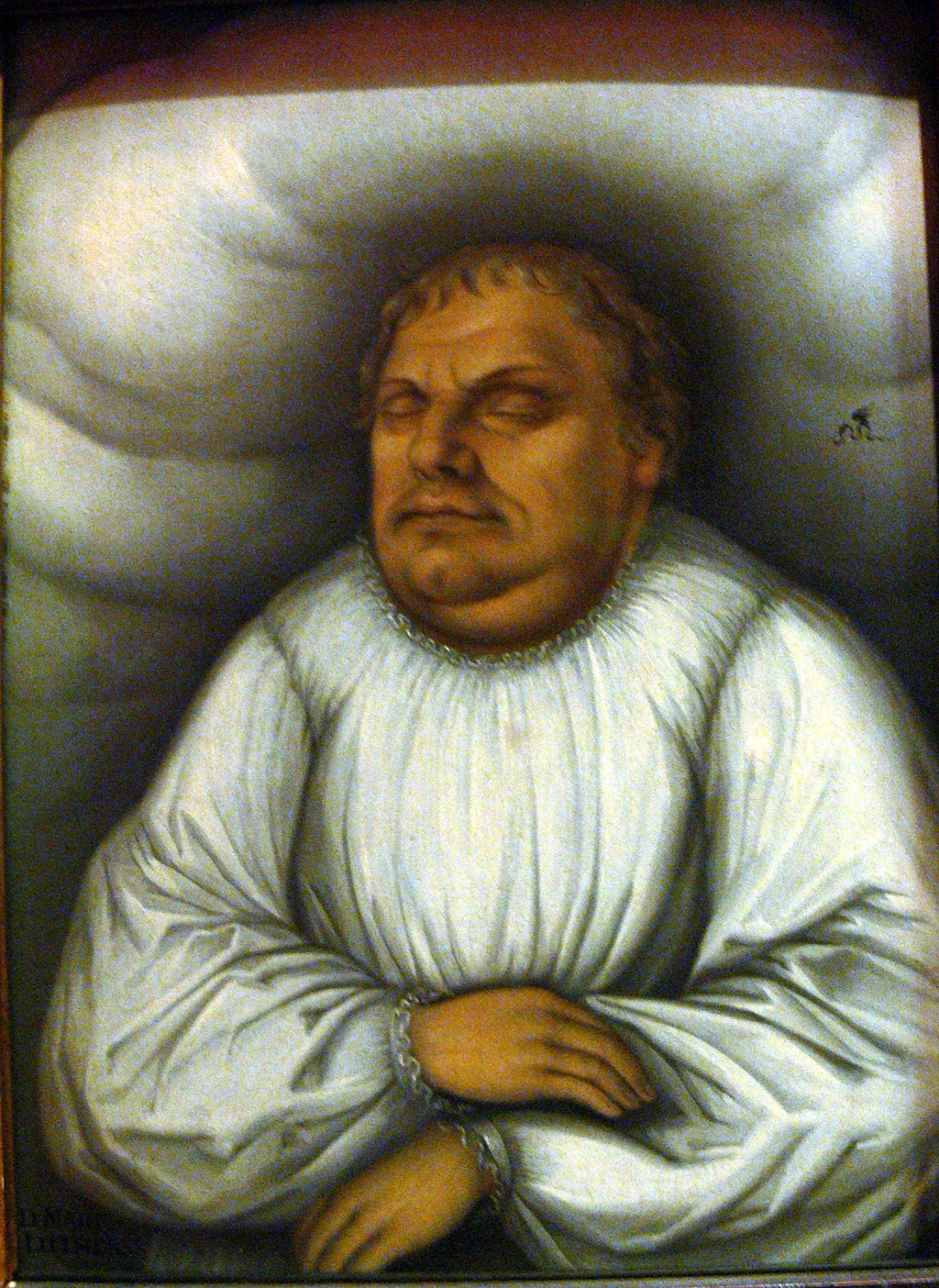 Luther on his deathbed, painting by Lucas Cranach the Elder, copy after Lucas Cranach the Younger Martin Luther's grave, Schlosskirche, Wittenberg Luther had been suffering from ill health for years, including Ménière's disease, vertigo, fainting, tinnitus, and a cataract in one eye.[260] From 1531 to 1546, his health deteriorated further. In 1536, he began to suffer from kidney and bladder stones, arthritis, and an ear infection ruptured an ear drum. In December 1544, he began to feel the effects of angina.[261] His poor physical health made him short-tempered and even harsher in his writings and comments. His wife Katharina was overheard saying, "Dear husband, you are too rude," and he responded, "They are teaching me to be rude."[262] In 1545 and 1546 Luther preached three times in the Market Church in Halle, staying with his friend Justus Jonas during Christmas.[263] His last sermon was delivered at Eisleben, his place of birth, on 15 February 1546, three days before his death.[264] It was "entirely devoted to the obdurate Jews, whom it was a matter of great urgency to expel from all German territory," according to Léon Poliakov.[265] James Mackinnon writes that it concluded with a "fiery summons to drive the Jews bag and baggage from their midst, unless they desisted from their calumny and their usury and became Christians."[266] Luther said, "we want to practice Christian love toward them and pray that they convert," but also that they are "our public enemies ... and if they could kill us all, they would gladly do so. And so often they do."[267] Luther's final journey, to Mansfeld, was taken because of his concern for his siblings' families continuing in their father Hans Luther's copper mining trade. Their livelihood was threatened by Count Albrecht of Mansfeld bringing the industry under his own control. The controversy that ensued involved all four Mansfeld counts: Albrecht, Philip, John George, and Gerhard. Luther journeyed to Mansfeld twice in late 1545 to participate in the negotiations for a settlement, and a third visit was needed in early 1546 for their completion. The negotiations were successfully concluded on 17 February 1546. After 8 p.m., he experienced chest pains. When he went to his bed, he prayed, "Into your hand I commit my spirit; you have redeemed me, O Lord, faithful God" (Ps. 31:5), the common prayer of the dying. At 1 a.m. on 18 February, he awoke with more chest pain and was warmed with hot towels. He thanked God for revealing his Son to him in whom he had believed. His companions, Justus Jonas and Michael Coelius, shouted loudly, "Reverend father, are you ready to die trusting in your Lord Jesus Christ and to confess the doctrine which you have taught in his name?" A distinct "Yes" was Luther's reply.[268] An apoplectic stroke deprived him of his speech, and he died shortly afterwards at 2:45 a.m. on 18 February 1546, aged 62, in Eisleben, the city of his birth. He was buried in the Schlosskirche in Wittenberg, in front of the pulpit.[269] The funeral was held by his friends Johannes Bugenhagen and Philipp Melanchthon.[270] A year later, troops of Luther's adversary Charles V, Holy Roman Emperor entered the town but were ordered by Charles not to disturb the grave.[270] A piece of paper was later found on which Luther had written his last statement. The statement was in Latin, apart from "We are beggars," which was in German. The statement reads: No one can understand Virgil's Bucolics unless he has been a shepherd for five years. No one can understand Virgil's Georgics, unless he has been a farmer for five years. No one can understand Cicero's Letters (or so I teach), unless he has busied himself in the affairs of some prominent state for twenty years. Know that no one can have indulged in the Holy Writers sufficiently, unless he has governed churches for a hundred years with the prophets, such as Elijah and Elisha, John the Baptist, Christ and the apostles. Do not assail this divine Aeneid; nay, rather prostrate revere the ground that it treads. We are beggars: this is true.[271][272] The tomb of Philipp Melanchthon, Luther's contemporary and fellow reformer, is also located in the All Saints' Church.[273][274][275][276][277] |
晩年、病と死 死の床につくルター、ルーカス・クラナッハ(父)の絵を息子が筆写したもの マルティン・ルターの墓(ヴィッテンベルク、シュロス教会 1531年から1546年にかけて、ルターの健康状態はさらに悪化した。1536年、腎臓結石と膀胱結石、関節炎に悩まされるようになり、耳の感染症で鼓 膜が破れた。1544年12月には狭心症の影響を感じ始めた[261]。 体調不良のため、彼は短気になり、著作やコメントも厳しくなった。1545年と1546年、ルターはクリスマスに友人ユストゥス・ヨナスの家に滞在しなが ら、ハレの市場教会で3回説教した[263]。 彼の最後の説教は、死の3日前の1546年2月15日に、彼の生まれ故郷であるアイスレーベンで行われた[264]。レオン・ポリアコフによれば、それは 「ドイツ全土から追放することが緊急の課題であった、不屈のユダヤ人に捧げられた」ものであった[265]。 [ジェームズ・マッキノン(James Mackinnon)によれば、この文書は「ユダヤ人がその悪口と暴利を捨て、キリスト教徒にならない限り、ユダヤ人を手荷物ごと自分たちの中から追い出 すようにという激しい呼びかけ」で結ばれていた[266]。ルターは、「私たちは彼らに対してキリスト教的愛を実践し、彼らが改宗するように祈りたい」と 述べると同時に、彼らは「私たちの公然の敵であり......もし彼らが私たちを皆殺しにできるのであれば、喜んでそうするだろう。そしてしばしばそうす る」[267]。 ルターの最後の旅、マンスフェルトへの旅は、父ハンス・ルターの銅採掘業を継ぐ兄弟の家族を案じてのことであった。マンスフェルトのアルブレヒト伯爵がこ の産業を自らの支配下に置いたことで、彼らの生活は脅かされていた。その結果、4人のマンスフェルト伯爵全員が巻き込まれる論争となった: アルブレヒト、フィリップ、ジョン・ジョージ、ゲルハルトである。ルターは和解交渉に参加するため、1545年末に二度にわたってマンスフェルトを訪れ、 1546年初めには三度目の訪問が必要だった。 交渉は1546年2月17日に成功裏に終了した。午後8時過ぎ、彼は胸の痛みに襲われた。主よ、忠実な神よ、あなたは私を贖ってくださいました」(詩編 31:5)と祈った。2月18日午前1時、彼はさらに胸の痛みで目を覚まし、ホットタオルで温められた。彼は、自分が信じていた御子を明らかにしてくだ さった神に感謝した。彼の仲間、ユストゥス・ヨナスとミヒャエル・コエリウスは大声で叫んだ。"牧師よ、あなたは主イエス・キリストを信じて死ぬ覚悟がで き、その名によって教えた教義を告白する覚悟がありますか?" ルターははっきりと「はい」と答えた[268]。 その直後、脳溢血で言葉を失い、1546年2月18日午前2時45分、生誕の地アイスレーベンで62歳の生涯を閉じた。葬儀は友人であったヨハネス・ブー ゲンハーゲンとフィリップ・メランヒトンによって執り行われた[270]。1年後、ルターの敵であった神聖ローマ皇帝シャルル5世の軍隊が町に入ったが、 シャルルによって墓を乱すなと命じられた[270]。 後に、ルターが最後の声明を書いた紙片が発見された。その声明文はラテン語で書かれていたが、「私たちは乞食です」という言葉はドイツ語で書かれていた。 そこにはこう書かれていた: 5年間羊飼いでもしない限り、誰もヴァージルの『ブーコリー』を理解することはできない。ヴィルギルの『ゲオルギクス』は、5年間農夫をしない限り、誰に も理解できない。 キケロの『書簡集』を理解できる者は、20年間、どこかの有力な国家の問題に忙殺された経験がなければいない(と私は教えている)。 エリヤやエリシャ、バプテスマのヨハネ、キリストや使徒たちのような預言者たちとともに百年間教会を治めた者でなければ、聖なる書簡に十分にふれることは できない。 この神聖な『アエネーイス』を非難してはならない。いや、むしろ、この神の踏みしめた大地にひれ伏し、畏敬の念を抱け。 われわれは乞食である:これは真実である[271][272]。 ルターと同時代人であり、改革者仲間であったフィリップ・メランヒトンの墓も全聖徒教会にある[273][274][275][276][277]。 |
Legacy and commemoration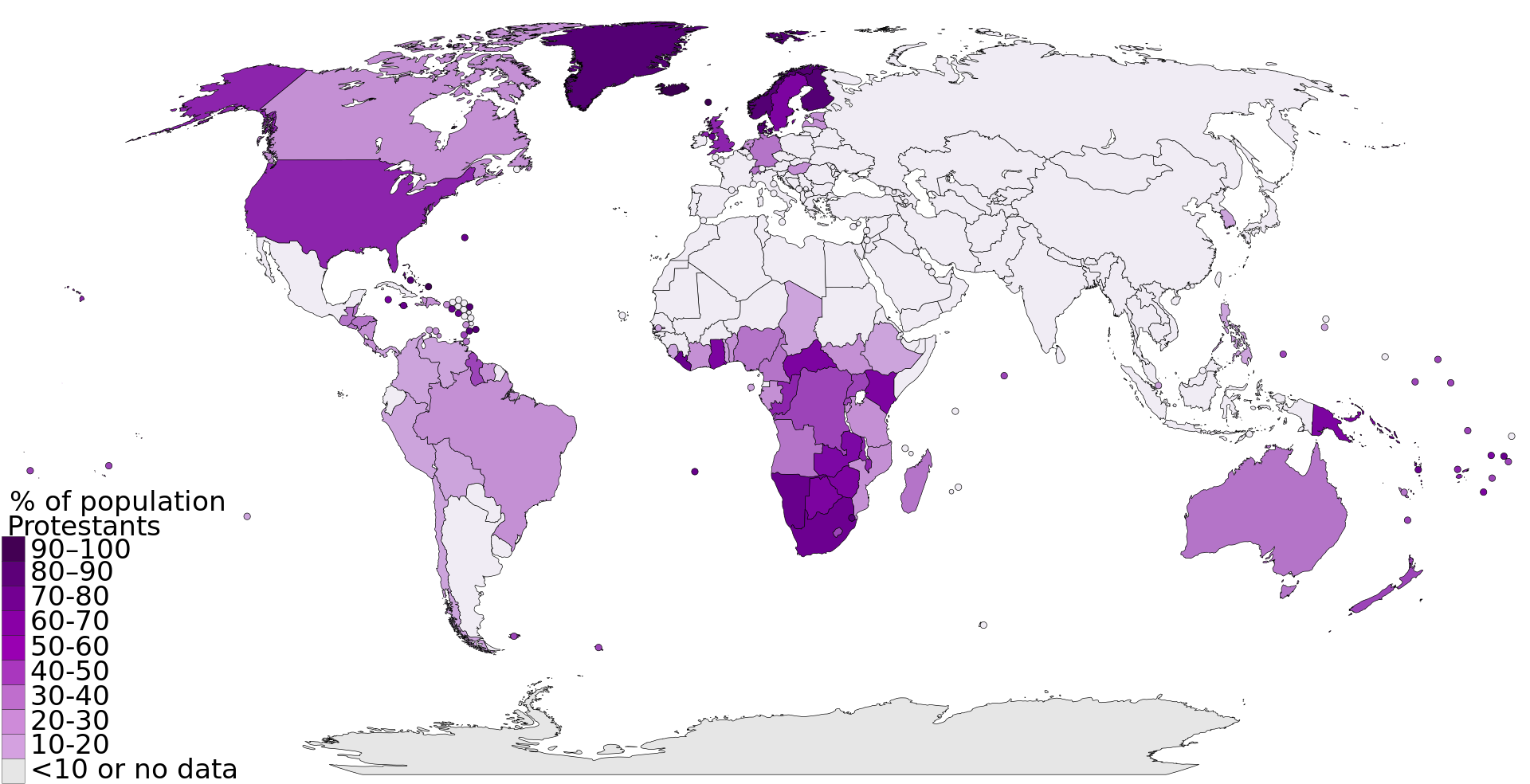 Worldwide Protestantism in 2010 Luther made effective use of Johannes Gutenberg's printing press to spread his views. He switched from Latin to German in his writing to appeal to a broader audience. Between 1500 and 1530, Luther's works represented one fifth of all materials printed in Germany.[280] In the 1530s and 1540s, printed images of Luther that emphasized his monumental size were crucial to the spread of Protestantism. In contrast to images of frail Catholic saints, Luther was presented as a stout man with a "double chin, strong mouth, piercing deep-set eyes, fleshy face, and squat neck." He was shown to be physically imposing, an equal in stature to the secular German princes with whom he would join forces to spread Lutheranism. His large body also let the viewer know that he did not shun earthly pleasures like drinking—behavior that was a stark contrast to the ascetic life of the medieval religious orders. Images from this period include the woodcuts by Hans Brosamer (1530) and Lucas Cranach the Elder and Lucas Cranach the Younger (1546).[281] Luther Monument in Eisenach, Germany Luther is honoured on 18 February with a commemoration in the Lutheran Calendar of Saints and in the Episcopal (United States) Calendar of Saints. In the Church of England's Calendar of Saints he is commemorated on 31 October.[282] Luther is honored in various ways by Christian traditions coming out directly from the Protestant Reformation, i.e. Lutheranism, the Reformed tradition, and Anglicanism. Branches of Protestantism that emerged afterwards vary in their remembrance and veneration of Luther, ranging from a complete lack of a single mention of him to a commemoration almost comparable to the way Lutherans commemorate and remember his persona. There is no known condemnation of Luther by Protestants themselves. Martin Luther College in New Ulm, Minnesota, United States Various sites both inside and outside Germany (supposedly) visited by Martin Luther throughout his lifetime commemorate it with local memorials. Saxony-Anhalt has two towns officially named after Luther, Lutherstadt Eisleben and Lutherstadt Wittenberg. Mansfeld is sometimes called Mansfeld-Lutherstadt, although the state government has not decided to put the Lutherstadt suffix in its official name. Reformation Day commemorates the publication of the Ninety-five Theses in 1517 by Martin Luther; it has been historically important in the following European entities. It is a civic holiday in the German states of Brandenburg, Mecklenburg-Vorpommern, Saxony, Saxony-Anhalt, Thuringia, Schleswig-Holstein and Hamburg. Two further states (Lower Saxony and Bremen) are pending a vote on introducing it. Slovenia celebrates it because of the profound contribution of the Reformation to its culture. Austria allows Protestant children not to go to school that day, and Protestant workers have a right to leave work in order to participate in a church service. Switzerland celebrates the holiday on the first Sunday after 31 October. It is also celebrated elsewhere around the world. |
遺産と記念 2010年の世界的プロテスタント ルターは、ヨハネス・グーテンベルクの印刷機を有効に利用して、自らの見解を広めた。彼は、より多くの読者にアピールするために、著作をラテン語からドイ ツ語に切り替えた。1500年から1530年にかけて、ルターの著作はドイツで印刷されたすべての印刷物の5分の1を占めた[280]。 1530年代から1540年代にかけて、ルターの巨大さを強調した印刷物のイメージは、プロテスタンティズムの普及にとって極めて重要であった。か弱いカ トリックの聖人のイメージとは対照的に、ルターは「二重あご、強い口、突き刺すような深い目、肉付きのよい顔、しゃんとした首」を持つがっしりとした男と して描かれた。彼は、ルター派を広めるために力を合わせることになる世俗的なドイツの王子たちと同等の体格を持つ、堂々とした人物として描かれていた。中 世の修道会の禁欲的な生活とは対照的である。この時期の作品には、ハンス・ブローザマーによる木版画(1530年)や、長老ルーカス・クラナッハと若き ルーカス・クラナッハによる木版画(1546年)などがある[281]。 ドイツ、アイゼナハのルター記念碑 ルターは、ルター派の聖人暦とエピスコパル(アメリカ合衆国)の聖人暦において、2月18日に記念祭が行われる。イングランド国教会の聖人暦では、ルター は10月31日に記念されている[282]。ルターは、プロテスタント宗教改革から直接生まれたキリスト教の伝統、すなわちルター派、改革派の伝統、およ び英国国教会により、さまざまな形で称えられている。その後に生まれたプロテスタンティズムの諸派は、ルターに関する言及が全くないものから、ルター派が ルターの人格を記念し記憶する方法にほぼ匹敵するような記念を行うものまで、ルターに対する記憶と崇敬において様々である。プロテスタント自身によるル ターへの非難は知られていない。 米国ミネソタ州ニューウルムにあるマルティン・ルター・カレッジ マルティン・ルターが生涯を通じて訪れた(とされる)ドイツ内外のさまざまな場所には、地元の記念碑が建てられている。ザクセン=アンハルト州には、ル ターにちなんで公式に命名された2つの町、ルターシュタット・アイスレーベンとルターシュタット・ヴィッテンベルクがある。マンスフェルトはマンスフェル ト・ルターシュタットと呼ばれることもあるが、州政府は正式名称にルターシュタットという接尾辞をつけることを決定していない。 宗教改革記念日は、1517年にマルティン・ルターが九十五ヶ条の論題を発表したことを記念する日である。ドイツのブランデンブルク州、メクレンブルク= フォアポンメルン州、ザクセン州、ザクセン=アンハルト州、チューリンゲン州、シュレースヴィヒ=ホルシュタイン州、ハンブルク州では市民の祝日となって いる。さらに2つの州(ニーダーザクセン州とブレーメン州)が導入の投票を保留している。スロベニアは、宗教改革が自国の文化に大きく貢献したことから、 宗教改革記念日を祝っている。オーストリアでは、プロテスタントの子どもはその日学校に行かないことができ、プロテスタントの労働者は教会の礼拝に参加す るために仕事を離れる権利がある。スイスは10月31日以降の最初の日曜日に祝日を祝う。世界各地でも祝われている。 |
Luther and the swan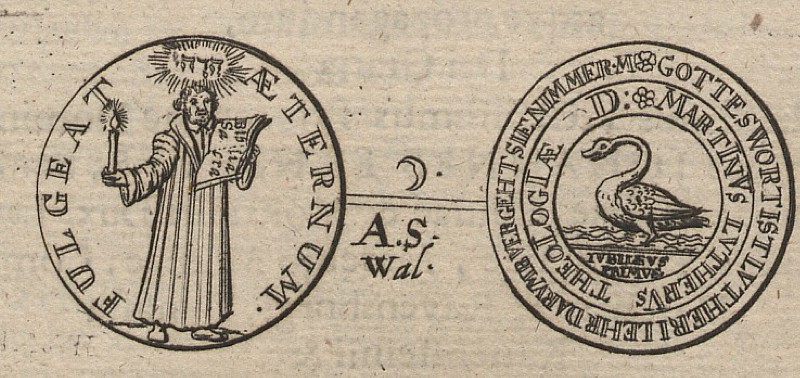 Luther is often depicted with a swan as his attribute, and Lutheran churches often have a swan for a weather vane. This association with the swan arises out of a prophecy reportedly made by the earlier reformer Jan Hus from Bohemia and endorsed by Luther. In the Bohemian language (now Czech), Hus's name meant "grey goose". In 1414, while imprisoned by the Council of Constance and anticipating his execution by burning for heresy, Hus prophesied, "Now they will roast a goose, but in a hundred years' time they'll hear a swan sing. They'd better listen to him." Luther published his Ninety-five Theses some 103 years later.[283][284][285] |
ルターと白鳥 ルターはしばしば白鳥を自分の属性として描いており、ルター派の教会には風見鶏に白鳥が描かれていることが多い。この白鳥との結びつきは、ボヘミア出身の 改革者ヤン・フスが、ルターのお墨付きを得たとされる予言に由来する。ボヘミア語(現在のチェコ語)では、フスの名前は「灰色のガチョウ」を意味してい た。1414年、コンスタンツ公会議によって投獄され、異端として火刑に処されることを予期していたフスは、こう予言した。「今はガチョウの丸焼きだが、 100年後には白鳥の鳴き声が聞こえるだろう。彼の言うことに耳を傾けた方がいい」。ルターはそれから約103年後に「95ヶ条の論題」を発表した [283][284][285]。 |
| Works and editions Main article: Martin Luther bibliography Various books of the Weimar Edition of Luther's works The Erlangen Edition (Erlangener Ausgabe: "EA"), comprising the Exegetica opera latina – Latin exegetical works of Luther. The Weimar Edition (Weimarer Ausgabe) is the exhaustive, standard German edition of Luther's Latin and German works, indicated by the abbreviation "WA". This is continued into "WA Br" Weimarer Ausgabe, Briefwechsel (correspondence), "WA Tr" Weimarer Ausgabe, Tischreden (tabletalk) and "WA DB" Weimarer Ausgabe, Deutsche Bibel (German Bible). The American Edition (Luther's Works) is the most extensive English translation of Luther's writings, indicated either by the abbreviation "LW" or "AE". The first 55 volumes were published 1955–1986, and a twenty-volume extension (vols. 56–75) is planned of which volumes 58, 60, and 68 have appeared thus far. |
作品とエディション 主な記事 マルティン・ルター書誌 ワイマール版ルター著作集各種 エルランゲン版(Erlangener Ausgabe: "EA")は、ルターのラテン語釈義書『Exegetica opera latina』から成る。 ワイマール版(Weimarer Ausgabe)は、ルターのラテン語とドイツ語の著作を網羅した標準的なドイツ語版で、「WA」の略号で示されている。WA Br" Weimarer Ausgabe, Briefwechsel (correspondence), "WA Tr" Weimarer Ausgabe, Tischreden (tabletalk), "WA DB" Weimarer Ausgabe, Deutsche Bibel (German Bible)と続く。 アメリカ版(ルター著作集)は、ルターの著作の最も広範な英訳であり、"LW "または "AE "の略号で示されている。最初の55巻は1955年から1986年にかけて出版され、現在までに58巻、60巻、68巻が出版されている。 |
| Antilegomena George of Hungary Luther's canon Luther's Marian theology Lutherhaus Eisenach Martin Luther's Birth House Propaganda during the Reformation Protestantism in Germany Resources about Martin Luther Theology of Martin Luther Bruder Martin Hochstratus Ovans Theologia Germanica |
アンチレゴメナ ハンガリーのジョージ ルターのカノン ルターのマリア神学 ルターハウス・アイゼナハ マルティン・ルターの生家 宗教改革期のプロパガンダ ドイツのプロテスタント マルティン・ルターに関する資料 マルティン・ルターの神学 マルティン・ルター ホッホストラトゥス・オヴァンス ドイツ神学 |
| https://en.wikipedia.org/wiki/Martin_Luther |
★ 「マルティン・ ルターと宗教改革」10 「賛美歌と木版画」より
「ヴァ ルトブルク城に匿われたルターが新約聖書のドイツ語訳に専念している間にも、熱心な弟子たちの活動によって、彼の教えは各地に浸透していった。もちろん書 物の果たした役割は大きかった(ドイツで刊行された書物は、1519年には111点だったが、1523年には約500点に増えた。その8割が宗教改革関連 の本だった)が、それでも、ライン河沿岸の先進都市でさえ読者層は限られていた。そこで他の布教方法も採用された。音楽や絵画である。これらは、文字の読 めない民衆の心をとらえるうえで効果的だった」。
「1523 年には、ルターの作ったドイツ語の賛美歌が紙に貼られ、町から町へと歌い継がれていった。それまで聖歌隊のみによって歌われていた賛美歌が一般の参列者に も歌われるようになったのは、礼拝において民衆がただ聞き手となるばかりでなく積極的に参加できるように、また文字を読めない者たちにも賛美歌を通じて教 えを伝えられるように、との配慮からである。ルターはその音楽的素養を発揮して多くの賛美歌を作ったが、彼の作品とされる賛美歌36篇のうち24篇が、ル ター派の進展著しかった1523年と1524年に作られていることからみても、彼が歌の持つ力をよく理解し、民衆の精神生活の一助として利用しようとした ことが窺える。ルターの賛美歌は、彼の聖書以上に幅広い層に強い影響を及ぼしたと言えるだろう。ちなみにルターの作ったもっとも有名な賛美歌は「神はわが やぐら」。1527年の作で、初期のプロテスタントに革命歌として歌われたが、後にバッハがこの賛美歌を用いたカンタータを作ることになる。しかし、暗い 歴史も背負っている。1930年代、ナチスはドイツ的キリスト教の確立に向けた大衆運動を推進したが、その時ドイツにおけるキリスト教の英雄としてルター を担ぎ上げた。そして、示威活動の一環として街中を練り歩くとき、「神はわがやぐら」を自分たちの行進歌として利用したのである。」
「ル ターのリュート伴奏に合わせて歌う彼の子どもたち」ライプツィヒ造形美術館
https://julius-caesar1958.amebaownd.com/posts/8740660/
★ ルターのメディア戦略
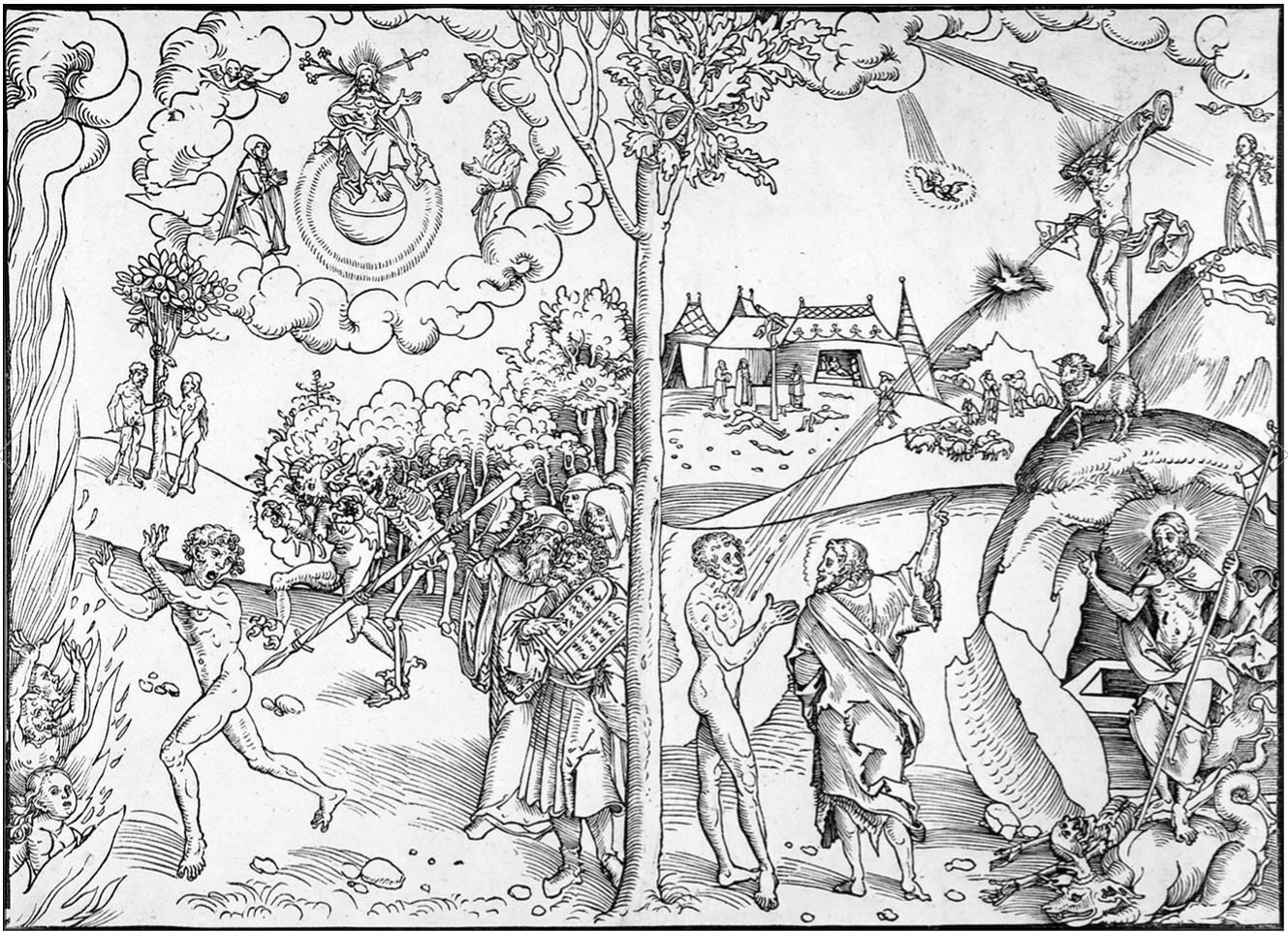
「ル ター自身の肖像画も、廉価版で大量に出回った。民衆がルターを聖人視することも稀ではなく、「ルターはいかなる罪も免れている」と公言する者さえいた (「偶像崇拝」の誘惑は、人間にとってなんと根深いものだろうか!その誘惑から自由になるには、己の内面の闇と向き合い続けることを通して人間をリアルに 把握するしかないように思うのだが)。対照的に、カトリックの聖職者たちは辛辣な風刺の対象となり、無知な高位聖職者、強欲で好色な修道士、反キリストの 教皇、信者たちを顧みない性悪な司祭などの姿が、数限りない図版に描かれていった。こうした図版は、民衆に改革理念を伝えるために利用されたパンフレット やビラに木版画として多用された。例えば、ルターにウォルムス勅令が発せられた時期に発行された「キリストの受難とアンチ・キリストの受難」というパンフ レット。それは13対の小木版画(12㎝×9.6㎝)の下に10行足らずの文章が付されたものだが、キリストの生涯の一場面とアンチ・キリスト=教皇の生 活をそれぞれ対比させ、厳しい教皇批判を展開したものだった。」
ルー
カス・クラナッハ「律法と福音」ゲルマン国立博物館 ニュルンベルク
絵の中央に一本の木が描かれ、左右に二分された部分絵が対比されている。左側の木の枝には葉が一枚もないのに対し、右側の枝には青々と茂る葉が描かれ、
左側が旧約の世界、ひいてはカトリックの世界、死を暗示しており、右側が新約の世界で、ルターの教え(信仰義認論)、生を伝えている。
リ ンク
文 献
そ の他の情報
Copyleft, CC, Mitzub'ixi Quq Chi'j, 1996-2099
☆ ☆
☆